DESIGNING A MORE MODERN AND VERSATILE WEARABLE INJECTOR
UNLOCKING OPPORTUNITIES IN ON-BODY DELIVERY SYSTEMS

DESIGNING A MORE MODERN AND VERSATILE WEARABLE INJECTOR
UNLOCKING OPPORTUNITIES IN ON-BODY DELIVERY SYSTEMS
TRUST THE PROGRESS: INTRODUCING AUTOMATION TO ENHANCE MANUFACTURING
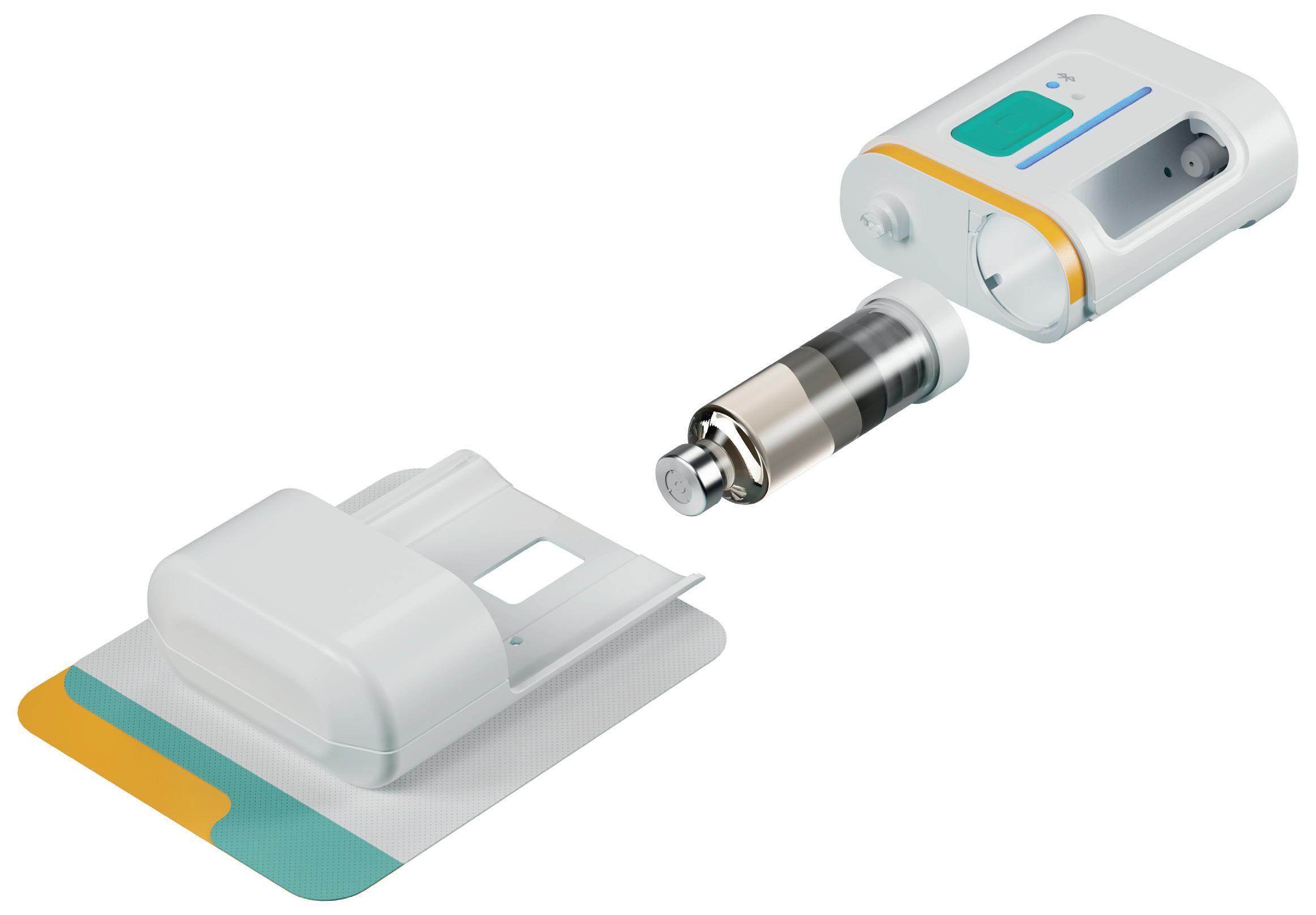



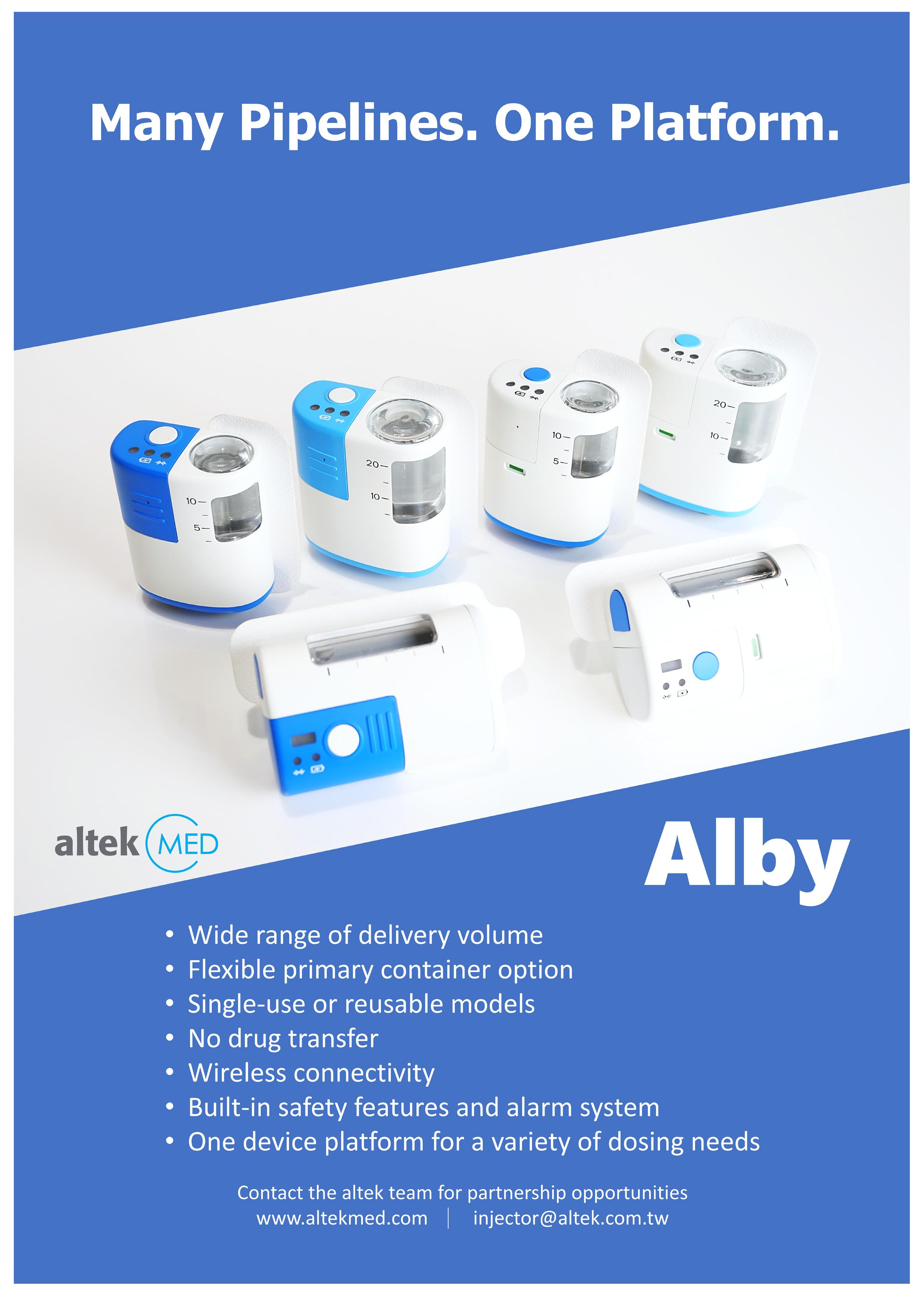
ONdrugDelivery Issue No 164, September 10th, 2024
WEARABLE INJECTORS
This edition is one in the ONdrugDelivery series of publications. Each issue focuses on a specific topic within the field of drug delivery, and is supported by industry leaders in that field.
EDITORIAL CALENDAR 2024/25
Sep/Oct 2024 Drug Delivery & Environmental Sustainability
Oct Prefilled Syringes & Injection Devices
Nov Pulmonary & Nasal Drug Delivery
Dec Connecting Drug Delivery
Jan 2025 Prefilled Syringes & Injection Devices
Feb Skin Drug Delivery: Dermal, Transdermal & Microneedles
Mar Ophthalmic Drug Delivery
Apr Pulmonary & Nasal Drug Delivery
Apr/May Drug Delivery & Environmental Sustainability
May Injectable Drug Delivery: Formulations & Devices
May/Jun Oral Drug Delivery
Jun Connecting Drug Delivery
Jun/Jul Industrialising Drug Delivery
Sep Wearable Injectors
EDITORIAL:
James Arnold, Editor
E: james.arnold@ondrugdelivery.com
CREATIVE DESIGN:
Simon Smith, Head of Creative E: simon.smith@ondrugdelivery.com
SUBSCRIPTIONS:
Print + Digital subscription: £99/year + postage
Digital Only subscription: free. E: subscriptions@ondrugdelivery.com
ADVERTISING & SPONSORSHIP: Guy Furness, Publisher E: guy.furness@ondrugdelivery.com
ONdrugDelivery is published by Frederick Furness Publishing Ltd
The Candlemakers, West Street, Lewes East Sussex, BN7 2NZ, United Kingdom T: +44 1273 47 28 28
Registered in England: Company No 8348388 ISSN 2049-145X print / ISSN 2049-1468 pdf
Copyright © 2024 Frederick Furness Publishing Ltd

ONdrugDelivery Magazine is printed sustainably by Newman Thomson Ltd, West Sussex, UK, using Forest Stewardship Council® certified recycled paper, vegetable-based inks, biodegradable laminates and carbon balanced materials offset via the World Land Trust™ following ISO140001 processes. ONdrugDelivery in print is sustainably shipped to events by DHL using GoGreen Plus whereby carbon insetting of at least 30% is achieved through the use of Sustainable Aviation Fuel (SAF), a biofuel substitute for traditional jet fuel, produced from renewable sources such as vegetable oils, animal fats, waste products, and agricultural crops. The magazine is mailed to individual readers outside the UK by DHL using GoGreen, which offsets 100% of CO2 emissions.
information contained in this publication. The ONdrugDelivery logo is a registered trademark of Frederick Furness Publishing Ltd.
From Precision to Perfection: New On-Body Delivery System Testing Solutions
Peter Schmidt, Product Manager Medical/Pharma
ZwickRoell
The Specific Approach: The Advantage of Customisation for Wearable Delivery Systems
Dave Beckstoffer, Business Development Manager
Portescap
Technical Challenges During the Development of On-Body Injectors
Andrea Allmendinger, Chief Scientific Officer; Michael Adler, Director Drug Product Design; Carole Delauney, Senior Director Business Development; and Hanns-Christian Mahler, Chief Enablement Officer
ten23 health
Designing a More Versatile and Modern Wearable Device
Chaoyoung Lee, President; and Mike Stout, Head of Strategic Partnerships and Clinical Applications
TxSphere
Enhancing the Patient and Nurse Experience in Large-Volume Subcutaneous Drug Delivery
Omar Rahman, Medical Director, Medical Affairs
Enable Injections
Beth Faiman, Nurse Practitioner, Department of Hematology and Medical Oncology
Cleveland Clinic Taussig Cancer Institute
Lisa Gorski, Clinical Education Specialist/Clinical Nurse Specialist
Ascension at Home
Product Showcase: CCBio’s Quick Dose On-Body Injector
Jimmy Fan, Marketing Vice-President
CCBio
The Importance of User-Centric Design When Developing Devices for Home Use
Simon Bürdel, Industrial Design & Human Factors Expert; and Reza Abedian, Senior Medical Affairs Manager
Gerresheimer
Unlocking Opportunities in On-Body Delivery Systems Through a Platform Technology Approach
Anna Allegro, Product Manager Drug Delivery Systems; and Andrea Cuccato, Hardware Development Engineer
Stevanato Group
Symbioze®: Large-Volume On-Body Injector Platform Fostering Patients’ Experience
Cécile Gross, Global Category Manager, Parenteral; and Mark Tunkel, Global Category Director, Services
Nemera
Trust the Progress: Introducing Automation to Enhance On-Body Injector Manufacturing
Greg Moakes, Executive Vice-President New Business Development; and Tzach Sadi, Research Engineer
LTS Lohmann
Enabling Large-Volume Subcutaneous Injection with a Smart Wearable Injection Platform
Leonard Chu, Deputy Director AltekMED
Device Selection & Development Strategy
Design History File Development (Remediation)
Risk Management File Development (Remediation)
Regulatory Strategy & Submission
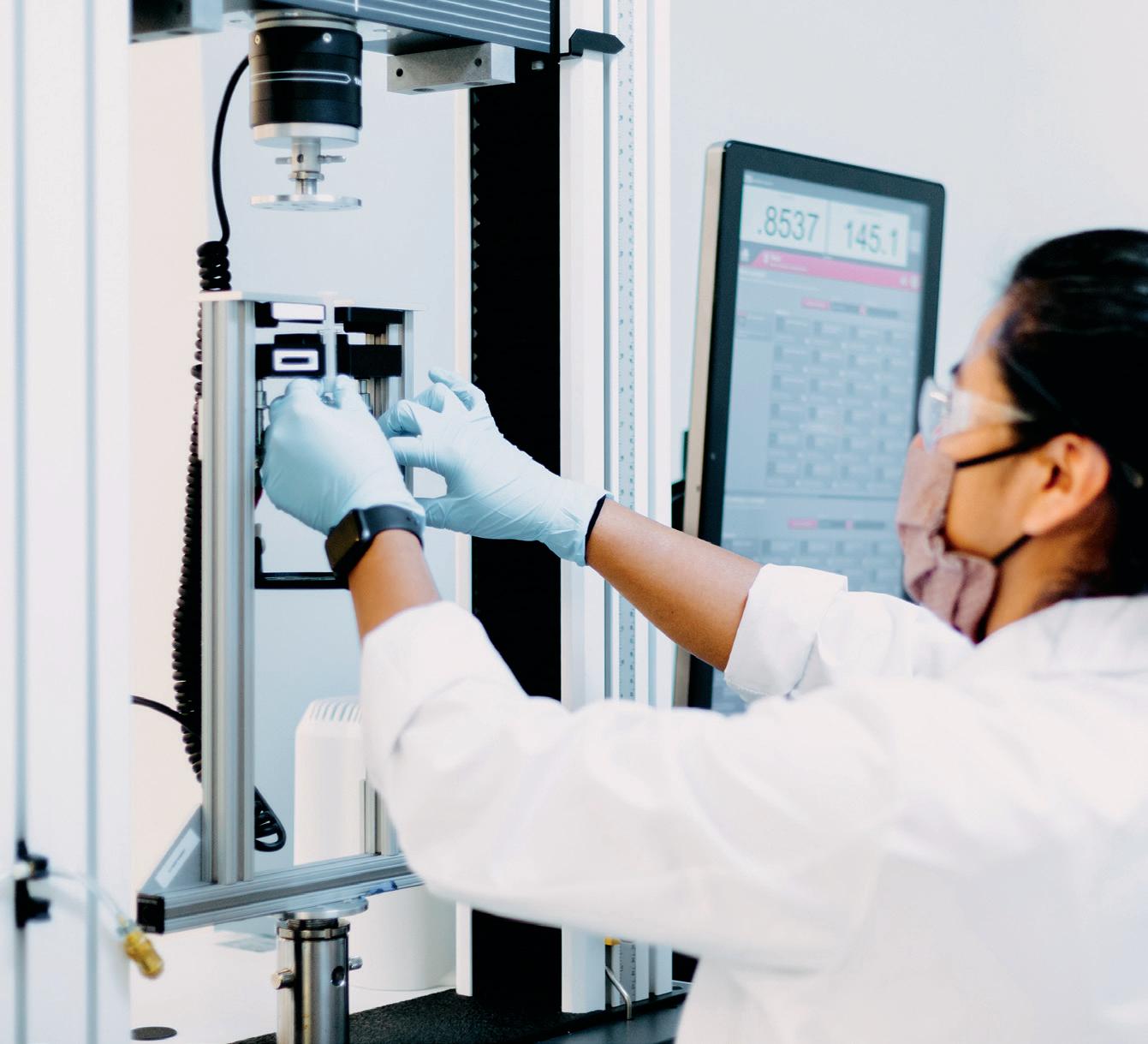
Authoring (FDA & CE) In House Combination Product Testing
Custom Fixture Development
Test Method Development & Validation
Verification & Validation Testing
Aging (Stability) Testing
Release Testing & Complaint Investigations
In this article, Peter Schmidt, Product Manager Medical/Pharma at ZwickRoell, details the advantages ZwickRoell’s integrated testing systems offer for ensuring precise and accurate testing of on-body drug delivery systems, including the prevention of static charge and the company’s advanced camera-based measurement systems.
In the medical industry, wearable injectors and on-body delivery systems (OBDSs) are playing an increasingly important role in the treatment of cancers, autoimmune diseases, rare diseases and neurological disorders. These devices offer a means to efficiently and precisely administer drugs in effective doses over longer periods of time, especially for patients who require regular injections (Figure 1).
ZwickRoell testing systems support and set new standards in standard-compliant testing for these drug delivery devices. The company’s systems provide users with
unique advantages for the development of both standard and automated testing systems, with a focus on reproducible, traceable results, as well as reliability, safety and efficiency.
ZwickRoell has installed nearly 200 autoinjector testing systems worldwide and is continuously working to further raise standards in OBDS testing as well. The administration of highly viscous biologics continues to pose a significant technical challenge to the industry, so OBDSs must be able to effectively handle drug reservoirs with volumes ranging from 2 mL to up
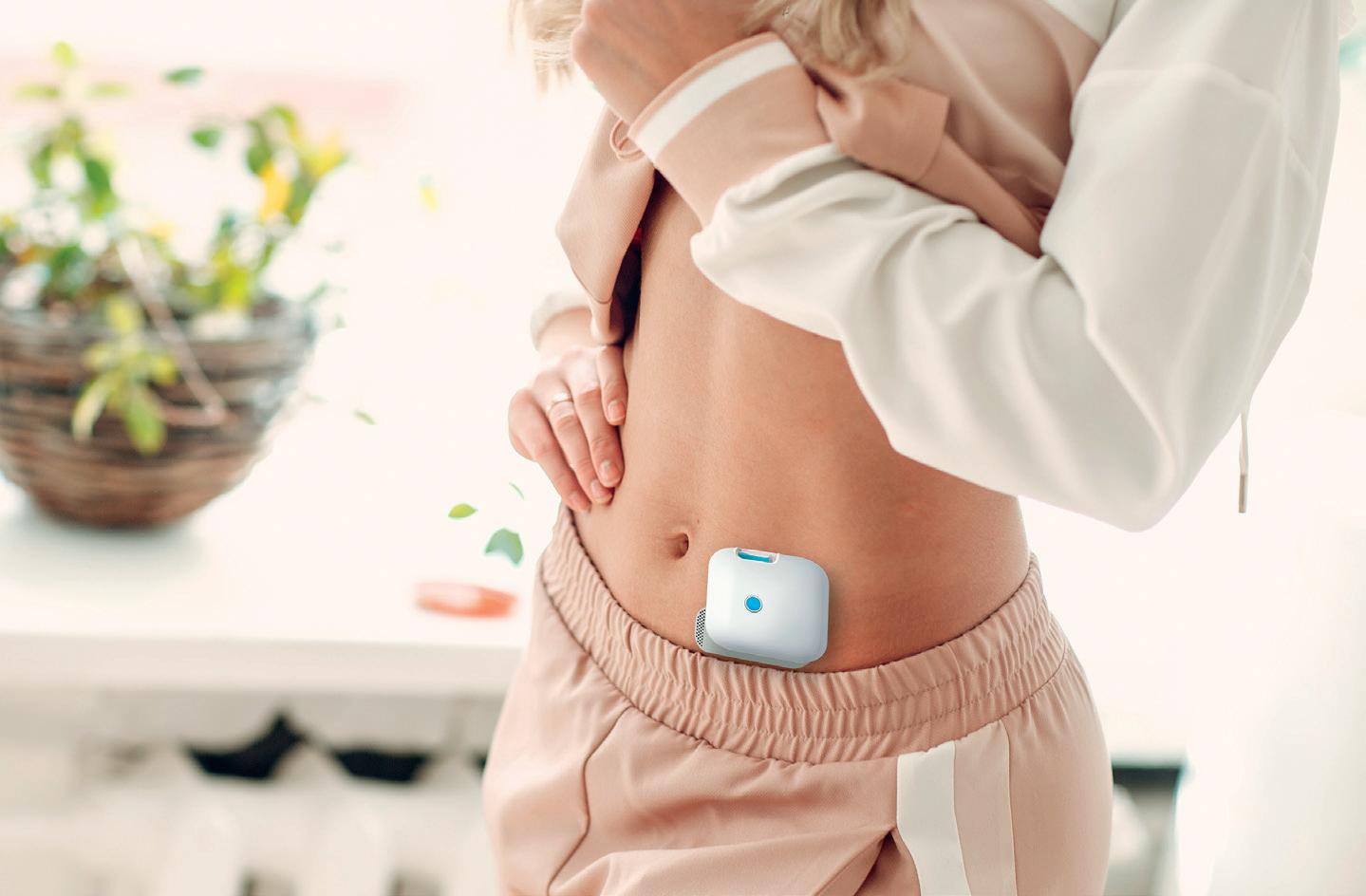

Peter Schmidt Product Manager Medical/Pharma E: peter.schmidt@zwickroell.com
ZwickRoell August-Nagel-Strasse 11 89079 Ulm
Germany
www.zwickroell.com/medical
“A unique feature of ZwickRoell’s testing systems is the ability to achieve sequential results on a single specimen.”
to more than 20 mL, and achieve delivery rates of 0.01 mL to over 60 mL per hour. These devices vary in their duration of use from minutes to several hours and often integrate advanced communication technologies, such as Bluetooth and nearfield communication (NFC), to improve patient care. These technical requirements emphasise the need for innovation in the design of wearable injectors, both in single-use and reusable systems.
A unique feature of ZwickRoell’s testing systems is the ability to achieve sequential results on a single specimen. As a result, all the necessary tests that were previously performed separately can now be carried out in a single, coherent test sequence. This not only saves time, but also reduces the number of inaccuracies caused by user influences, as the specimens do not have to be moved between different tests, thus guaranteeing traceable and reproducible results.
The injection of drugs, highly viscous drugs in particular, poses a number of technical challenges that must be carefully addressed to ensure their safety and effectiveness during treatment. A major challenge is the need to avoid static charge during the testing process, which can greatly impair the precision of the weighing results. In addition, the crystallisation of the drug upon contact with air poses a challenge. This clogging effect can sometimes also affect the administration itself. Equally problematic is the evaporation of the drug during the injection process, which can take
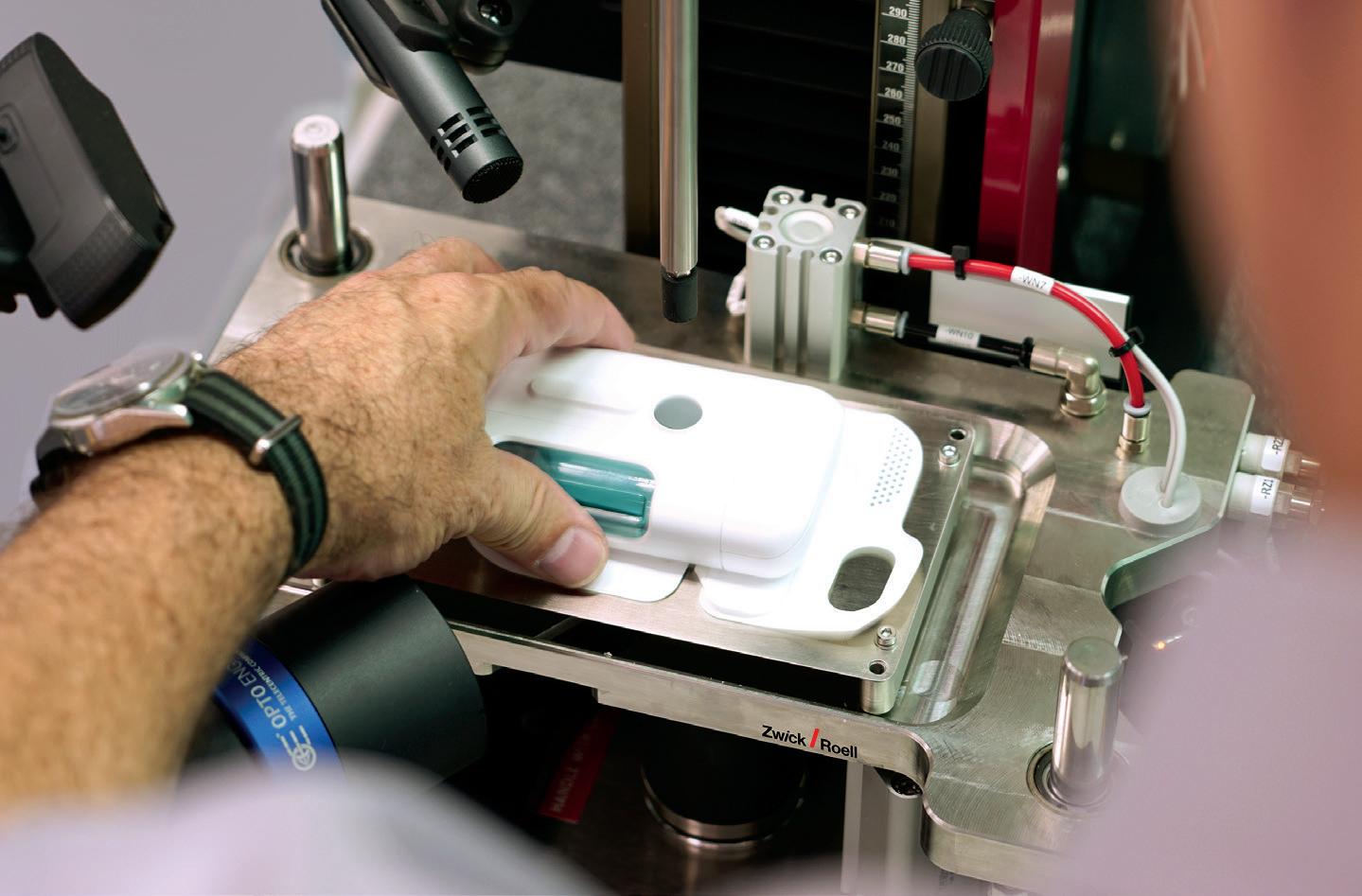
up to 60 minutes and can falsify the dosage. The OBDS testing system from ZwickRoell prevents these effects via a special test methodology employed throughout the entire testing process.
Highly accurate measurement of the injection depth is crucial for ensuring that the drug is applied exactly where it is needed in the body. Precise determination of the total injection volume, including the last drop, is equally important for guaranteeing the required dose for therapy and avoiding waste. These requirements call for advanced technologies and precise engineering to maximise effectiveness and patient safety.
Before each new test job, it is essential to check whether all the sensors used are working and providing reliable results. An error in the results chain can have fatal consequences for the quality of the results and, therefore, for production or delivery, creating significant additional costs for the development programme. As such, ZwickRoell offers easy-to-use and reliable daily check tools for all sensors used in the testing of autoinjectors to ensure systematic functional reliability before each
“ZwickRoell offers easy-to-use and reliable daily check tools for all sensors used in the testing of autoinjectors to ensure systematic functional reliability before each job and before each time a product to be tested is changed.”
job and before each time a product to be tested is changed. The daily check results are linked to the test programme and ensure that, in the case of a check failure, the test job cannot be performed.
Another highlight of ZwickRoell’s testing systems is the integrated, high-precision scale for obtaining extremely accurate test results. This precision is critical for determining the precise amount of the drug injected over the entire injection (injection profile) and for ensuring that the dosing meets all required standards. ZwickRoell has developed a sophisticated and clever solution to avoid falsification of results and thereby continually set high standards, including in the implementation of OBDS tests.
Camera-based measurement (VDX) is a revolutionary method for the precise recording of injection parameters (Figure 2). This system provides more accurate results than traditional methods as it is not affected by injection mist or spray. A key feature is the ability to measure injection depths for needle lengths between 2.5 mm and 15 mm with an impressive accuracy of less than ±0.05 mm. Additionally, it enables the measurement of the injection time with a minimum duration of less than ±0.05 seconds to record extremely fast injections, as is the case with emergency injectors.
Another advantage of this system is synchronised video capture, which enables the entire injection process to be visually documented and recorded synchronously with other measurement data. This is an integral part of the quality control measurement process. The unique ability to calibrate the camera-based system also increases the reliability of the test results. Flexible adjustment of the field of view also enables the width of the liquid injection angle to be recorded precisely, making this measuring system an indispensable tool.
ZwickRoell’s VDX system ensures precise monitoring and analysis of every phase of the injection, from activation of the injector to completion of delivery. The high-resolution camera provides detailed insights that are essential for calculating results, quality control and error analysis. This technology also enables all results to be recorded accurately and to immediately identify any deviations.
As well as standardised solutions, ZwickRoell also offers customised systems that can be quickly and flexibly tailored to meet a customer’s specific needs. The ability to quickly configure testing machines for different standard changes, testing requirements and methods, whether for research and development or quality control, makes these systems particularly flexible (Figure 3). This is why ZwickRoell’s development team works so closely with its customers – to make sure that their specific requirements are always met. Each solution aims to deliver the best possible modular structure and can therefore be individually adapted to a customer’s specific requirements,

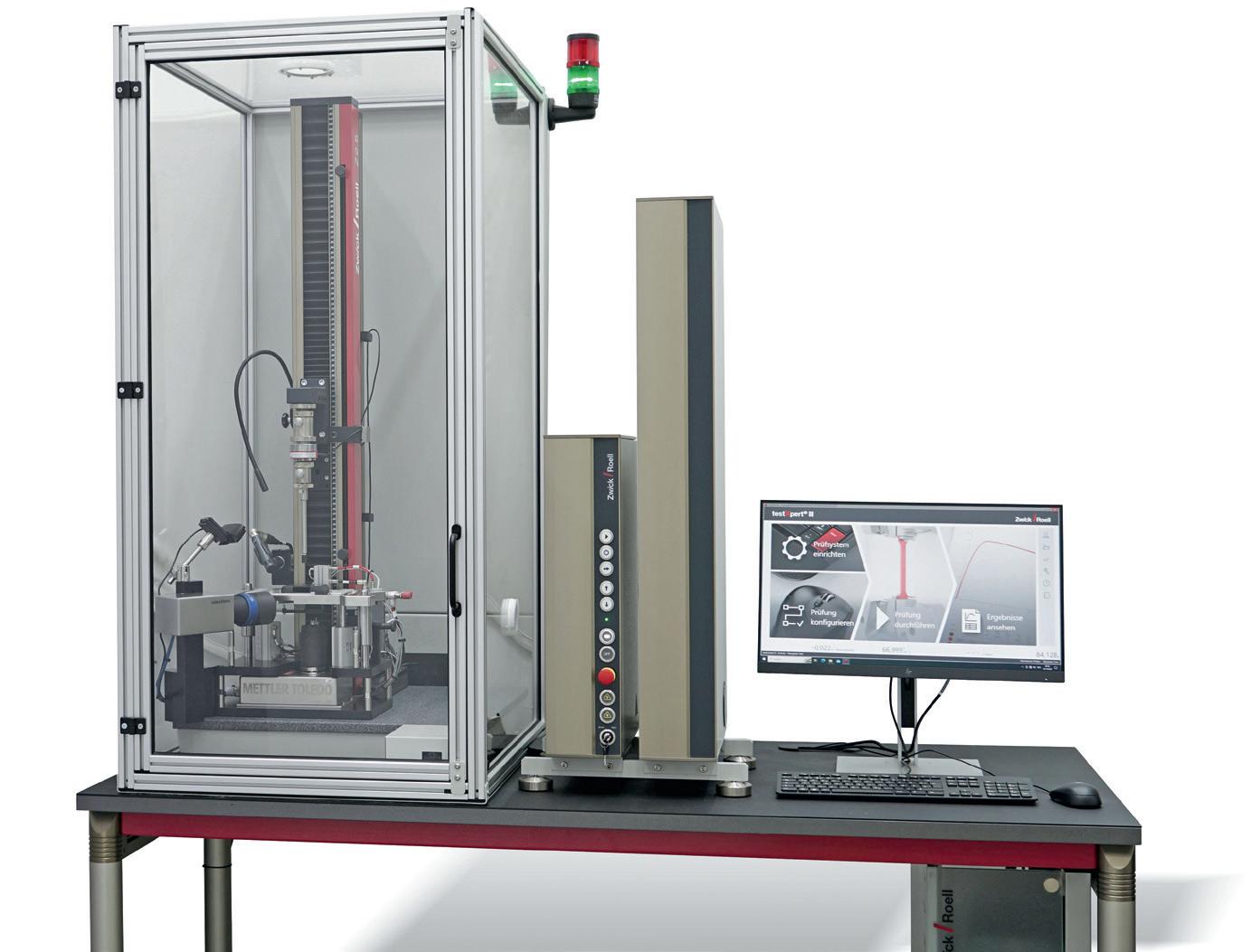
Figure 3: A modular set-up enables adaptation when changes are necessary.
“ZwickRoell’s VDX system ensures precise monitoring and analysis of every phase of the injection, from activation of the injector to completion of delivery.”
making them an ideal solution for a wide range of OBDS testing requirements. The systems cover any challenge that could possibly arise when testing OBDSs and, therefore, offer comprehensive solutions for the pharmaceutical industry.
ZwickRoell offers solutions for managing data as well as complying with legal requirements such as US FDA 21 CFR Part 11. The software package for testing injectors with ZwickRoell’s testXpert III software enables complete traceability and user management to ensure that all data is tamper-proof and cannot be altered (Figure 4). The integrity of the data and

user management are crucial for compliance with legal requirements and, consequently, the security of users and patients.
ZwickRoell is a materials testing system developer and manufacturer and a trusted partner for reliable test results. A fundamental requirement for reliable test results in materials and components testing is the perfect interaction among all testing machine components. For this reason, ZwickRoell develops and manufactures both the load frames and all main components itself. With 15 product groups and testing solutions for more than 20 industries, as well as support from the company’s approximately 1,900 employees representing over 50 countries, ZwickRoell is an expert partner in the field of materials testing.
Peter Schmidt , Product Manager Medical/Pharma for ZwickRoell, has several decades of experience in the pharmaceutical and medical technology industry. Mr Schmidt is a product specialist for testing solutions for injection devices and primary packing.







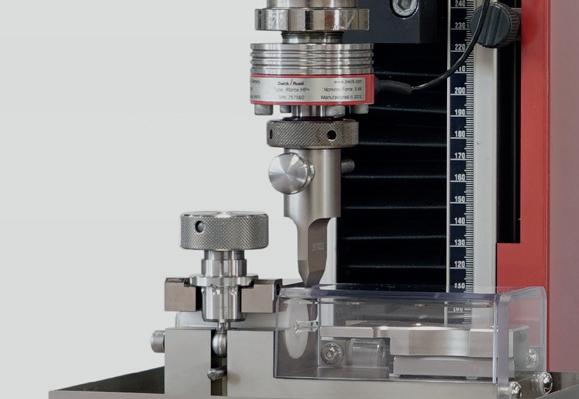






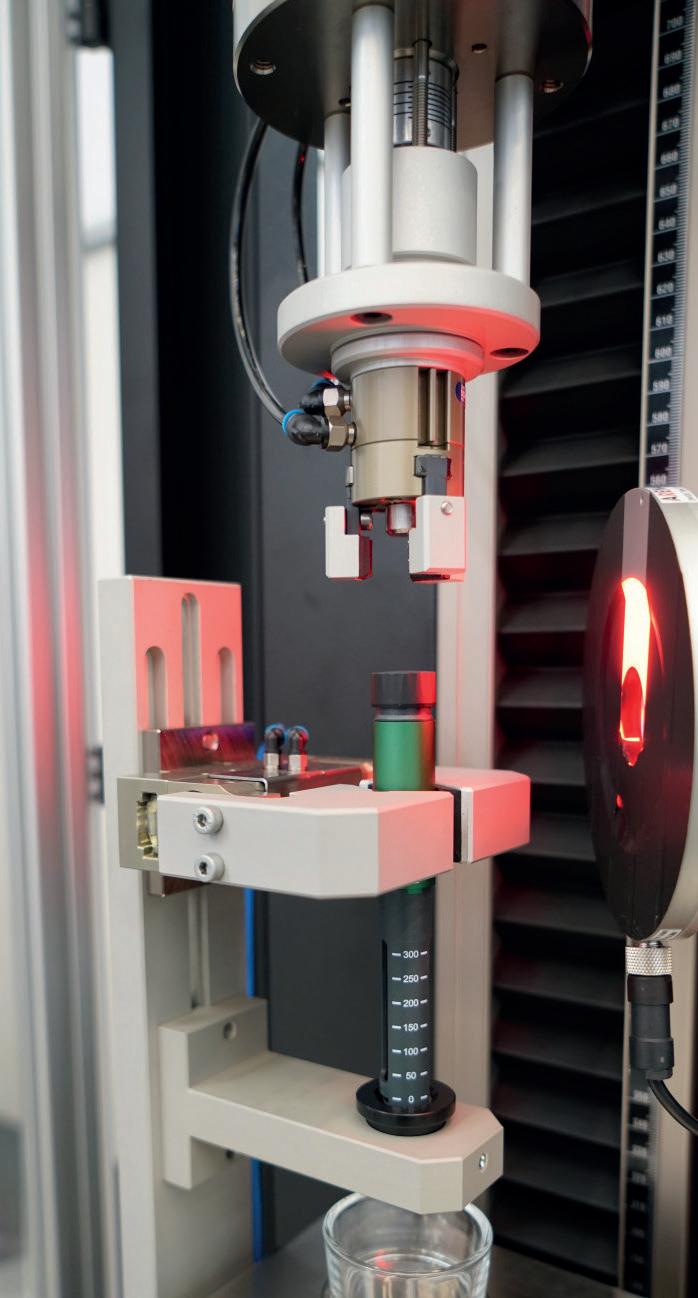









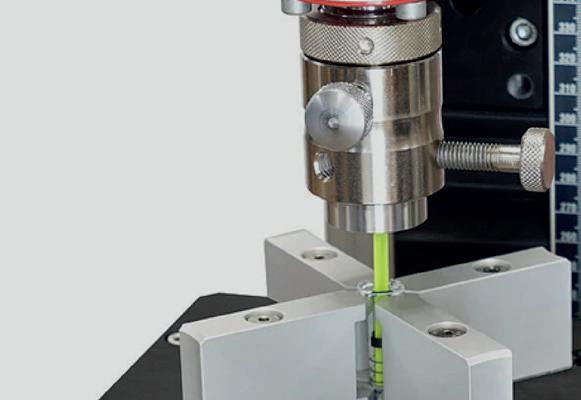

www.zwickroell.com/testxpo








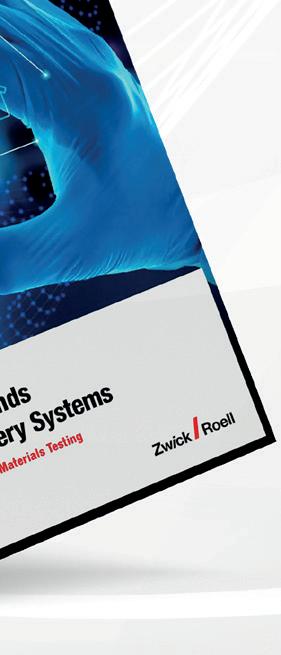









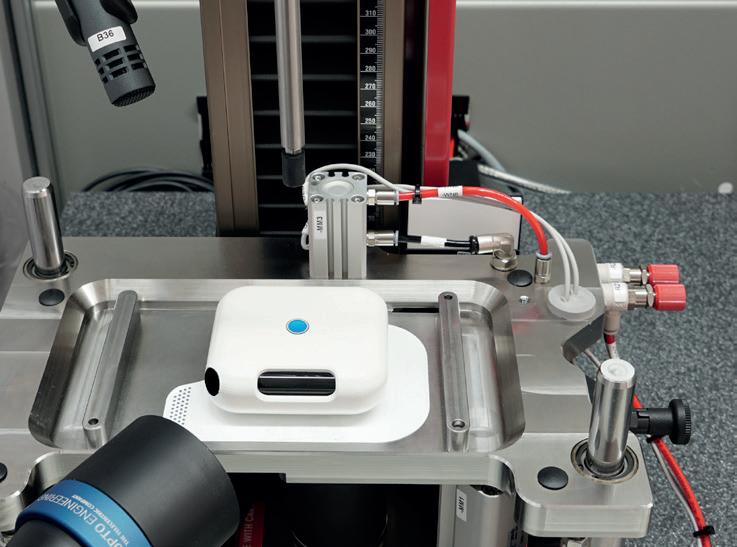


· Manual, semi-automatic and fully automated testing solutions for therapy systems (needles, (pre-filled) syringes, insulin pens, auto injectors) · Traceable and tamper-proof test results in accordance with FDA 21 CFR Part 11 · ZwickRoell supports customers with DQ, IQ and OQ services









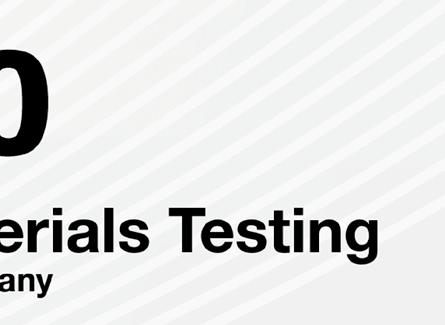





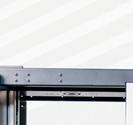
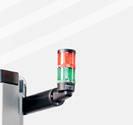




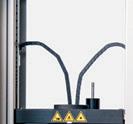
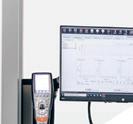
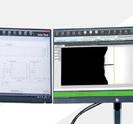




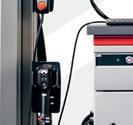



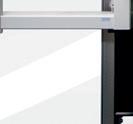










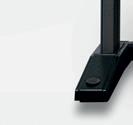

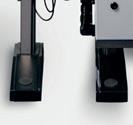










In this Expert View, Dave Beckstoffer, Business Development Manager at Portescap, considers how involving customisation from the outset of an on-body injector development project can not only optimise the patient outcome but also streamline the development timescale for device engineers, with a particular focus on the drive system.
In the arena of on-body injector and autoinjector development, more and more companies are creating devices that are paired one-to-one with a specific drug. While injector developers are still producing devices that can handle a range of different drugs, the advantage of developing a specific injector is in matching the unique therapy and patient profile to the given drug (Figure 1).
The demand from the pharmaceutical industry is for optimised drug delivery that is able to deliver improved drug efficacy. The expertise and timescales needed to create the latest, most effective drug treatments require high investment. In turn, optimising therapy efficacy demands the most appropriate delivery methodology.
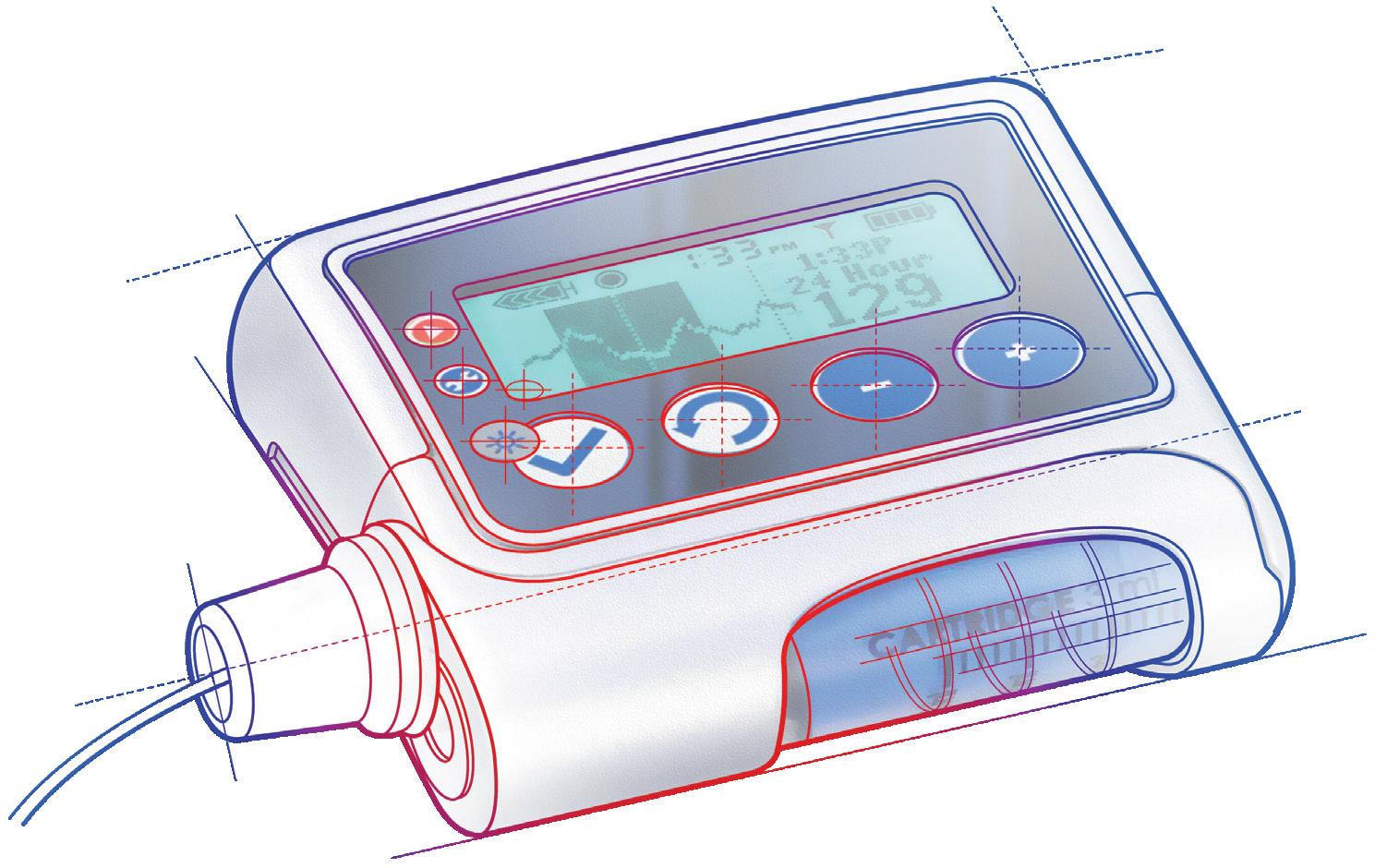
Figure 1: The capability of the delivery system must be customised to suit the drug and its delivery criteria.
As a result, the capability of the delivery system, based on an electric motor, a gear, a connecting actuator and, potentially, a feedback device, must also be customised to suit the drug and its delivery needs. Drugs that do not, relatively speaking, have the greatest need for volumetric precision, such as a diuretic like furosemide, could still be delivered by a generic device.
However, in the burgeoning market of biologics, precise delivery is often crucial to treatment efficacy and there might be less margin for error with respect
“While
to harmful overdosing. In these cases, customising the delivery system ensures precision over delivery force, dependent on drug viscosity and the injection time profile. Additionally, the frequency of administration and the total required lifespan of injector use are other key considerations.
While the growth in the biologics market has pushed the move towards customising delivery system designs specifically for individual drugs, the tendency to aim to standardise devices for subsequent or similar drug types can still remain.
A device developer might invest resources in establishing a customised delivery system for the first contracted drug or set of biologics but might then aim to use
the growth in the biologics market has pushed the move towards customising delivery system designs specifically for individual drugs, the tendency to aim to standardise devices for subsequent or similar drug types can still remain.”

Dave Beckstoffer
Business Development Manager
T: +1 540 230 9300
E: dave.beckstoffer@regalrexnord.com
Portescap
110 Westtown Road
West Chester PA 19382
United States
www.portescap.com
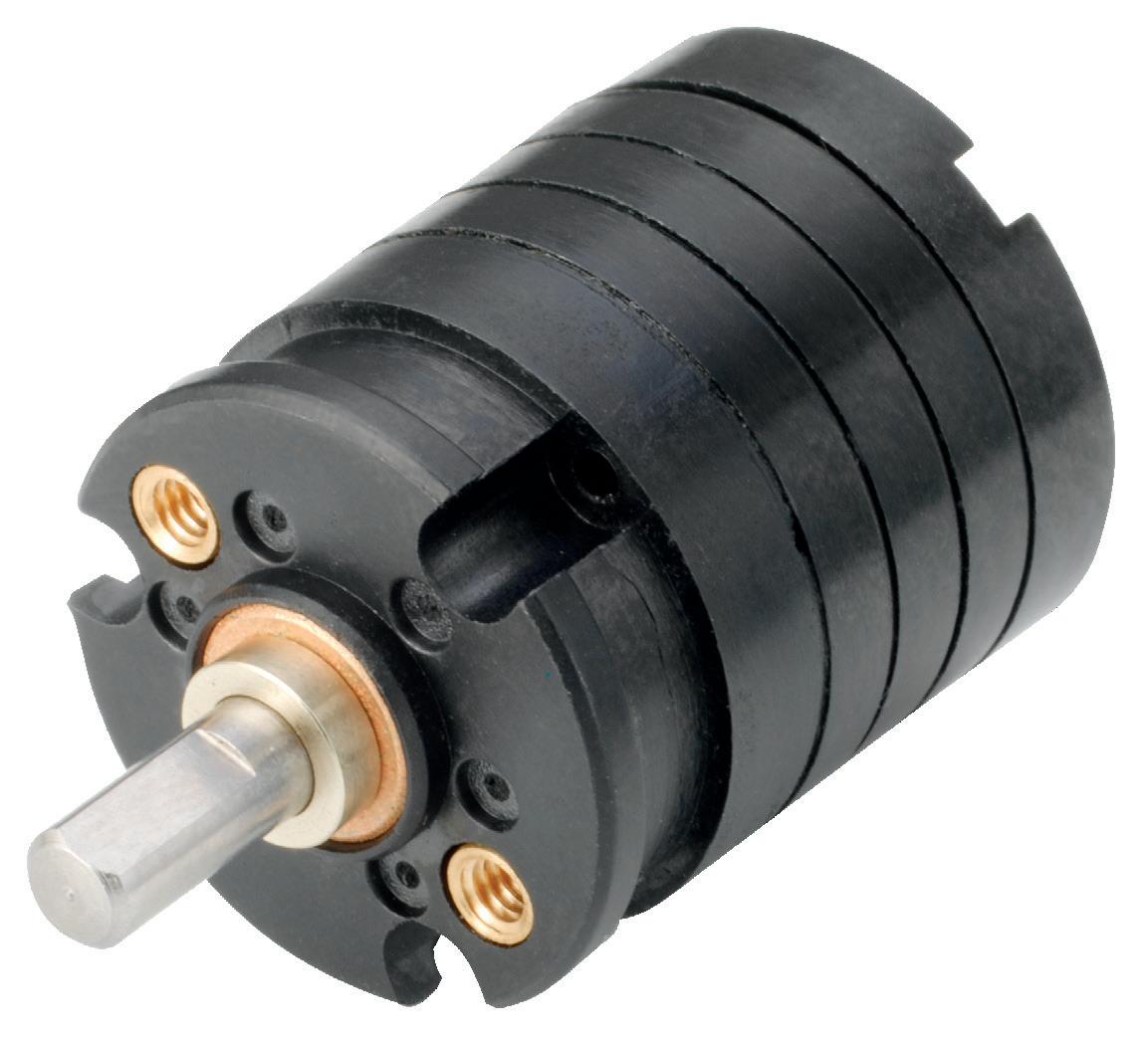
the original design as a platform across a broader range of drugs. In such cases, the outer portion of the device and the software can be tailored to each specific drug and therapy while the core delivery system remains the same.
Typically, this could mean adjusting the force to suit the viscosity, substituting the original motor and gear specification with an off-the-shelf selection of standard products. There is a logic to this approach, where repeating tried and tested designs, only making the necessary adjustments, can quickly achieve reliable results.
The danger, however, is moving too quickly with the redesign and neglecting important decisions that can impact wider aspects of the on-body injection device. This can result in the need for reworking later down the line, extending the overall project timescale.
Form factor is an important aspect that can be adversely impacted by abandoning the full range of customisation considerations at a premature stage or by moving directly to selection of off-the-shelf motors, gears and lead screws. By maintaining a customisation approach at the concept phase of every new project, a designer can make fine adjustments to the delivery system’s components; this enables them to adapt to different drug viscosities and delivery requirements as necessary, while also keeping the form factor and weight practically the same.
“The gearing system has the biggest impact on form factor and, if greater force is needed, customisation can achieve more specific ratios than off-the-shelf designs will usually provide.”
The gearing system has the biggest impact on form factor and, if greater force is needed, customisation can achieve more specific ratios than off-the-shelf designs will usually provide. For the most compact
footprint, the gear housing can also be modified to fit perfectly within the device architecture. A spur gear is typically preferred, as this arrangement allows an offset lead screw output, enabling an improved fit within the typical rectangular layout of an on-body injection device (Figure 2).
With the gear design optimised, the motor can also be customised to provide the required output characteristics while maintaining the desired footprint. While motor size might have to increase to meet output torque requirements, using alternative motor technologies could be advantageous should increasing the gear ratio alone not be sufficient. Switching from a brushed direct current (DC) motor to a brushless DC (BLDC) motor increases the speed potential, increasing the delivery capability while reducing the footprint for the equivalent output. Changing the motor technology can also be useful for handling different drug delivery profiles. For example, if the drug needs to be delivered rapidly, the higher speed of a BLDC design could be more appropriate. To achieve precise dosing and enable exact management of the delivery phase, the encoder pairing is also crucial, with careful consideration required for the feedback technology type and its resolution. Alternative technology could also be used in cases where the drug needs a delivery profile with fine, incremental volumes that are administered over a longer duration. In these cases, stepper motor technology might be preferable, which can be run open-loop, thereby focusing the feedback on the drug delivery (Figure 3).
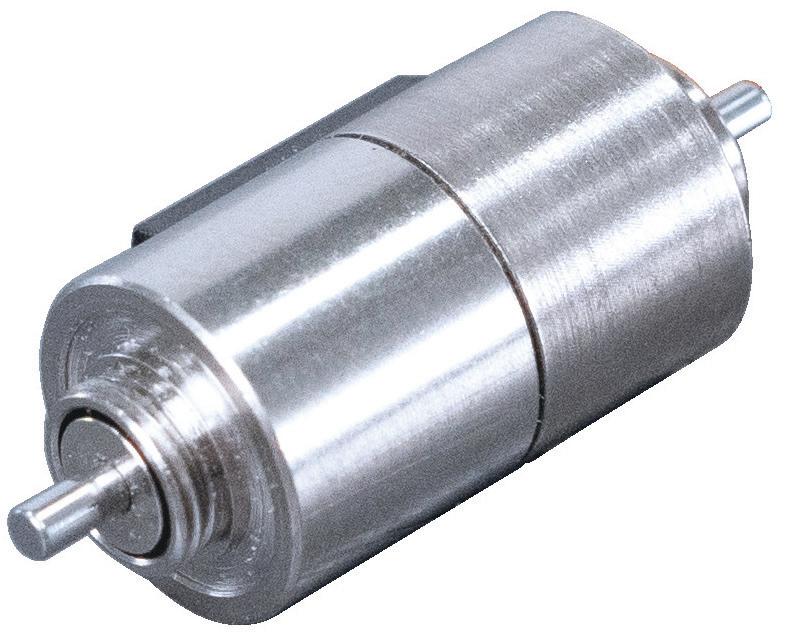

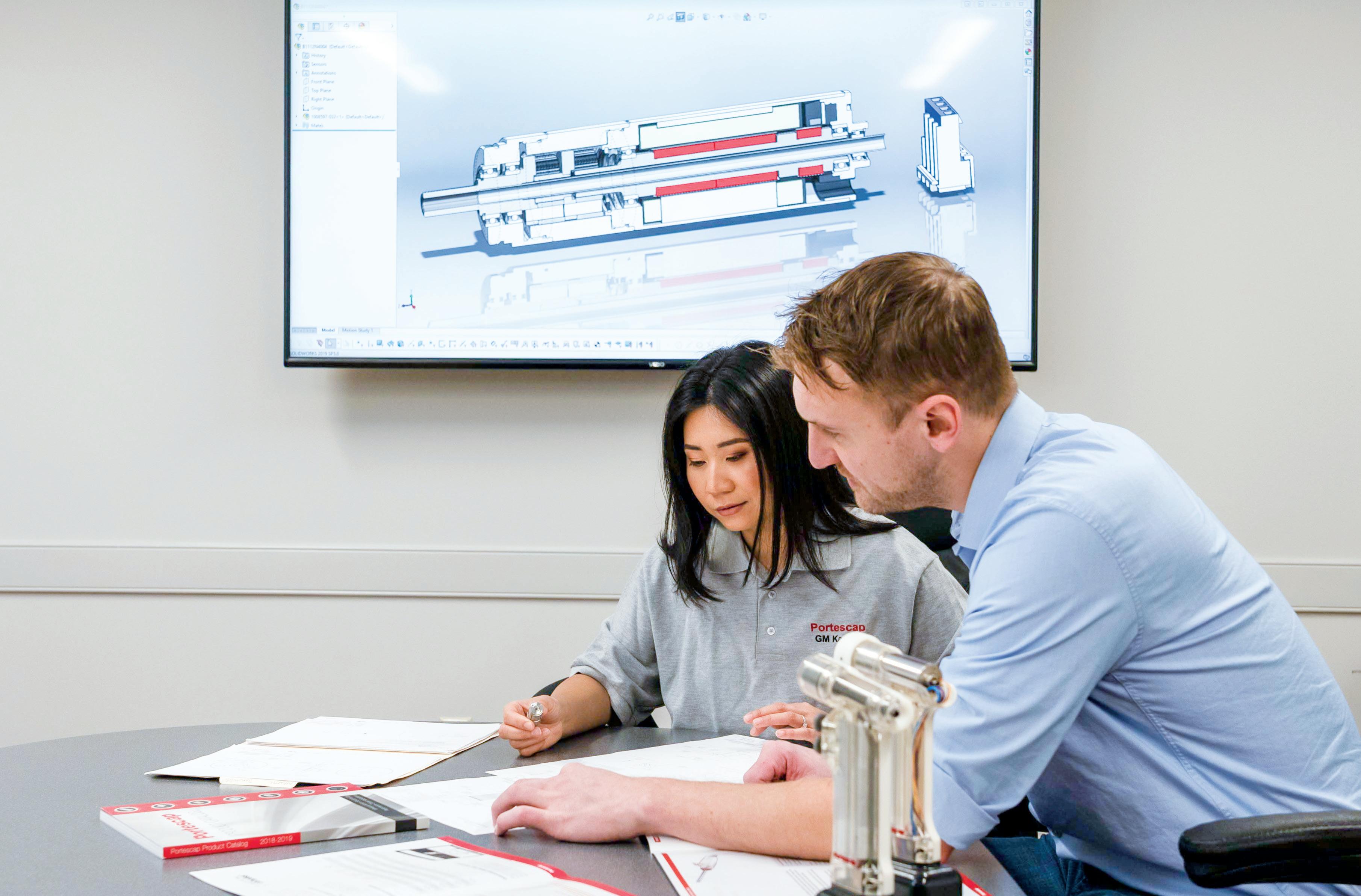
“In combination with the appropriate motor technology, a higher pitch could deliver several times the force capability from the same drive mechanism footprint.”
Consideration must also be made for the lead screw, with customisation options available for the diameter and pitch leading to an optimised system. This way, in combination with the appropriate motor technology, a higher pitch could deliver several times the force capability from the same drive mechanism footprint.
However, it is crucial to remember that changes to any one of the components can impact the output or footprint of the delivery system as a whole. This reiterates the point that any design changes should be considered, with due expertise, as early as possible in the design and development process (Figure 4).
From the patient perspective, energy efficiency is also crucial, and this is another area where involving motor engineering
expertise can offer an advantage. Although each drug has a specific therapy profile, the motor’s operation can be adjusted to match its optimal operation.
This is key because the duty cycle has a significant impact on motor efficiency, where high-speed operation for a short duration is generally more efficient than continuous low-speed operation. Take a drug delivery profile of six hours as an example – a motor could run for two seconds every minute at high speed and still achieve the same effective delivery profile as a continuous low-speed operation. This approach demands high precision in motor control but will result in a marked efficiency increase.
Paying close attention to duty cycle management in delivery system design can also improve another key area: lifespan. If a device designer assumes continuous duty operation, this could be a difference of hundreds of hours, or even several
thousand hours, down to just tens of hours of intermittent operation, spread over the required months or years of use. Considering materials selection, this means that specifying the most durable, and most expensive, options may not be necessary and sufficiently robust, yet significantly less expensive, materials could be used.
The other key advantage of using intermittent duty cycles to minimise the total required lifetime is the benefit to testing. Typically, a delivery system is tested for two cycles of its total lifespan –with a lifetime reduced from hundreds to tens of hours, the life testing duration can be significantly reduced. This time advantage can be used to test an additional range of parameters, as well as allowing testing to fail, enabling a more comprehensive test procedure that can result in a more reliable device long term.
“Paying close attention to duty cycle management in delivery system design can also improve another key area: lifespan.”
Optimising sustainability is another design aspect where customisation is looking to push boundaries. Specifically, there’s an increasing drive to convert disposable devices to reusable designs. Coinciding with the boom in weight loss drugs and GLP-1 receptor agonists, there’s significant waste with single-use syringes.
While improving the recyclability of materials is one option, there is also potential to look more closely at the balance of the drive mechanism profile with the
therapy profile, with the goal of increasing the lifespan that can be achieved for delivery devices. As a result, delivery system developers are creating cost-effective ways of converting disposable devices to reusable options, capable of delivering therapies for several years.
Whether developing a wearable drug delivery device to meet new trends, such as sustainability, or adapting an existing design to deliver a new drug, the role of the motor, gear, actuator and feedback
Dave Beckstoffer, Business Development Manager in the medical team at Portescap, has over 31 years of experience in the motion control industry. He brings a customerfocused mindset to every application, understanding the link between the end product features and the motion system design. Mr Beckstoffer leads the development of drive mechanisms tailored for the specific requirements of infusion systems, marrying motor, gearing and feedback technologies with multiple drug delivery methodologies to achieve the optimum design for each device.
system will be fundamental. Considering the significance of these components, it is important to ensure that all design considerations are covered as early as possible in the development cycle, starting from the concept phase. In so doing, the involvement of device customisation for each project can help to ensure that the optimal patient outcome can be realised, while development timescales can be minimised by reducing the potential for surprises to emerge during the later stages of a project.
Portescap, part of Regal Rexnord, offers a broad range of miniature and specialty motor products, including coreless brush DC, brushless DC, stepper can stack, gearheads, digital linear actuators and disc magnet technologies. Its products have served diverse motion control needs across a wide spectrum of applications for more than 70 years, including medical, life sciences, instrumentation, automation, aerospace and commercial.


Here, Andrea Allmendinger, PhD, Chief Scientific Officer, Michael Adler, PhD, Director Drug Product Design, Carole Delauney, Senior Director Business Development, and Hanns-Christian Mahler, PhD, Chief Enablement Officer, all at ten23 health, provide an overview of large-volume wearable injection devices for the subcutaneous delivery of biologics and discuss the technical challenges associated with the development and manufacturing of these drug/device combination products.
Today, biologics are increasingly being administered via subcutaneous (SC) injections. As such, demand has grown for high-volume delivery systems capable of injecting volumes larger than 1 mL and 2.25 mL, which are the typical container formats used in autoinjectors. Several factors are contributing to this trend, including therapeutic advantages, such as self-administration or caregiver assisted administration, that offer increased convenience in home or office settings and reducing hospital visits. This also reduces overall healthcare costs and offers scheduling flexibility – minimising capacity constraints. Unlike intravenous (IV) injections (with 100% bioavailability), SC administration typically results in lower bioavailability –around 60–80% for monoclonal antibodies (mAbs).1 Consequently, SC delivery often requires slightly higher doses than IV delivery and “fixed doses” are typically preferred. Traditionally, SC injections were believed to be limited to volumes up to 1 mL. However, the trend towards SC injections for “high-dose” products such as antibodies (in the range of up to 1,000 mg per dose per patient) has led to the development
of highly concentrated formulations (>180 mg/mL), which has fuelled discussions about the maximum injection volume for SC injections to achieve target doses.
Temporary modifications in the SC tissue by recombinant human hyaluronidase helped with the injectability of volumes greater than 10 mL. However, increasingly, there have also been explorations of SC injection volumes beyond 10 mL (up to 25 mL), without the use of enzymes or other permeation enhancers.2
In addition, a paradigm shift is ongoing, exploring the adaptability of low-to-moderate-concentration drugs in high-volume formulations. This offers an alternative to high-concentration, low-volume SC delivery, avoiding highconcentration formulation challenges related to stability, manufacturability and administration (e.g. due to viscosity) and reducing the development risks associated with high-concentration formulations.
The development of these low-tomoderate-concentration high-volume SC injection products is, of course, further enabled by the availability of platformbased, typically ready-to-use (RTU) –
Dr Andrea Allmendinger
Chief Scientific Officer
E: andrea.allmendinger@ten23.health
Dr Michael Adler
Director Drug Product Design
E: michael.adler@ten23.health
Carole Delauney
Senior Director Business Development
E: carole.delauney@ten23.health
Prof Hanns-Christian Mahler
Chief Enablement Officer
E: hanns-christian.mahler@ten23.health
ten23 health AG
Mattenstrasse 22
4058 Basel Switzerland
www.ten23.health
i.e. pre-assembled, prefilled and preloaded – large-volume SC injection devices, such as on-body injectors (OBIs). These devices are typically attached to the body prior to injection and are also referred to as patch injectors or wearable injectors.
The market in this space is still relatively new, with most technologies still in development and only a few commercial drug products using OBIs having been approved by health authorities. Between 2015 and 2023, there have been six wearable drug delivery products that have achieved market approval using devices from Insulet (Acton, MA, US), West Pharmaceutical Services (Exton, PA, US), Enable Injections (see this issue, Page 28) and LTS Lohmann (see this issue, Page 54), with the rate of releases accelerating in the last three years:
• 2015 – Omnipod, Insulet: Neulasta® (pegfilgastrim in 0.6 mL prefilled syringe) – Amgen
• 2016 – SmartDose, West : Repatha® (evolucumab in 3.5 mL cartridge) –Amgen
• 2022 – SmartDose, West : Skyrizi® (risankizumab in 3.5 mL cartridge) –AbbVie
• 2022 – SmartDose, West : Furoscix® (furosemide in 10 mL cartridge) –SC Pharmaceuticals
• 2023 – enFuse, Enable: Empaveli® (pegcetacoplan in 20 mL vial) – Apellis
• 2023 – Sorrel, LTS Lohmann: Udencya® (pegfilgrastim-cbqv loaded by transfer syringe) – Coherus.
West’s SmartDose is user-loaded with a prefilled 3.5 or 10 mL polymer cartridge, LTS Lohmann’s Sorrel is user-loaded using a transfer syringe (in the commercially approved configuration) and Enable’s enFuse is user-loaded with either a transfer syringe or a prefilled standard glass vial. Device selection depends on a variety of interdependent factors, including the target product profile (TPP) in relation to the user population (e.g. injection volume, injection time, patient capabilities); product properties, such as viscosity, related to device performance, functionality and compatibility with the primary packaging container (e.g. stability); quality and regulatory aspects related to device certification, cost of goods, technology maturity and supply chain security
“Ensuring optimal functionality and performance in drug delivery systems requires careful consideration of device design and
primary packaging selection,
dependent on the viscosity of the drug product.”
(e.g. device and primary packaging suppliers); and the availability and capabilities of manufacturing partners (e.g. drug product fill-finish manufacturing processes and facilities). Additionally, in the light of targeted reductions in Scope 3 greenhouse gas emissions for sustainable product design, there is increasing interest in recyclable and reusable solutions.
Especially for new devices or primary packaging containers, a close working relationship between the involved parties is a must to streamline timelines and potential troubleshooting activities. Establishment of a proactive partnership between device providers and CDMOs to provide final product development and manufacturing (fill-finish) will be essential to optimise GMP manufacturing timelines and secure fast-to-market access.
To give an overview of current technologies, Table 1 (see over page) provides a non-exhaustive list of currently available wearable SC injection devices, including their volume delivery range, mechanism of delivery, primary packaging material and other features (e.g. smart connection, reusable options).
The development of OBIs presents a variety of technical challenges. The challenges related to the design and engineering of the device or the adhesive patch are not discussed in this article, instead, it aims to review quality and safetyrelated aspects, such as compatibility and performance related to the interplay of the product, primary packaging container and device. This includes manufacturing challenges from a drug product development perspective, highlighting the necessity of integrated drug product development.
Ensuring optimal functionality and performance in drug delivery systems requires careful consideration of device design and primary packaging selection, dependent on the viscosity of the drug product. The viscosity of the injected
solution, especially at high protein concentrations, presents significant challenges related to injection time, given the typical usage of 27G and maximum 25G needles for SC injections.
According to the Hagen-Poiseuille equation, the injection time is proportional to the viscosity, which exponentially increases for highly concentrated protein formulations, dependent on the formulation’s composition.3 The inner diameter of the needle plays a role in the injection force to the power of four. Note that the inner diameter of injection needles of the same nominal G values may differ for different providers. Another consideration is that larger administration volumes require larger primary packaging container diameters, with the injection force proportional to the radius squared.
Different mechanisms are employed to address these challenges, aiming to balance injection time and patient convenience, comprising mechanical and electromechanical systems (cartridges) and pressure/collapsible container-based systems (vials and cartridges). The advantage of using vials is that there is no requirement to change the primary packaging container type after early clinical Phase I/II studies – only adjustments of container size and fill volumes – incurring fewer technical challenges compared with any change in primary packaging container formats. Pressure-driven systems must be capable of consistently delivering the intended dose volume for a given viscosity in a given injection time, ideally with minimum product loss.
For containers such as cartridges, functionality is typically characterised by testing the break-loose and glide forces, in addition to injection time. Functionality depends on the selection of the primary packaging components, including the container body (glass/polymer), inner surface (e.g. type, quality and quantity of lubrication) and stoppers (including their potential lubrication). Depending on the manufacturing process of the supplier, lot-to-lot variability of lubrication of the
Company
BD Libertas™ 2–5 mL and 5–10 mL Mechanical spring-based Glass container Prefilled container, preloaded –
BD Evolve™ Up to 3 mL Electromechanical Glass container User-loaded Catheter-mediated injection up to three days: Connected device; Programmable electronics
CCBio (see this issue, Page 34)
Felice Dose 20 mL
Enable enFuse®* 10–50 mL
Electromechanical Polymer mini-bag Prefilled container, preloaded –
Pressure-driven Vial, transfer syringe, dual vials (lyo/diluent with automated reconstitution)
Gerresheimer (see this issue, Page 36)
User-loaded (with prefilled container or transfer syringe)
SensAIR® On-Body Delivery Device 10–20 mL Pressure-driven Glass cartridge User-loaded (with prefilled container)
LTS Sorrel™ platform* 1–50+ mL Electromechanical Glass vial or cartridge
Nemera (see this issue, Page 48)
Connected device
Connected device
Prefilled container, preloaded Software-controlled injection; Connected device
Symbioze™ Up to 20 mL Electromechanical Glass cartridge Prefilled container, preloaded Sterile fluid path system; Connected device; Re-usable and rechargeable electromechanical part
Sonceboz LVI-V & LVI-P™ 1–20mL
Electromechanical (GentleTouch™ piston pump)
Vials (V); Glass cartridge (P)
Prefilled container, preloaded (P) or user-loaded (V)
Stevanato (see this issue, Page 42)
Vertiva® 3+ mL Magnetically coupled drive mechanism Glass cartridge Prefilled container, preloaded
West Pharmaceutical Services SmartDose®* Up to 3.5 L or 10 mL
Ypsomed YpsoDose 2–10 mL
Electromechanical Polymer cartridge
Electromechanical 10 mL cartriQ® (SCHOTT) glass cartridge
Multi-Day, dual-cartridge or automatic reconstitution options; Bridging from V to P formats, facilitating clinical bridging and lifecycle management; Applys sustainable 4R model (Reduce, re-use, replace, recycle)
Connected device; Programmable electronics; Re-usable parts
User-loaded (with pre-filled container) –
Prefilled container, preloaded Sterile fluid path system; Programmable electronics
Table 1: Overview of OBIs based on publicly available information. (*commercially launched version)
containers and/or stoppers, lubrication distribution during ageing and compatibility of lubrication with the drug product during storage and transport must be considered. Lubrication and fit of container closure system components may also determine the product’s manufacturability (fill-finish), such as for stopper setting.
The compatibility and stability of a product formulation with the primary container closure system during storage, as well as in-use stability during delivery, is essential. The extractables and leachables profile must be assessed and the container closure integrity at the intended storage conditions must be adequately characterised and ensured. The inherent properties of the containers, such as the oxygen permeability of polymer containers, must be studied during drug product development for oxidation-sensitive molecules. In the case of coated containers, the homogeneity and integrity of the coating must be assessed and ensured over the product’s shelf life. Additionally, the impact of lubricants, such as silicone oil, has to be considered. Silicone oil (or other lubricants) might migrate into the drug product over storage
“The compatibility and stability of a product formulation with the primary container closure system during storage, as well as in-use stability during delivery, is essential.”
time and also shed from the cartridge during administration – entering the drug product detected as sub-visible particles during in-use testing. Testing for visible and subvisible particles is a compendial requirement for parenteral products, with defined limits that are set out in the following pharmacopeial chapters:
• Sub-visible particles:
– USP <787> (low-volume method for biologics)
– USP <788>
– Ph.Eur. 2.9.19
– JP 6.07
• Visible particles:
– USP <790>
– USP <1790>
– Ph.Eur. 2.9.20
– Ph.Eur. 5.17.2.
Generally, these monographs define the requirements for particles, which can originate from different sources, and methods for particle testing and characterisation. The filled drug product must meet the compendial requirements for both sub visible and visible particulates. To note, the particulates eventually found in the final drug product is the sum of all particles originating from the drug product formulation (and any stability-dependent increase in particulates during storage, transport or administration), primary packaging (e.g. contamination of RTU primary packaging) and the manufacturing process, equipment and extrinsic sources.
Primary packaging components for OBIs, such as cartridges and elastomeric closures, are mostly supplied as RTU products –washed, sterilised, pre-lubricated (e.g. siliconised) and depyrogenated by the supplier. Every particle attached to an RTU primary packaging component
will end up in the drug product as there is no particle removal step during the drug product manufacturing process when using RTU components. Hence, any contaminants in RTU primary packaging can – and will – impact the yield of the filled drug product after 100% visual inspection. As a result, adequate control of particle contamination of primary packaging components relies on the process capability to remove particulates during the manufacturing process and the control strategy by the respective supplier of primary packaging components. Material properties may impact the ability to minimise and control particulate contamination in RTU primary packaging.
The current pharmacopeial methods and limits for visible and sub-visible particulates referenced above apply to drug products, however they do not apply to primary packaging components.
Visible particulates in empty containers such as cartridges must be minimised, or avoided entirely, as they can lead to contamination of the final filled drug product. However, they are often more difficult to detect in filled containers, where visible particulates are typically mobile. Furthermore, the methods used by suppliers for visual particle inspection of RTU containers are not standardised and their sensitivity may be inferior compared with the pharmacopeial methods used for drug products. In addition, there are no standardised acceptance criteria or limits for visible particulates in RTU cartridges (Table 2).
Given the probability of detection of visible particles using the pharmacopeial method for visual inspection, depending
on the type of container and the capability of the operator (Figure 1), visible particles as small as 50 μm may be detectable in final drug products.4 As a result, in a worst-case scenario, single visible particles larger than 50 μm coming from RTU containers could lead to a 100% rejection rate for the entire batch of drug product.
Limits for sub-visible particulates in empty containers have been arbitrarily set to ≤600 particles per container for particles ≥10 µm, and ≤60 for particles ≥25 μm according to ISO 21881:2019 (Table 2), which is 10% of the pharmacopeial limits for filled, sterile, small-volume parenteral drug products.
A standardised ISO test method for elastomeric closures is available that includes testing for visible and subvisible particulates (Table 2). However, the sensitivity of the test method can be questioned, due to the number of stoppers sampled being defined by the surface area in the method. Furthermore, no limits have been defined or suggested for visible and sub-visible particulates.
In summary, the industry lacks standardised test methods and acceptance criteria for testing and controlling subvisible and visible particulates in RTU primary packaging components such as cartridges, syringes and elastomeric closures. It is therefore important to understand the process capabilities and control strategies of suppliers, as well as the lot-to-lot consistency
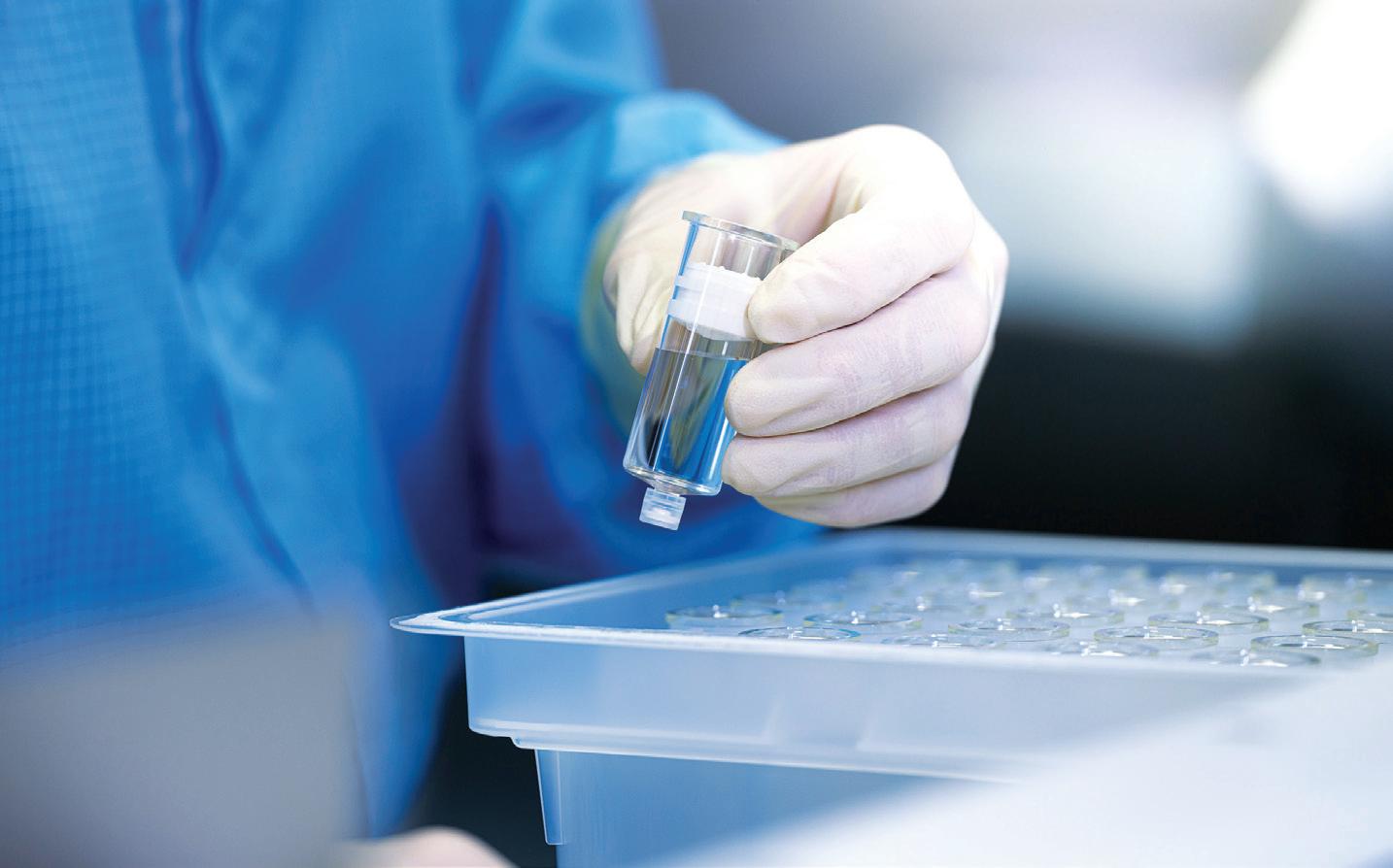
of containers and elastomeric closures provided by suppliers, and tightly link it to the final drug product requirements, as per quality-by-design considerations.
The selection of an OBI and its primary packaging container involves several critical considerations besides product-related decisions. Attention must be paid to whether existing manufacturing facilities and lines are capable of filling and stoppering the container, or if a new facility or the selection of a dedicated CDMO for drug product fill-finish operations is necessary (Figure 2).
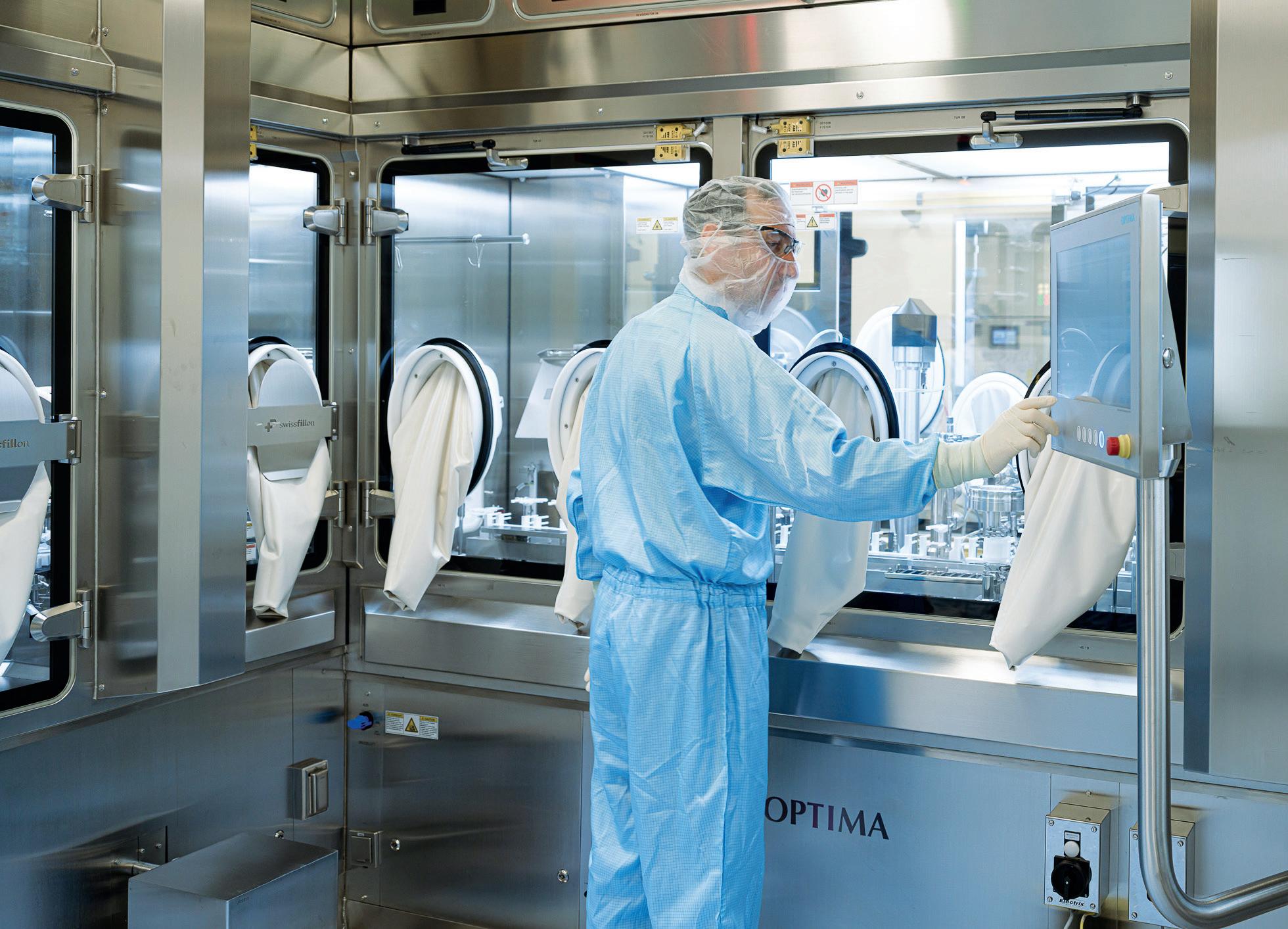
Several factors must be taken into account, including the availability of format parts, the ability to fill a certain viscosity range, the process knowledge and expertise of suitable stopper setting processes and the filling pump technology. Manufacturing process unit operations can lead to adverse product quality impacts and the filling accuracy and presence of headspace may impact the dosing accuracy of the device.
The stoppers used in OBIs can sometimes be custom-designed to meet specific requirements. During the stopper setting process, several issues can arise that may affect container closure integrity (CCI). One common problem is “tilting”, where the stopper does not move or sit properly during setting. Additionally, depending on the type of stopper and the manufacturer’s expertise, wrinkles in the stopper coating can occur.
Another essential aspect when filling the primary packaging container for OBIs is the presence of an air bubble, or “headspace”, in the OBI container – it is crucial to select a partner capable of filling without air bubbles. It is crucial to determine whether the stopper will sit directly on the solution, thereby avoiding headspace, or if headspace will be present. In the presence of headspace, any movement of the stopper, such as during assembly or air transport, must be carefully evaluated.
To summarise, selecting an OBI and deciding on its filling and assembly location requires detailed planning to ensure successful implementation.
It is important to consider how the fluid path – from the container to drug
product withdrawal to administration – is designed to ensure protection from potential environmental microbiological contamination. Some devices use specific technologies to ensure that sterility of the fluid path is maintained. Of course, the actual risk of not having a fully protected sterile fluid path has to be evaluated in detail as, at the point of drug product withdrawal, the outside of the stopper will not be sterile, only disinfected (e.g. with an isopropanol wipe). It may be theoretically possible to develop and commercialise devices without full sterile fluid path protection, based on adequate risk assessments and risk management, and in close alignment with health authorities. In such cases, device assembly may have to be performed under clean room conditions – in Class D or Class C, or even Class A under laminar flow – to minimise potential contamination of the outside product packaging during assembly. This assumes that the device and secondary packaging ensure protection against subsequent environmental contaminations.
Successful development of large-volume SC injection devices relies on making wise choices regarding the device technology and development and manufacturing partners. Optimal partners should have capabilities for integrated development, fostering collaboration between product development and manufacturing teams. Early involvement and joint discussions with primary packaging suppliers, device manufacturers, fill-finish facilities and drug product developers may enable synchronised strategies, aligned specifications and holistic troubleshooting, which can save time, costs and resources while preventing errors. Continuous communication is imperative for project success.
A CDMO such as ten23 health is appropriately positioned to overcome the challenges of large-volume injection devices. The company offers integrated development of formulation services, analytical development and product characterisation, as well as support for device selection and testing, drug-device integration and
drug product filling process design and characterisation. It also provides drug product manufacturing of complex and high-precision containers at its GMP fillfinish facility and quality control release and stability testing services.
ten23 health is a pharmaceutical CDMO that supports its clients in developing differentiated, stable, usable and safe injectable treatment options for patients. The company combines the latest scientific findings with proven industry and regulatory expertise to forge new paths for its clients’ needs. ten23 provides its innovative services in a fair and sustainable manner, respecting people’s health and the future of the planet.
1. Datta-Mannan A et al, “Influence of physiochemical properties on the subcutaneous absorption and bioavailability of monoclonal

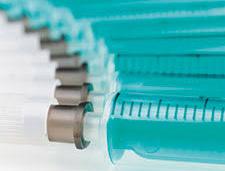
antibodies”. mAbs, 2020, Vol 12(1), Article 1770028.
2. Dang X et al, “Clinical Investigation of Large Volume Subcutaneous Delivery up to 25 mL for Lean and Non-Lean Subjects”. Pharm Res, 2024, Vol 41(4), pp 751–763.
3. Allmendinger A et al, “Rheological characterization and injection forces of concentrated protein formulations: an alternative predictive model for non-Newtonian solutions”. Eur J Pharm Biopharm, 2014, Vol 87(2), pp 318–328.
4. Mazaheri M et al, “Monitoring




of Visible Particles in Parenteral Products by Manual Visual Inspection-Reassessing Size Threshold and Other Particle Characteristics that Define Particle Visibility”. J Pharm Sci, 2024, Vol 113(3), pp 616–624.
Andrea Allmendinger, PhD, has been Chief Scientific Officer at ten23 health since November 2021. Dr Allmendinger is also Adjunct Professor and Group Leader at the University of Freiburg (Baden-Württemberg, Germany), researching novel parenteral drug formulations and device solutions to improve stability, usability and cost of goods. Between 2010 and 2021, she was Principal Scientist, Pharmaceutical Development at Roche, working on inter alia manufacturability and injectability of high-concentration formulations, syringe and high-volume drug/device combination products, particulates and surfactant strategy.
Dr Allmendinger studied Pharmacy at the University of Heidelberg (Germany) and University College London (UK), and holds a PhD in Pharmaceutical Sciences from the University of Basel (Switzerland). She obtained the venia legendi (German Habilitation) from the University of Freiburg in 2021 and served as Editor-In-Chief for the AAPS Open Journal from 2021 to 2024.
Michael Adler, PhD, is currently Director Drug Product Design at ten23 health. He has over 20 years of industry experience at different pharmaceutical companies, including Abbott (now AbbVie), Roche, Lonza and ten23 health. He has vast experience in early- and late-stage formulation and drug product manufacturing process development for both liquid and lyophilised dosage forms. His area of expertise also covers process transfer, process characterisation and validation and commercial support for biological drug products, including combination products and small-molecule parenterals. Dr Adler has driven development of monoclonal antibodies and novel antibody-derived formats, fusion proteins, PEGylated proteins, synthetic peptides and oligonucleotides for IV, SC, intravitreal and intrathecal delivery. He has extensive knowledge with regards to regulatory registration activities, as well as health authority interactions for the US, Europe and elsewhere. Dr Adler studied Pharmacy at the University of Heidelberg (Germany) and holds a PhD in Pharmaceutical Technology from the University of Erlangen-Nürnberg (Germany).
Carole Delauney was Senior Director Business Development at Swissfillon, and has continued to hold this position after the company’s acquisition by ten23 health in October 2021. She has also handled similar roles at small and large CDMOs based in Europe and the US since she started her career in 2003, with a focus on sterile fill-finish operations since 2007. Ms Delauney has a degree in Biochemistry from the University of Montpellier (France).
Professor Hanns-Christian Mahler, PhD, is Chief Enablement Officer and Board Member at ten23 health. He previously led the Drug Product Services Business Unit at Lonza AG (2015–2021) and worked in various leadership roles, such as Head of Pharmaceutical Development & Supplies at Roche (2005–2015) and Merck KGaA (2000–2005). He has extensive expertise in formulation development, process development and validation, packaging/device development and integration, sterile manufacturing and regulatory submissions with numerous IND/IMPD and BLAs. Professor Mahler studied Pharmacy at the University of Mainz (Germany), and holds a PhD in toxicology from the Institute of Pharmacy, University of Mainz, and pharmacist specialisation degrees in toxicology and ecology, and pharmaceutical technology. Professor Mahler completed his habilitation thesis at the University of Frankfurt (Germany) in 2010 and is an adjunct faculty member and lecturer at the Universities of Frankfurt and Basel (Switzerland). He received an extraordinary Professorship from Frankfurt in 2015 and an honorary Professorship from Basel in 2023, he also has qualifications in Business and Marketing, Organisational Development and Sustainability. Professor Mahler serves as Expert for the European Pharmacopeial Group 12 at the European Directorate for Quality of Medicines and Healthcare and is Editor for Pharmaceutical Research, the Journal of Pharmaceutical Sciences, the AAPS Open Journal and the PDA Journal of Pharmaceutical Sciences and Technology
Comprehensive pharmaceutical services for sterile dosage forms.
The complexity and diversity of modern therapeutics is increasing. Medical research is facing growing challenges of stability, usability, and consistent manufacturing.

Pharmaceutical products need to be designed with the patient and regulatory requirements in mind, in order to deliver safe, effective, high-quality, and easy-to-use medicines. At ten23 health, we integrate different elements such as formulation development, manufacturing process design, control strategy, primary packaging, and device selection, to achieve a holistic product design from the start.

ten 23 health AG
Mattenstrasse 22
4058 Basel, Switzerland
contact@ten23.health

Formulation development for liquid and lyo
Sterile drug product development for different modalities
Sterile manufacturing under cGMP (vials, syringes, cartridges)
Administration compatibility testing
Syringe development, manufacturing, testing
Primary packaging material characterisation
Covering a wide range of viscosities and volumes from 2 to 10 mL, YpsoDose is fully industrialised and prepared to meet your clinical trial needs. From start to finish, Ypsomed manages a streamlined supply chain. The ready-to-use cartridge safeguards drug stability, while innovative engineering guarantees reliable and precise delivery.

Patch: remove adhesive and attach YpsoDose on injection site
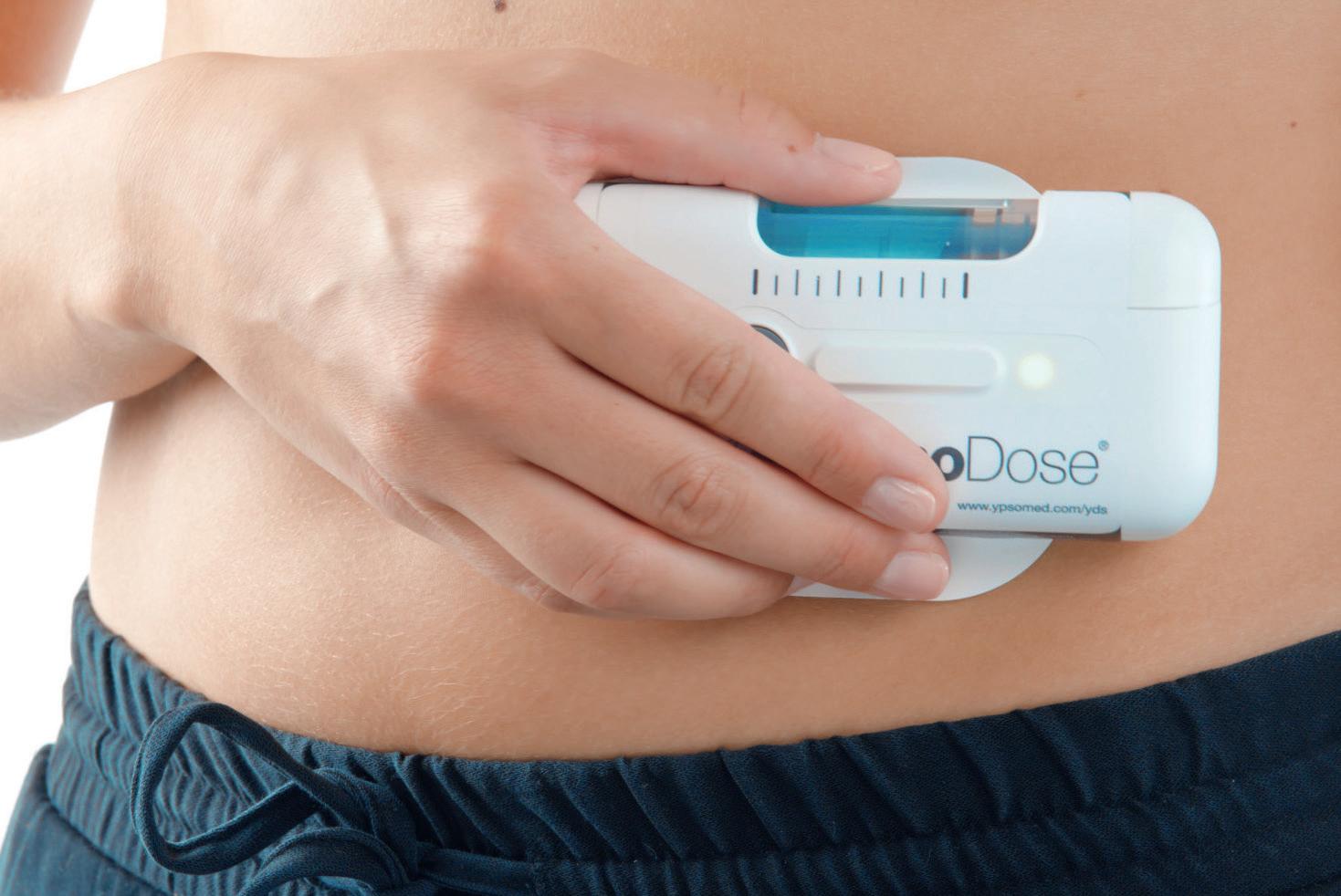
Inject: press the start button
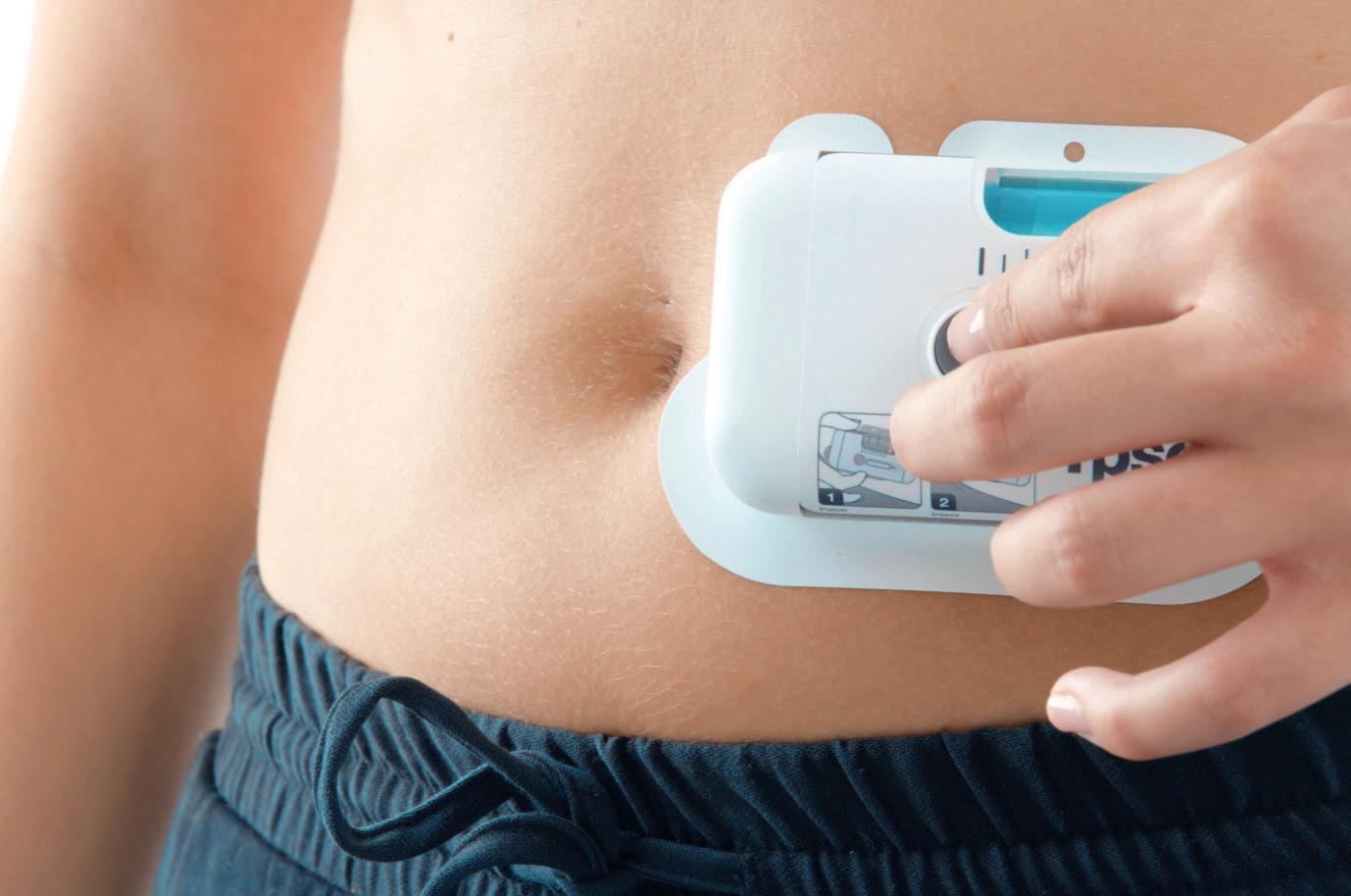

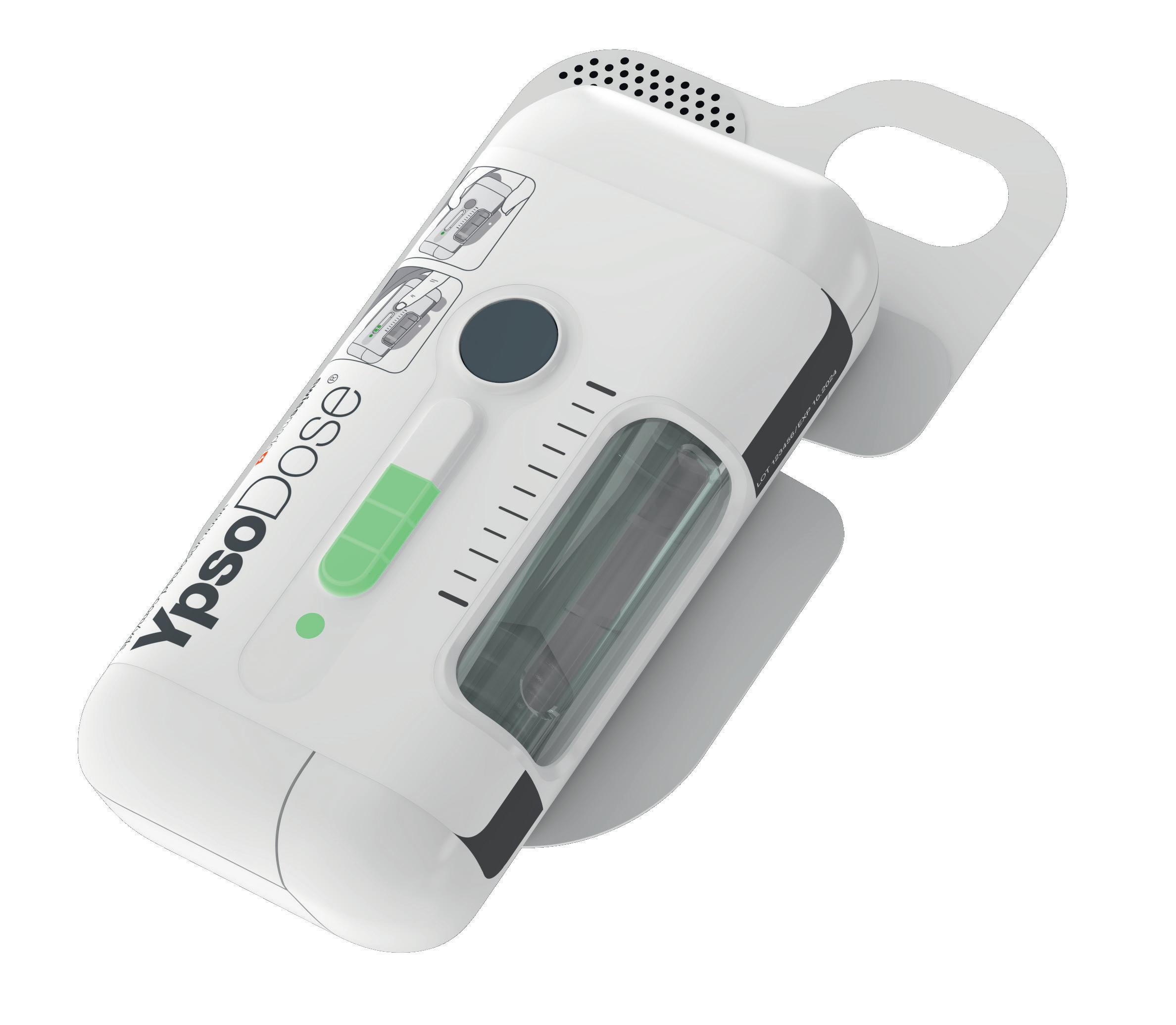
Improving therapy outcomes by patient-centric design
Built-in sterility to make selfcare safer, simpler and easier
Clearly communicates via audio and visual signals before, during and after injection
Smart drive system to ensure complete injections and consistent flow-rate under all conditions
Orientable in any position comfortable for the patient at the desired injection site
Visit our website for detailed information about the YpsoDose www.ypsomed.com/ypsodose
Here, Chaoyoung Lee, PhD, President, and Mike Stout, RPh, Head of Strategic Partnerships and Clinical Applications, both of TxSphere, introduce the Horizon wearable micro-pump platform, a cutting-edge advancement in the drug delivery device market that marks a significant contribution to wearable drug-device design.
TxSphere’s extensive experience with infusion pumps and combination drug delivery devices has provided valuable insights into the shift towards subcutaneous (SC) self-administration of pharmaceuticals. These insights prompted the company to explore whether this growing trend has resulted in any significant unmet needs.
SC delivery is preferable to intravenous methods for several reasons. First and foremost, it is considerably less invasive. It can also significantly improve the patient’s quality of life by allowing them to administer their own medication without the need for frequent clinic visits. This not only improves patient autonomy but also reduces healthcare costs.1
Studies into the self-administration trend have highlighted several unmet needs. Key areas that have been identified for improvement are usability and a need to deliver larger doses, as not all biologic drugs can be formulated in small doses.1 In addition, wearables and autoinjectors are predominantly designed as “injectors”, which deliver doses quickly. At some point, larger volumes become impractical for this approach.
These unmet needs prompted TxSphere to investigate if a miniature version of its electromechanical pumping technology could offer a solution. The company envisioned a versatile wearable device capable of both quick injections and prolonged infusions providing flexibility without compromising patient comfort. Such a device can handle a broader spectrum
“TxSphere formed a dedicated development team, which led to the launch of the Horizon project.”
of biological and pharmaceutical agents, including complex regimens requiring high doses and viscosities. The resulting device should be both small and lightweight, suitable for extended wear, and beneficial for both small and large volumes.
TxSphere’s research also identified several key considerations for improving wearable devices:
• Providing the best possible patient experience
• Advancing safe and effective selfadministration
• Accommodating a diverse range of drug administration requirements
• Reducing the cost per dose.
To make this vision a reality, the company formed a dedicated development team, which led to the launch of the Horizon project. However, it became clear that a more focused design environment would benefit the project’s long-term objectives. This vision came to fruition in early 2024, with a spin-off to establish TxSphere LLC, a specialised organisation devoted to advancing drug delivery devices.
Design Background
The Horizon platform consists of three distinct versions, Horizon I, II and III. While the design elements were altered with each version, the core product design requirements remained the same:
• Minimal impact on daily life
• Ease of use
• Low cost per dose.
All Horizon wearables include three primary components: pump, prefillable drug reservoir and cannula injector. The difference between each version is whether these components are combined or supplied as separate modules.

Dr Chaoyoung Lee
President
T: +1 508 907 6885
E: cylee@tx2sphere.com

Mike Stout
Head of Strategic Partnerships and Clinical Applications
T: +1 508 907 6885
E: mike.stout@tx2sphere.com

TxSphere LLC
Natick
MA 01760
United States
www.tx2sphere.com
Horizon I combines the three components into a single, compact, pod-like unit. Horizon II introduces three separate modules for each component. Horizon III is the latest and most advanced version – designed with two separate modules, the reusable pump and the disposable drug container (DDC) with integrated cannula injector (Figure 1). This configuration provides a balanced approach to meet the market demands for patient experience, cost efficiency, flexible drug administration and sustainability. The adaptable design also satisfies a wide range of clinician and pharmaceutical manufacturer needs.
Horizon III is designed for simplicity and ease of use. Its user interface consists of a single start/stop button and requires only three simple steps for operation (Figure 2):
1. Place the DDC onto the pump
2. Attach the DDC/pump assembly to the skin
3. Press the start button.
Instead of using a needle, Horizon devices use an autoinjector mechanism to insert a soft cannula, which enhances comfort, especially during extended infusions. The hidden cannula injector activates automatically, requiring no user intervention. For many, this feature can help alleviate the apprehension associated with self-injection. Horizon III is prefillable, which reduces the complexity and risk from self-filling the drug reservoir. However, for drugs that cannot be prefilled, Horizon wearables can be manually filled at the point of care or can automatically transfer medication from a vial.

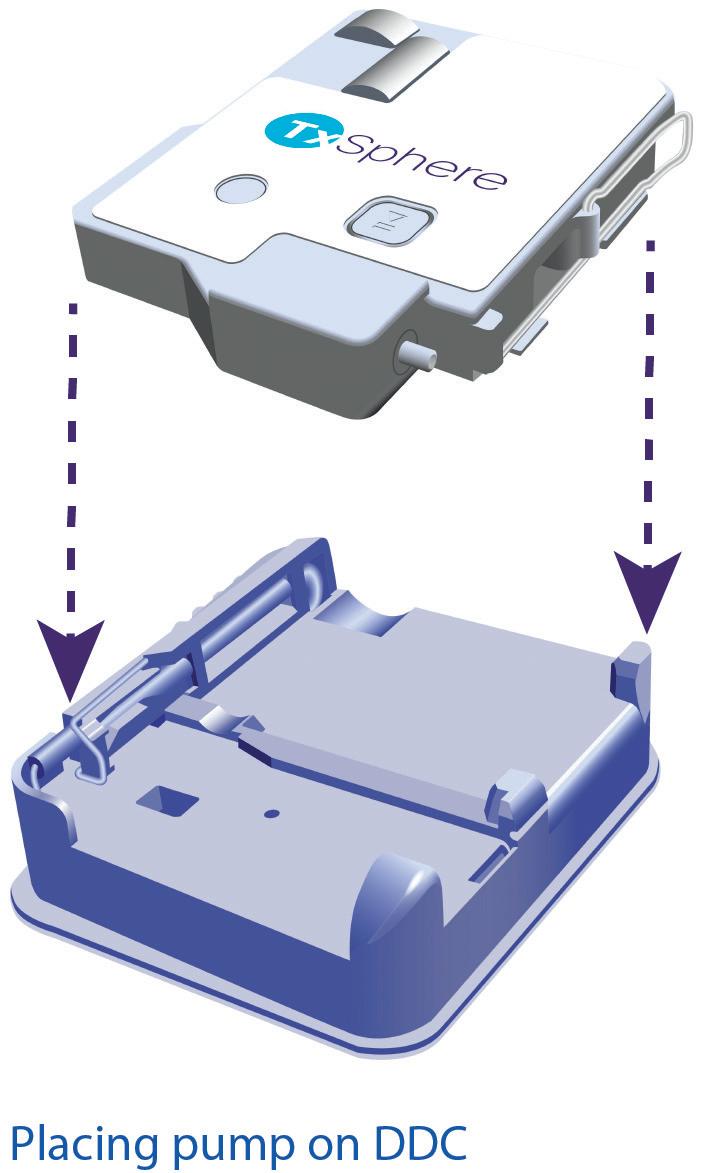

The custom internal reservoir was a key factor to reduce the size and weight of each Horizon device. This was because there were no restrictions for size, shape, weight and volume of injectable drug cartridges. Even with its standard 10 mL reservoir, Horizon III remains more compact and lightweight than many devices with lower capacities. This small form factor makes the device more comfortable, less noticeable and easier to conceal (Figure 3).
To power the device throughout its lifecycle, a simple wireless charging feature is incorporated into Horizon III. It is also compatible with common wireless mobile phone chargers.
Ensuring proper drug administration and compliance are among the top clinical concerns with self-administration. To address these concerns, Horizon III is equipped with sensors that verify the completion of all operational steps: placement of the DDC on the pump, removal of the adhesive paper and attachment to the skin.

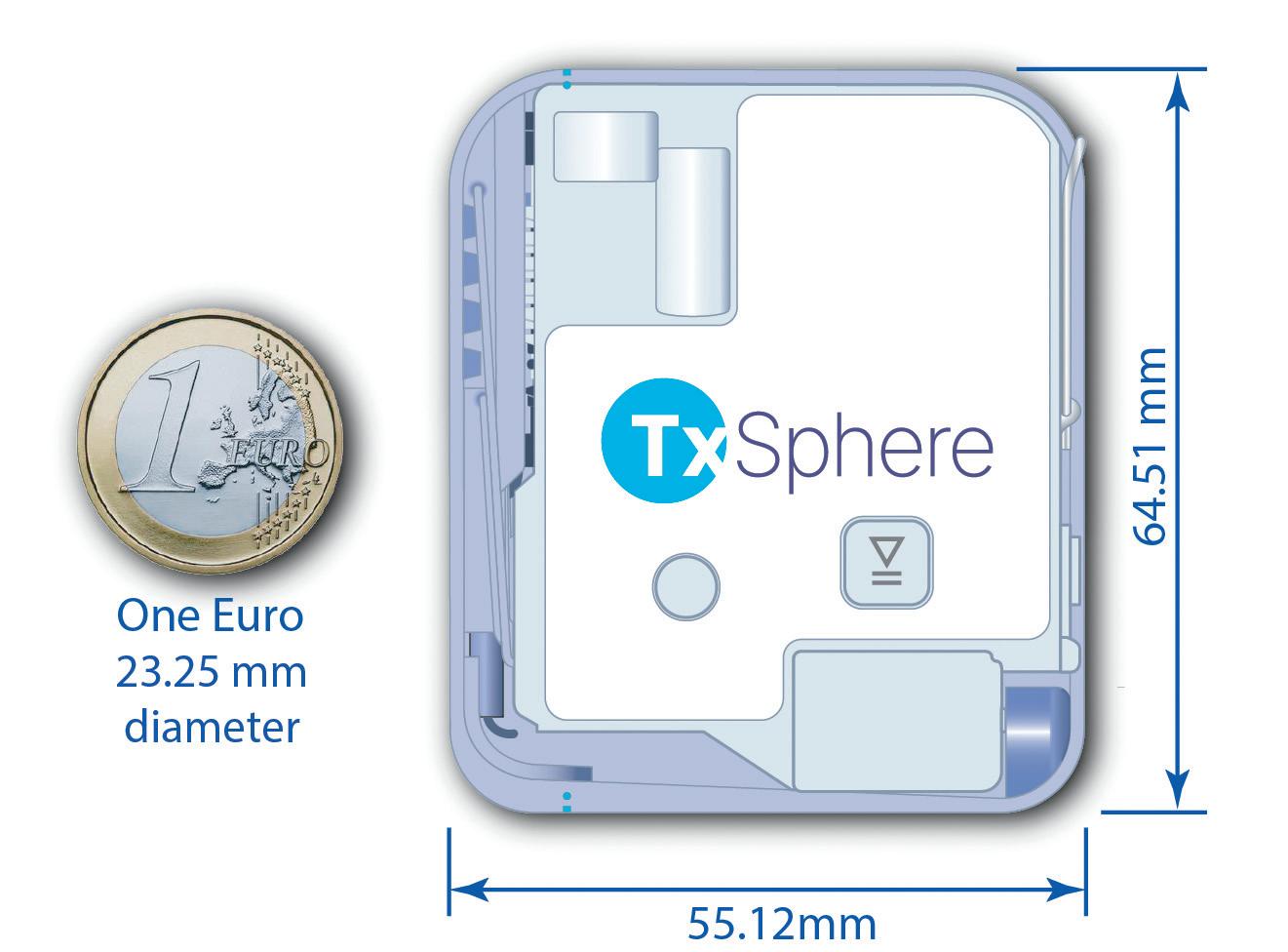
To ensure that an inadvertent press of the start button does not initiate the infusion, the button is not active until all these steps have been confirmed by the sensors. Additionally, infusion will not begin until the cannula injection has been confirmed. To improve sustainability, these sensors are all located within the reusable pump body for use throughout the lifecycle.
Monitoring for compliance can also help ease concerns. The Horizon platform provides connectivity that can be used for compliance monitoring as well as many other related uses.
The modular design of the Horizon III enhances manufacturing efficiency. The separate pump and DDC modules each have distinct requirements for environment considerations, regulations, processes, quality control and packaging. Separate modules permit the use of individualised manufacturing lines that can better address the specific requirements of each module. Additionally, the electromechanical pump components can be eliminated from the sterilisation process.
All Horizon devices are designed to be prefilled with medication. The custom internal reservoir comprises a co-polymer film designed specifically for sterile drug product storage. TxSphere’s patented fill port makes the prefilling process simpler and more efficient.
Due to the limitations of the SC tissue’s capacity to absorb medication, the volume of medication administered subcutaneously is typically between 1 and 2 mL. But complex molecules, such as monoclonal antibodies, may require larger doses. Strategies to deliver higher volumes include divided doses, smaller volumes or more frequent dose administration.1 Other strategies include slower delivery speeds for longer delivery times and drug reformulation.
Although hand-held autoinjectors are now able to deliver up to 5.5 mL, they are limited by how long a user can be expected to hold the device against their skin to complete a delivery.2,3 Slower injection speeds can increase the amount of fluid that can be delivered, help reduce the pain caused by quick injections and increase drug dispersion and absorption.4,5 For example, SC immunoglobulins are highly viscous biological products with single injection site doses as high as 50–60 mL. To accommodate these volumes, they are delivered at low speeds of 1 mL/minute or less.6,7
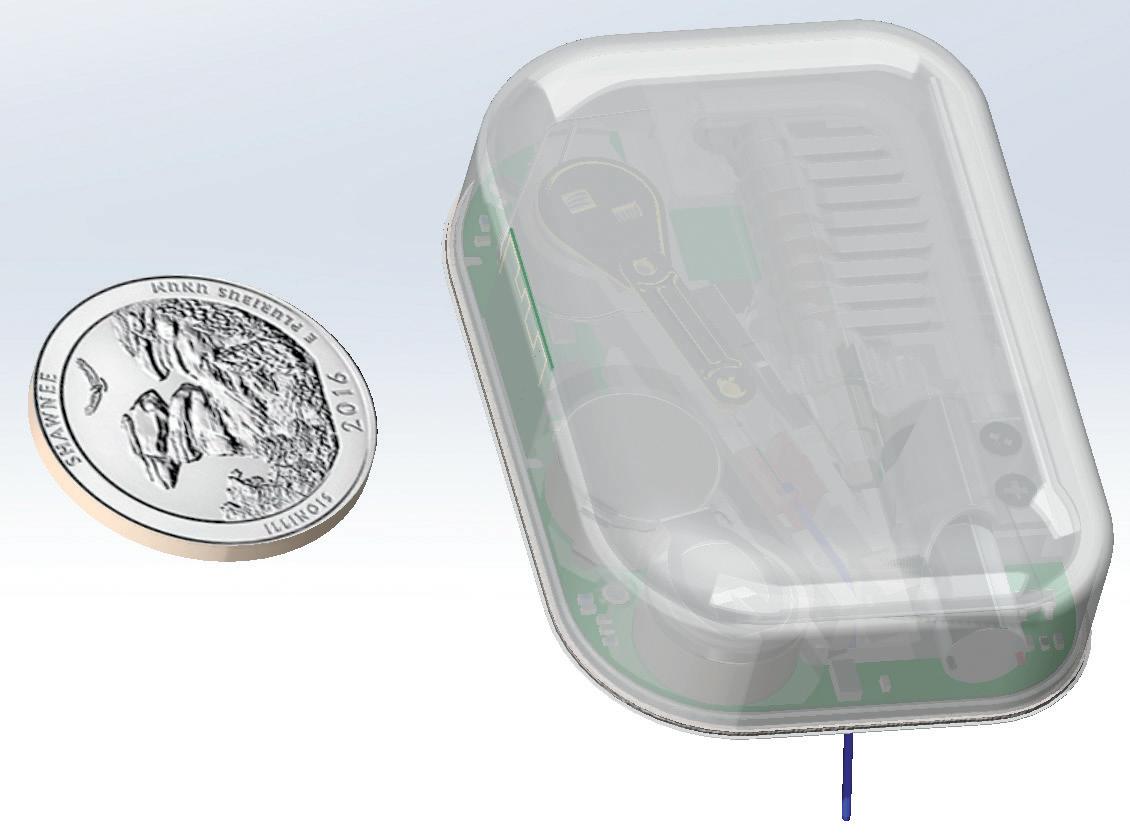
“With the ability to deliver complex regimens, Horizon III can provide a costeffective alternative to drug reformulation.”
Horizon III’s robust pumping mechanism can deliver highly viscous solutions at various delivery speeds and infusion times. The flexible design of the internal drug reservoir makes it possible to accommodate larger dose volumes. With the standard footprint, Horizon can hold up to 20 mL and can also accommodate higher volumes with an expanded footprint.
With the ability to deliver complex regimens, Horizon III can provide a cost-effective alternative to drug reformulation. The use of innovative SC delivery devices can even facilitate larger-volume SC injections without the need for permeation-enhancing enzymes.8
Sustainability can be enhanced through both manufacturing processes and considerations for device disposal.9 According to the WHO, treatment and disposal of healthcare waste may pose health risks indirectly through the release of pathogens and toxic pollutants into the environment. They define infectious waste as anything contaminated with blood and other bodily fluids.10 This concern is elevated when additional items are discarded with the infectious waste. When injection needles and cannulas are combined with the delivery component, the entire device must be disposed of as hazardous waste after each use, which is neither environmentally sustainable nor cost effective. Because of the reusable pump module, the Horizon III pump can be reused and recycled. This means that the DDC is the only component that needs to be be disposed of as hazardous waste after each dose.
The Horizon III micro-pump module is the most expensive component. Because it is designed for extensive reuse, the cost per dose is spread out over many injections. As a result, the cost per dose is driven primarily by the less expensive disposable DDC.
Not only is each Horizon version different in how the three primary components are combined, but they are also different in how they address various market requirements. Horizon I is optimised to provide the best patient experience. Horizon II introduced improvements to manufacturability, sterilisation, sustainability and cost per dose. Horizon III is a hybrid that incorporates the best features of Horizon I and II. The Horizon I and II designs and features are compared below.
Horizon I combines the three components (pump, drug reservoir and cannula injector) into a single, compact, pod-like unit. It is remarkably small and simple, and can be supplied prefilled with medication. Offering all three components in a ready-to-use form, it provides the best patient experience (Figure 4).
However, the all-in-one design presents several challenges in terms of manufacturability, sterilisation, sustainability and cost per dose. The sterilisation process is complicated by the inclusion of electronic and mechanical components packed into a very
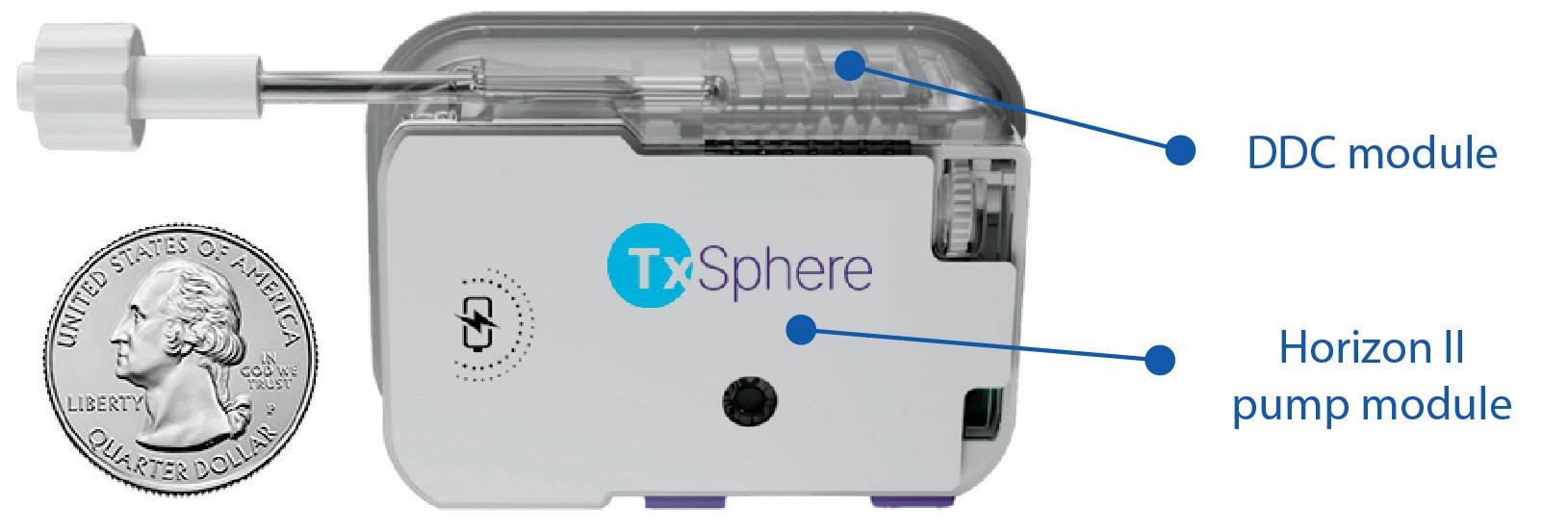
small space. Additionally, the all-in-one design means that the entire device must be discarded as hazardous waste after each dose, which affects cost and environmental impact.
To provide improvements to manufacturability, sterilisation, sustainability and cost per dose, Horizon II is based on a modular concept. The pump, drug reservoir and cannula injector are all supplied as separate modules (Figure 5).
These separate modules allow the electromechanical pump portion to be reused, while the sterile components can be handled and disposed of more effectively. This reduces the environmental impact and cost per dose. At the same time, only the DDC module requires sterilisation, which significantly simplifies the process and provides additional cost reductions.
The third module is the cannula injector. Several cannula injectors are readily available primarily due to their use with insulin pumps. Therefore, instead of designing a proprietary version, TxSphere simply added a luer connector to the DDC so that it can connect to the tubing of these cannula injectors.
TxSphere has introduced the Horizon III wearable micro-pump, a significant advancement in wearable drug delivery technology. It simplifies the self-administration of SC medication with a patientfriendly, attach-and-go infusion system.
Horizon III offers a unique platform for differentiating combination pharmaceuticals by enhancing the patient experience, providing flexibility in drug delivery and reducing costs. This model features a user-friendly design with simple operation steps and a soft cannula injector for added comfort. Its prefill capability, flexible platform and small, lightweight design make it an ideal device to deliver a wide range of drug formulations, including large-volume and viscous pharmaceuticals.
TxSphere (“Tech Sphere”) was founded as a spin-off of Intuvie LLC to focus exclusively on the development and technology licensing of drug delivery devices for drug-device combination products. For manufacturing and related services, the company will pursue partnerships with CDMOs
1. Dychter, SS et al, “SC Drug Delivery, A Route to Increased Safety, Patient Satisfaction, and Reduced Costs”. J Infus Nurs, 2012, Vol 35(3), pp 154–160.
2. Parker M, Chellappan K, Cottenden D, “Directions for Wearable On-Body Injector Systems and Beyond”. ONdrugDelivery, Issue 151 (Sep 2023), pp 12–15.
3. Boyd M, “Would You Like to Go Large? Key Considerations for Large-Volume Injectors”. ONdrugDelivery, Issue 151 (Sep 2023), pp 17–21.
4. Pepin XJH, Grant I, Wood JM, “SubQ-Sim: A SC Physiologically Based Biopharmaceutics Model. Part 1: The Injection and System Parameters”. Pharm Res, 2023, Vol 40, pp 2195–2214.
5. Kim H, Park H, Lee SJ, “Effective method for drug injection into SC tissue”. Sci Rep. 2017, Vol 7(1), p 9613.
6. “Cuvitru”. Prescribing information, Takeda Pharmaceuticals, March 2023.
7. “Hizentra”. Prescribing information, CSL Behring, April 2023.
8. Adler M et al, “Transitioning from Vial to SC Injection Devices for Biological Drug Products”. ONdrugDelivery, Issue 160 (May 2024), pp 8–14.
9. Osorio S, Mou S, Dean C, “Sustainable by Design: Developing Patient- and Planet-Centric Medical Devices”. ONdrugDelivery, Issue 159 (Apr/May 2024), pp 52–57.
10. “Health-care waste”. WHO, Feb 2018.
Chaoyoung Lee, PhD, is a software engineer by training and an entrepreneur who has founded and grown multiple software and medical device companies. He is the founder and president of TxSphere, with a passion for developing simple and intuitive technologies to improve the patient experience in self-administrative medication therapies at home to manage disease states.
Mike Stout, RPh, began his career in home infusion pharmacy as a Director of Pharmacy for a major health system and a branch manager for a national organisation. His interest in infusion devices eventually led him to the ambulatory infusion device industry. His contributions have primarily involved sales, marketing and product development. In June 2005, Mr Stout received the Outstanding Design Team award from MDDI Magazine for his role in developing the AmBit® ambulatory infusion pump. He has also shared his knowledge as a lecturer on infusion therapy, pain management and human factors design, presenting both domestically and internationally.
In this article, Omar Rahman, PharmD, Medical Director, Medical Affairs at Enable Injections, Beth Faiman, PhD, Nurse Practitioner, Department of Hematology and Medical Oncology at Cleveland Clinic Taussig Cancer Institute, and Lisa Gorski, Clinical Education Specialist/Clinical Nurse Specialist at Ascension at Home, highlight the importance of a comfortable experience for both patients and healthcare providers when it comes to large-volume subcutaneous drug delivery.
Biologic drugs, such as monoclonal antibodies (mAbs), are a class of medications that represent a rapidly expanding category of therapies, used to treat serious diseases, including cancer, metabolic disorders, cardiovascular conditions, genetic disorders and immunological diseases. These drugs were initially designed for intravenous (IV) administration due to their large, complex molecular structures, which are poorly absorbed when taken orally. However, because IV administration can sometimes be painful, less tolerated by patients and resource intensive, there has been significant growth in subcutaneous (SC) delivery options.
With the rising popularity of biologic drugs in the past decade, their administration has gradually shifted from IV to SC delivery. The SC delivery method has since been adopted in oncology as an alternative to traditional IV infusions. For example, Roche (Basel, Switzerland) launched SC formulations for rituximab, pertuzumab and trastuzumab, which were initially approved for IV administration. Clinical studies have demonstrated the long-term efficacy and safety of these SC formulations, confirming them as valid therapeutic alternatives.
The shift from IV to SC administration of biologic drugs has been facilitated by advances in high-concentration formulation
“One of the major challenges with administering large-volume SC drugs combined with permeation enhancers is the administration experience for nurses.”
development, devices for injecting largevolume doses (e.g. on-body delivery devices) and permeation enhancers. While not essential for large-volume SC delivery, permeation enhancers, such as hyaluronidase, have been at the forefront of this transition.
One of the major challenges with administering large-volume SC drugs combined with permeation enhancers (e.g. daratumumab/hyaluronidase, rituximab/ hyaluronidase or pertuzumab/trastuzumab/ hyaluronidase) is the administration experience for nurses. Currently, these drugs are given through a labour-intensive manual injection process using a needle and syringe. This method requires the nurse
Dr Omar Rahman
Medical Director, Medical Affairs
T: +1 513 326 2800
E: orahman@enableinjections.com
Enable Injections, Inc
2863 East Sharon Road Cincinnati OH 45241
United States
www.enableinjections.com
Dr Beth Faiman
Nurse Practitioner, Department of Hematology and Medical Oncology
T: +1 216 445 7238
E: faimanb@ccf.org
Cleveland Clinic
Taussig Cancer Institute
CA Building, 10201 Carnegie Avenue Cleveland OH 44106
United States
www.clevelandclinic.org
Lisa Gorski
Clinical Education Specialist/Clinical Nurse Specialist
T: +1 833 380 9583
E: lisagorski@hotmail.com
Ascension at Home Suite B, 945 Veterans Drive North Vernon IN 47265
United States
www.ascensionathome.com
to exert pressure, sometimes taking several minutes to complete. During this time, the nurse must conduct and closely monitor the procedure to ensure that the medication is delivered safely and accurately. Despite the considerable time and effort required to administer these drugs, the preferences and challenges faced by nurses are often overlooked and underappreciated.
While the syringe format enables faster drug administration compared with IV infusions, it comes with several drawbacks. These include repetitive strain and needlestick injuries for nurses, who must apply consistent pressure for extended periods when administering large-volume formulations to multiple patients each day, as well as an increase in patient discomfort due to the use of larger gauge needles. Such injuries often require extended recovery periods, especially for older nurses. Additionally, repetitive strain may hinder the ability of nurses to provide continuous infusions, potentially resulting in drug misuse and escalating both direct and indirect costs.1
A recent meta-analysis involving 42 studies and over 36,000 nurses found that the annual prevalence of work-related repetitive strain injuries among nurses is
“While larger gauge needles can improve delivery speed, they also compromise the patient experience.”
77.2%. The most common areas affected are the lower back (59.5%), neck (53.0%) and shoulders (46.8%).2 These injuries might significantly impact their mental health and overall quality of life, as well as contribute to chronic conditions. They could also lead to substantial treatment costs, work restrictions, absenteeism and high turnover rates among nurses, ultimately affecting patient safety and care quality.3–5 Nurses experiencing chronic repetitive strain injuries might require long-term medication and frequent use of pain relievers – and seek various medical consultations and alternative treatments. The financial burden of these injuries is considerable, with costs for diagnostic tests, healthcare and worker compensation estimated at between US$50,000 (£39,000) and $100,000 per nurse.5,6
The impact of administering largevolume SC drugs co-formulated with permeation enhancer via syringes extends beyond the difficulties encountered by nurses. Although often overlooked, these drugs generally require larger gauge needles to enhance flow rates and manage the higher viscosity of the co-formulations. It is important to note that, while larger gauge needles can improve delivery speed, they also compromise the patient experience because larger gauge needles have larger diameters and are sometimes associated with increased pain and bleeding.7–9 Larger gauge needles can also be more intimidating, potentially increasing patient anxiety, which may require nurses to spend more time counselling patients and can result in missed or delayed injection appointments.10–12
In some healthcare centres, there have been attempts to alleviate the manual administration process by using syringe pumps. However, this approach comes with its own set of challenges: it significantly increases costs, adds complexity to infusion suite arrangement, requires a time-consuming set-up and often results in crowding and logistical difficulties, further underscoring the need for more efficient and cost-effective alternatives.1
Unlike the syringe format and the syringe pumps currently used for administering large-volume SC formulations, on-body delivery systems (OBDSs) offer several advantages. OBDSs use thinner needles, do not require co-formulation with permeation enhancers, feature a concealed needle mechanism and, most importantly, deliver the drug via the push of a button. These features address many challenges associated with large-volume SC delivery via manual syringes and syringe pumps. The hidden needle design may help alleviate patient needle phobia, while the smaller needles can enhance adherence and minimise pain.12 Given the hands-free delivery feature of OBDSs, they have the potential to reduce the physical strain on nurses, thereby decreasing the risk of repetitive strain injuries. By using an OBDS, nurses would not have to spend several minutes directly administering a drug, allowing them to tend to other patients or responsibilities – potentially improving clinical efficiency by increasing throughput.
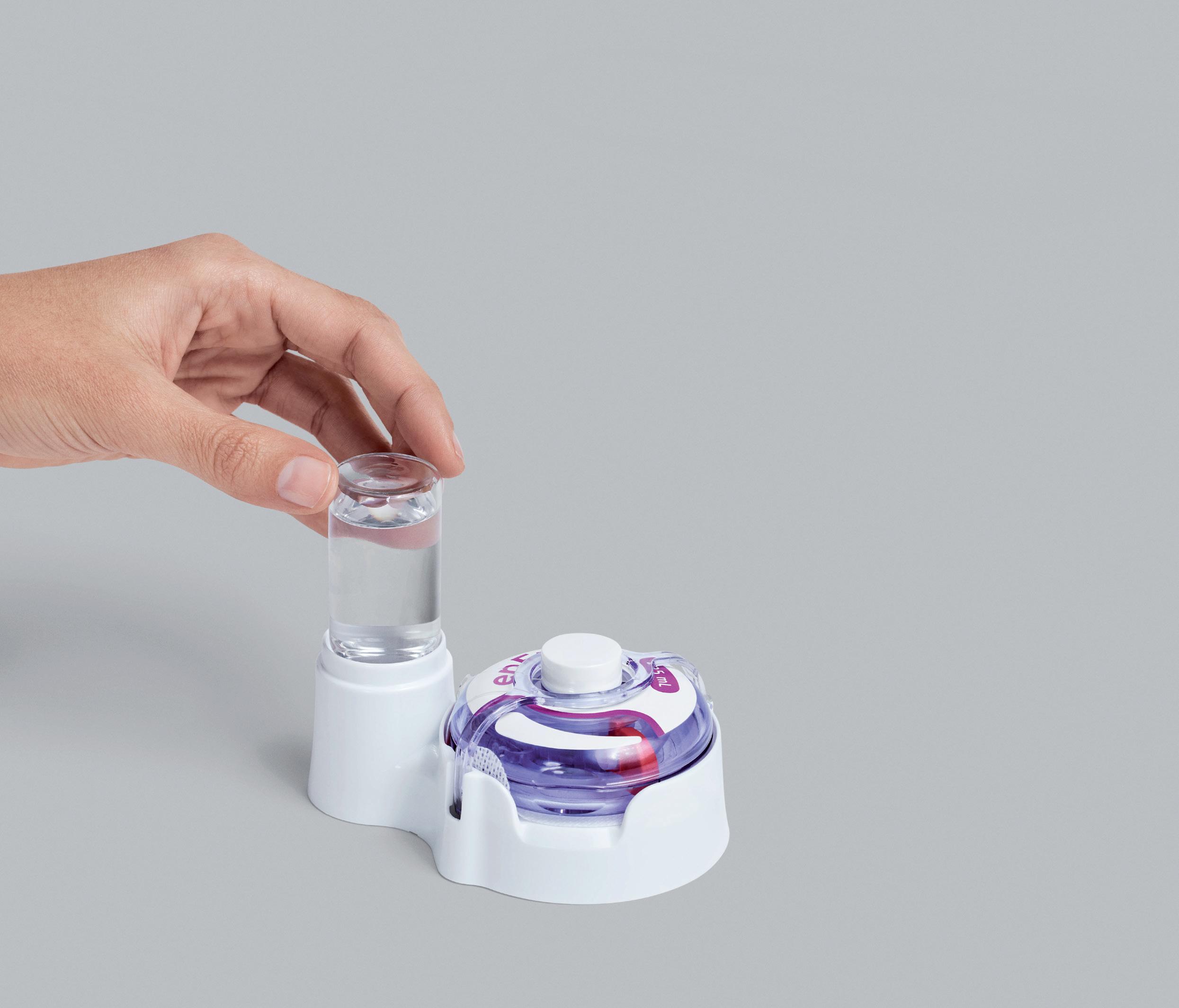
Figure 1: The enFuse system features a remarkably small needle (30G) that is hidden from the user throughout the entire administration process.
In a recent double-blinded online survey conducted by a third-party vendor, nurses with experience administering large-volume SC drugs co-formulated with permeation enhancers using SC syringes were asked about their experiences and preferences compared with the enFuse (Figure 1) – an OBDS featuring the first-ever hands-free wearable technology designed to deliver large volumes (5–25 mL) of drugs subcutaneously.13
In a detailed scenario that assessed factors beyond just delivery time – including administration method, nurse effort, needle
size, time, patient mobility, preparation and additional direct costs – while assuming the same efficacy, safety and cost, 44 out of 45 nurses (97.78%) preferred the enFuse over the syringe typically used for administering daratumumab/hyaluronidase. The main reasons for this preference were:
1. Reduced nurse effort due to hands-free delivery
2. Less patient pain from a smaller needle
3. Elimination of needlestick injuries with a hidden needle mechanism
4. Improved clinic efficiency from handsfree operation.13
Regarding their views on the current needles used for large-volume SC drugs administered via syringes, a total of 94.44% (17/18) of haematology and oncology nurses and 90.91% (20/22) of nurses with experience administering daratumumab/ hyaluronidase believed that smaller gauge needles would reduce needle phobia for oncology patients. Additionally, 93.33% of the nurses in the full sample believed that a hidden needle mechanism would eliminate the risk of needlestick injuries.13
When comparing preferences between traditional syringe pumps and the enFuse, an overwhelming 97.78% of nurses in the full sample expressed a clear preference for enFuse for preparation and administration of 5–25 mL of drug product. This finding is particularly noteworthy because, although some centres are investing in syringe pumps to alleviate the physical strain on nurses administering daratumumab/hyaluronidase, the results indicate that nurses would favour an OBDS over a syringe pump.13
These results and clinical practice trends reveal that speed of delivery is not the foremost consideration for nurses when it comes to large-volume SC administration. Instead, factors such as effort, preparation, patient mobility, needle size and risk of needlestick injuries play a more significant role in their preferences. While the traditional focus on rapid delivery of large-volume SC drugs has often led to compromises in patient comfort and increased physical strain on nurses, the preference for hands-free OBDSs suggests that a shift towards prioritising overall experience is warranted. Hands-free administration with OBDSs not only reduces the burden on healthcare providers
“It is essential to re-evaluate the impact of current large-volume SC administration practices to ensure a more patient- and provider-friendly approach.”
but also enhances their ability to engage in other clinical activities, potentially offering greater economic value despite a longer injection time.
The focus on speed has led to a reliance on larger gauge needles and uncomfortable SC administration practices, inadvertently compromising the overall patient and healthcare provider experience. The overemphasis on quick administration, without considering the discomfort it brings, highlights the necessity for a paradigm shift towards prioritising patient and healthcare provider experience in large-volume SC drug delivery. Looking ahead to the future of SC drug development, it is essential to re-evaluate the impact of current large-volume SC administration practices to ensure a more patient- and provider-friendly approach.
Enable Injections is a global healthcare innovation company developing and manufacturing drug delivery systems designed to improve the patient experience. Enable’s body-worn enFuse delivers highvolume pharmaceutical and biologic therapeutics via SC administration, with the aim of improving convenience, supporting superior outcomes and advancing healthcare system economics.
1. Ammor W et al, “Optimization of the subcutaneous administration of daratumumab”. Poster presented at European Association of Hospital Pharmacists 26th Congress, Mar 23–25, 2022.
2. Sun W et al, “Prevalence of Work-Related Musculoskeletal Disorders among Nurses: A MetaAnalysis”. Iran J Public Health, 2023, Vol 52(3), pp 463–475.
3. Zhang Y et al, “The Comorbidity of Musculoskeletal Disorders and Depression: Associations with Working Conditions Among Hospital Nurses”. Workplace Health Saf, 2020, Vol 68(7), pp 346–354.
4. Kumagai G et al, “The effect of low
back pain and neck-shoulder stiffness on health-related quality of life: a cross-sectional population-based study”. BMC Musculoskelet Disord, 2021, Vol 22(1), article 14.
5. Thinkhamrop W et al, “Burden of musculoskeletal disorders among registered nurses: evidence from the Thai nurse cohort study”. BMC Nurs, 2017; Vol 16, p 68.
6. Gershon R et al, “Organizational climate and nurse health outcomes in the United States: a systematic review”. Ind Health, 2007, Vol 45(5), pp 622–636.
7. Arendt-Nielsen L, Egekvist H, Bjerring P, “Pain following controlled cutaneous insertion of needles with different diameters”. Somatosens Mot Res, 2006, Vol 23(1–2), pp 37–43.
8. Jaber A al, “A novel needle for subcutaneous injection of interferon beta-1a: Effect on pain in volunteers and satisfaction in patients with multiple sclerosis”. BMC Neurol, 2008, Vol 8(1), article 38.
9. Wågø K et al, “The importance of needle gauge for pain during injection of lidocaine”. J Plast Surg Hand Surg, 2016, Vol 50(2), pp 115–118.
10. Usach I et al, “Subcutaneous injection of drugs: Literature review of factors influencing pain sensation at the injection site”. Adv Ther, 2019, Vol 36(11), pp 2986–2996.
11. Gely C et al, “Impact of pain associated with the subcutaneous administration of adalimumab”. Gastroenterol Hepatol, 2020, Vol 43(1), pp 9–13.
12. Alsbrooks K, Hoerauf K, “Prevalence, causes, impacts, and management of needle phobia: An international survey of a general adult population”. PLoS One, 2022, Vol 17(11), e0276814.
13. Desai M et al, “Evaluating Nurse Preferences: A Novel On-Body Delivery System vs. High-Resistance Manual Syringes for Large-Volume Subcutaneous Drug Administration”. Oncology Nursing Society Congress, Apr 24, 2024.



Omar Rahman, PharmD serves as Medical Director of Medical Affairs at Enable Injections. His experience in the biopharmaceutical industry spans multiple functional areas, including externally sponsored research, expanded access and field medical. Dr Rahman’s tenure at argenx and Alexion provided him with specialised training in rare diseases, with a specific focus on neurology and haematology. He earned his Doctorate of Pharmacy from St. John’s University (NY, US) followed by a Masters of Public Health from the University of Pittsburgh (PA, US).
Beth Faiman, PhD, is an adult nurse practitioner in the Department of Hematology/Oncology at the Cleveland Clinic Taussig Cancer Institute and a member of the Case Comprehensive Cancer Center under the Cancer Prevention, Control and Population Research Program. She is the editor of several books and author of numerous chapters and papers, including editor of the 3rd Edition of the Multiple Myeloma Textbook for Nurses (2021) and both editions of the Blood and Marrow Certification Manual for Nurses (2017, 2023). Dr Faiman has also served on the American Board of Internal Medicine and American Society of Hematology, further solidifying her influence in the field.
Lisa Gorski has worked for more than 40 years as a clinical nurse specialist and educator. She is the author of several books and more than 70 book chapters and journal articles. Ms Gorski is a past president of the Infusion Nursing Society (INS) and served as the chair of the INS Standards of Practice Committee from 2011 to 2024. She was inducted as a fellow into the American Academy of Nursing in 2006 and speaks nationally and internationally on standards development, infusion therapy/vascular access and home healthcare.

In-depth
Focus
Comprehensive
Examination
Interactive
Dennis Jenke, Triad Scientific Solutions
Ping Wang, Janssen
Prabhakar Reddy, USP
Sherry Parker, SParker Consulting
Ray Colton, Nelson Labs




REGISTER BY 28 AUGUST TO SAVE


22-23 OCTOBER | PHOENIX, AZ | #PDAups




































































































This conference is the premier event for professionals in the pharmaceutical, biotech, and medical device industries. Whether you’re involved in R&D, manufacturing, quality, regulatory affairs, or marketing, gain invaluable knowledge and strategies to advance your injectable drug delivery programs.
The exhibit hall presents cutting-edge solutions from 120+ companies and an empowering venue to learn, connect with peers, and meet potential new collaborators and partners.
Regulatory Landscapes and Strategies for Combination Products
• Desiree Crisolo, Sr. Director, Head of Global Regulatory CMC Policy and Intelligence, Biogen
• Andrea Redd, Associate Vice-President, Global Regulatory Affairs, Drug Delivery and Combination Products, Eli Lilly and Company
Current Opportunities and Challenges with Large Volume Injections – Market Overview and Delivery Options with Focus on Injection Tolerability and Pain
• Phil Green, PhD, President, Chesapeake Pharma
• David W. Kang, Director, Innovation, Halozyme, Inc.
• Galen Shi, PhD, Vice President of Delivery Devices, Eli Lilly and Company
Drug Delivery Platforms – Compare and Contrast Device and Pharma Perspectives
• Jakob Lange, PhD, VP & Head of Account and Business Development, Ypsomed AG
• Bart E. Burgess, Global Head, Portfolio Strategy and Customer Solutions, SHL Medical AG
• Ronald Forster, PhD, Executive Director, Amgen Inc.
• Jeffrey Givand, PhD, Executive Director, Device and Combination Product Development, Merck & Co., Inc.
How Cross-Industry Collaboration Can Boost Sustainability
• Serkan Oray, PhD, Vice President, Head of Device, Packaging, and Wearable Technologies, UCB Pharma
• Cedric Gysel, Senior Manager Sustainable Solutions, Johnson & Johnson
There’s More!
• Combination Products Workshop 24-25 October
• Training 21 and 24 October
• Drug Delivery Device and Combination Product Risk Management and Safety Assurance Cases
• The Manufacture of Sterile Pharmaceutical Products Using Blow-Fill-Seal Technology
• Assessing Packaging and Processing Extractables/Leachables




This peer curated conference promises an unparalleled lineup of expert speakers and thought-provoking plenary sessions:
This hands-on workshop is the preeminent immersion for guiding you through the entire lifecycle of combination products and medical devices, with a focus on critical development activities.
• Understanding Container Options and User Needs for Syringes, Cartridge Containers, Wearables, and Drug Delivery Systems
Visit pda.org/ups2024 to learn more and register for the main conference, workshop, and training courses.









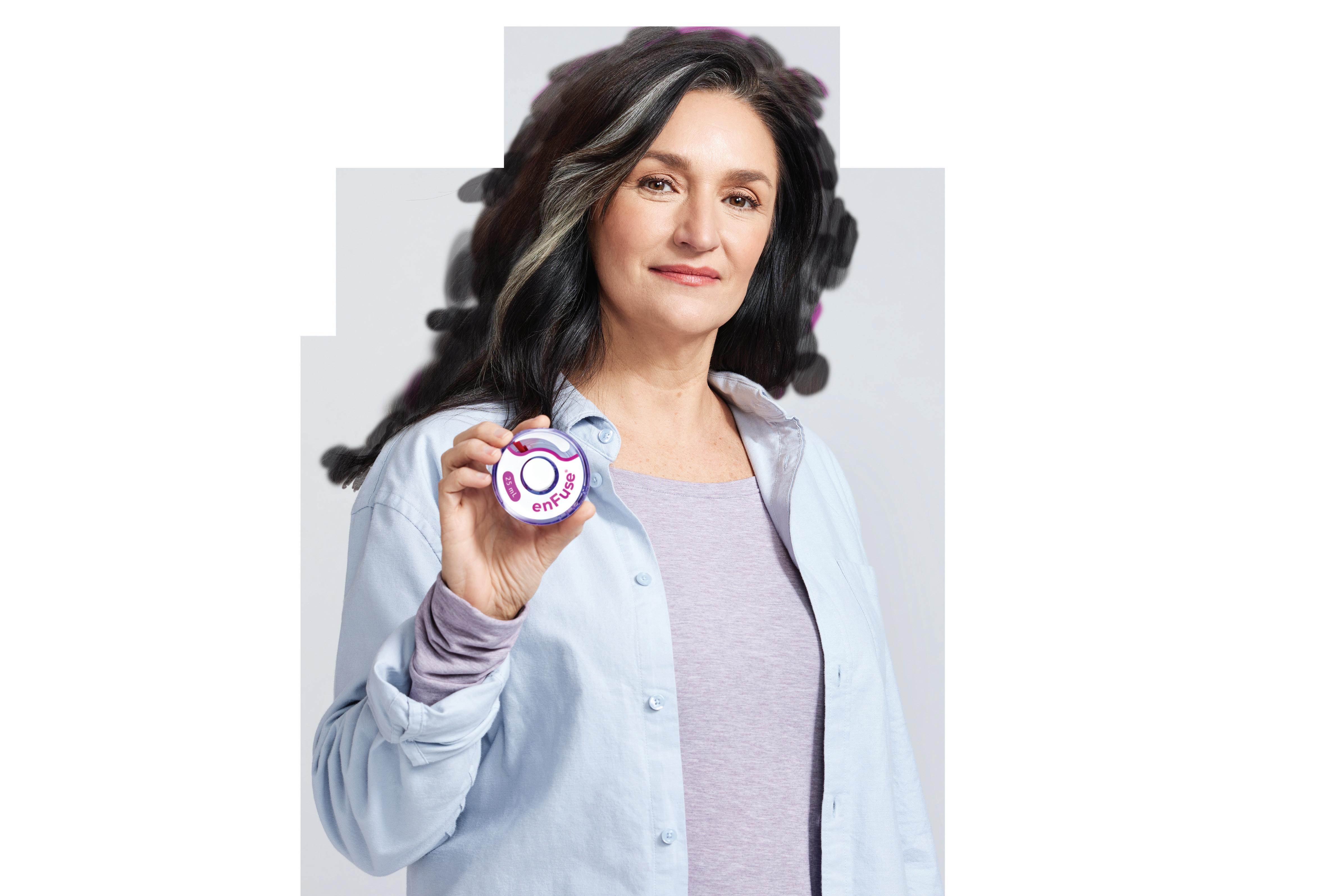
The vital role of patient self-administration of medication was highlighted during the lockdowns of the covid-19 pandemic. Conflicts around the world only add to the challenges of managing chronic conditions – creating drug shortages, for example, as well as difficult conditions for taking care of health needs. In addition, the characteristics of many new drugs mean that they often require specific drug containers.
All these factors mean that the concept of lifecycle management for medical devices is becoming a key topic in pharmaceutical resource management. Regulatory authorities are requiring drug delivery systems (DDS) to be reusable in multiple situations – increasing efficiency and reducing medical waste. How to increase the reuse of a DDS while being compatible with diverse drug containers has become an important issue.
Quick Dose is a revolutionary reusable on-body injector (OBI) designed and developed to address the challenges of drug container compatibility and extend the lifecycle of DDSs. The device aims to provide a more efficient and comfortable drug delivery method for patients and meet the evolving needs of the pharma and biotech industries, public health and even military personnel.

Quick Dose was developed by CCBio, which has a strong technical background and has focused on developing DDSs for more than two decades. By integrating Taiwan’s electronic components and medical information resources, the company has achieved medical mechatronics capabilities. The new Quick Dose OBI is designed to address the challenges of subcutaneous (SC) drug delivery in many different scenarios.
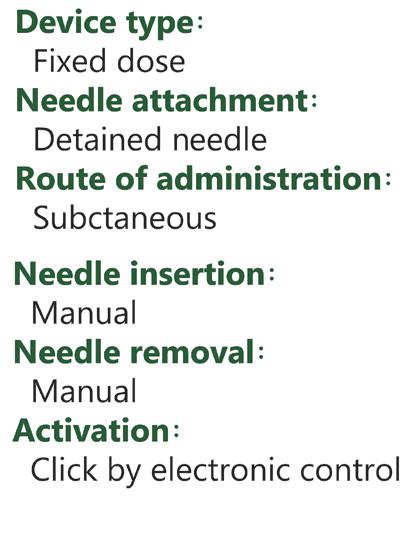
Quick Dose consists of three components: a reusable infusion driver, a disposable injection device and a drug container (Figure 1). This design also aligns with the industry’s increasing interest in SC drug formulations and wearable OBI medical devices.
Quick Dose preserves the compatibility specifications of drug containers, allowing pharmaceutical companies to focus more on the therapeutic effectiveness of their drugs. Quick Dose can be applied to mainstream drug containers, including infusion bags, cartridges and prefilled syringes (Figure 2).

Quick Dose also takes into account the necessary hygiene and safety factors. The needle set and drug solution circulation catheter are integrated into a disposable patch, ensuring that the item can be discarded after use. This design achieves a balance between safety and product integrity.
Quick Dose has a reusable infusion driver (Figure 3). The fully customisable programmability empowers patients to take control of their treatment, making their daily life easier and more comfortable. The user interfaces of Quick Dose are well designed and technologically advanced, featuring options for WiFi, near field communication and Bluetooth connectivity.
The Quick Dose device has undergone successful preliminary design verification testing studies. CCBio used a standard 100 poise viscosity solution without any drug
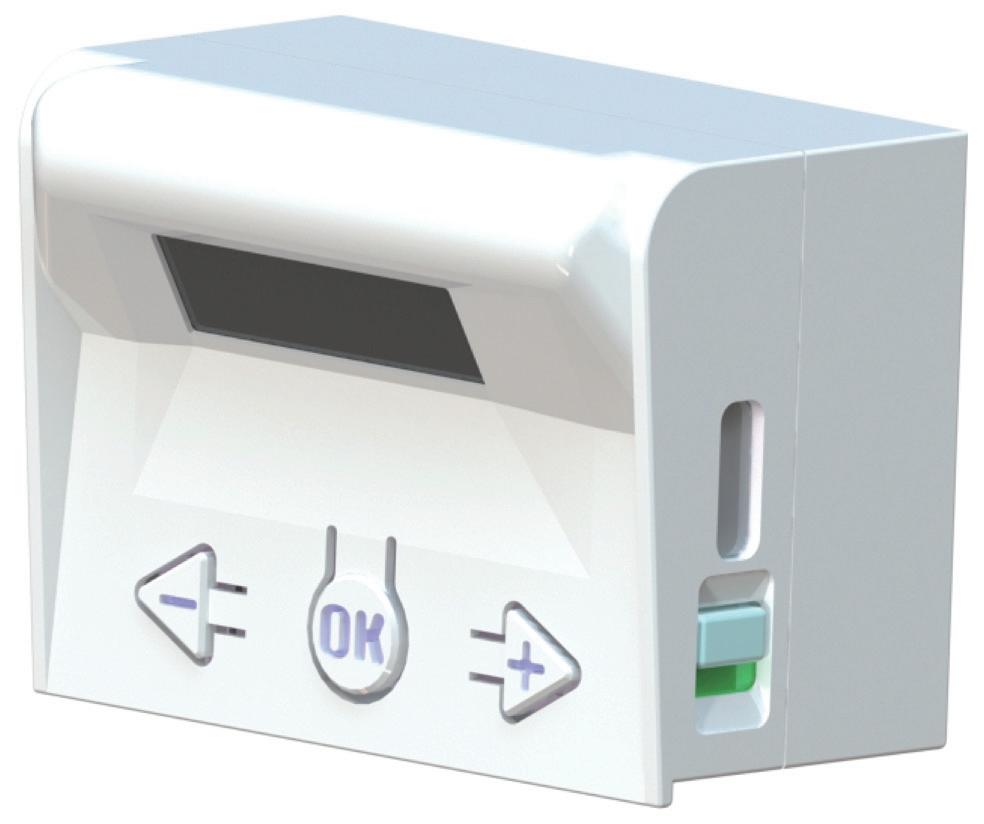
contents. The company tested mainstream drug containers of 21 mL infusion bags, 5 mL prefilled syringes and 3 mL cartridges.
From the results, the Quick Dose device proved drug delivery capability to handle injection from a drug container within one hour.
“The fully customisable programmability empowers patients to take control of their treatment, making their daily life easier and more comfortable.”

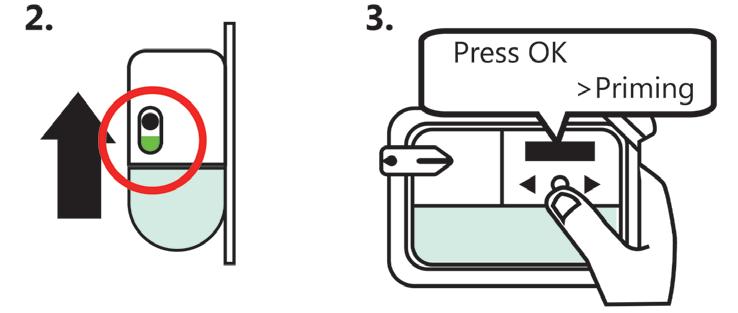
Assemble the cassette and the controller together. Switch on the power. Follow the instruction.
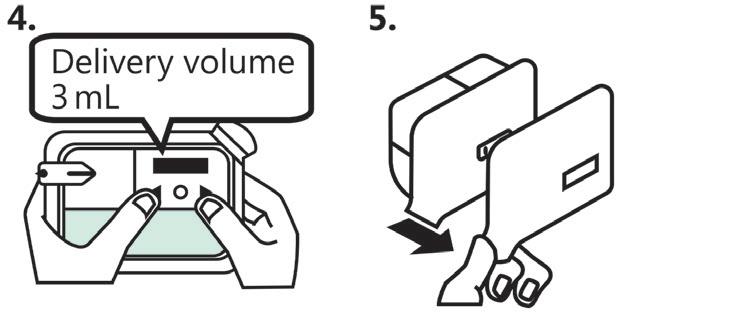

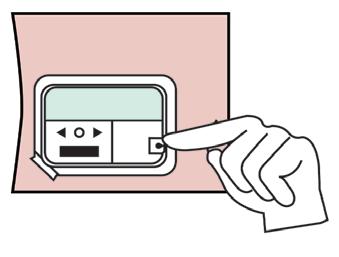
Select the dose. Peel pull tab to expose adhesive. Place the device on the skin.
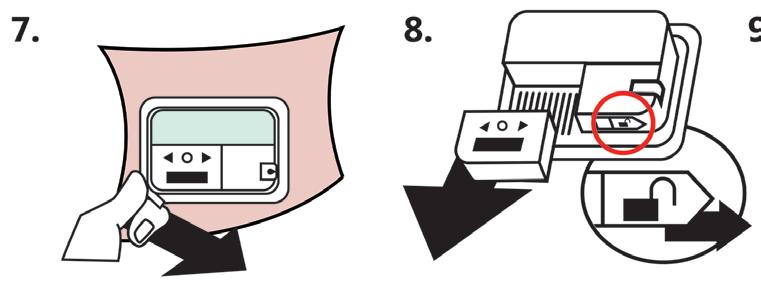
Remove the device after the injection.

Separate the controller from the cassette.
Make sure the controller is in off state.

Dispose of the cassette in a sharps disposal container.
From the perspective of both regulatory departments and pharmaceutical companies, OBI products are an emerging product category. Quick Dose focuses on usability formative evaluation. During the design phase and prior to formal tool development, a cognitive walkthrough approach was used to conduct formative evaluations of the Quick Dose device. The evaluation of Quick Dose includes assessment of device operation and captures feedback on the use process, serving as a guide for enhancement of the user interface design.
After completing the usability formative evaluation, it was shown that Quick Dose can be used correctly simply by reading the instructions for use (IFU) beforehand, without complicated training (Figure 4). One of the intended user groups is laypersons, and there are no significant differences in user profiles within the layperson user group.

Jimmy Fan
Marketing Vice-President
T: +886 384 5868
E: jimmyfan@ccbio.com.tw
CCBio
No. 68, Gongye 5th Rd Annan District Tainan City 709015
Taiwan
www.ccbio.com.tw
Here, Simon Bürdel, Industrial Design & Human Factors Expert, and Reza Abedian, PhD, Senior Medical Affairs Manager, both at Gerresheimer, discuss the importance and value of conducting human factors studies and user consultations above and beyond regulatory requirements when designing user-centric devices for subcutaneous self-injection in at-home settings.
In recent years, the healthcare and life science industries have seen a change in how biologics are commonly administered. Therapeutics that were previously solely administered via the intravenous (IV) route in a clinical setting are now also being developed for subcutaneous (SC) administration at home. This transition is being driven by the potential for cost savings, shorter injection times, reduced burden on healthcare providers (HCPs) and increased convenience for patients.1–3 In fact, many leading pharmaceutical companies are responding to this shift in preference and developing IV and SC formulations in parallel, rather than seeking approval for the IV formulation first. However, ensuring that patients can correctly and safely self-administer SC injections is a critical challenge, as errors could lead to underdosing or decreased adherence, which may impact a therapy’s effectiveness.4
“Ensuring that patients can correctly and safely selfadminister SC injections is a critical challenge, as errors could lead to underdosing or decreased adherence, which may impact a therapy’s effectiveness.”
Organisations developing devices for self-administration must, of course, prioritise safety, performance and regulatory compliance. However, in order to deliver an optimal device that meets the needs of users, pharma companies, healthcare systems, supply chain members and the environment, there are many other factors to consider, including:
• Ease of use
• Storage
• Place of use
• Instructions for use (IFU)
• Connectivity
• Packaging
• Sustainability.
Developing product solutions that are user-centric and respond to the diverse needs and pain points of various stakeholders will therefore require extensive research and direct input and feedback from users.
According to Donald A. Norman, a prominent expert in cognitive science and advocate for user-centric design, “We need to build products that work the way people expect them to work”. This adage applies well to the pharmaceutical industry. If the development of a medical device is driven by technology alone, one might bring a functional device to market that performs well. However,

Simon Bürdel
Industrial Design & Human Factors Expert
T: +41 625 44 16 98
E: simon.buerdel@gerresheimer.com

Dr Reza Abedian
Senior Medical Affairs Manager
T: +41 625 44 16 33
E: reza.abedian@gerresheimer.com
Gerresheimer
Advanced Technologies Division Solothurnerstrasse 235
CH-4600 Olten
Switzerland
www.gerresheimer.com
without iterative user testing, the resulting product may not fully address the needs and expectations of patients. This may negatively impact all stakeholders and lead to potential use-errors. To ensure that medical devices address the correct needs and pain points of all potential users, it is necessary to consult not only patients but also lay caregivers, nurses and physicians.
To ensure safe use, US FDA Guidelines and IEC Standards demand a riskbased human factors (HF) and usability engineering approach. Manufacturers must identify critical tasks, develop and implement risk mitigations, and carry out iterative formative evaluations and a final summative evaluation. The product will be deemed safe and effective for use once all the relevant evidence has been generated and documented.5–7
This process, which is referred to as usability engineering, is comprised of four stages:
1. User research via interviews and surveys to identify specific user needs
2. Analysis, identification and categorisation of hazard-related use scenarios
3. Design and implementation of a user interface and completion of formative evaluations
4. Summative evaluation, which is the final usability validation of a device.
In addition, applying a comprehensive user-centric design approach not only relies
“Negative feedback is equally valuable and, in this instance, these patients made a critical point –in oncology care, patients often develop a close relationship with their care team, particularly as side effects in immunotherapy can be varied.”
on data collection and observation, but also seeks qualitative feedback on the user experience and subjective opinions of a presented solution, which goes beyond technical and regulatory requirements.
In response to its continuous monitoring of user needs and market trends, Gerresheimer initiated a development project for an on-body SC device for delivery of largemolecule drugs. The predominant factors that influenced this decision were:
• A progressive shift from IV to SC injection as a preferred route of administration
• The potential for supporting patient independence through home therapy delivery
• The growth of biopharmaceuticals in product pipelines
• An increasing focus on sustainability from end users and the pharmaceutical industry.
In order to validate these market trends and user needs, Gerresheimer began by gathering patient preference information (PPI). Such user input collected at a very early stage of device development provides valuable insights into user needs. Gerresheimer focused its PPI study on administration of immunotherapy with monoclonal antibodies for oncology care. Patients and HCPs completed online surveys and in-person interviews.
Overall, 75% of 32 US patient participants had a positive view of at-home SC administration, compared with in-clinic IV administration. Alongside the positive responses to at-home administration, researchers also received feedback from 12% of patients that they would prefer to go to a clinic, as they felt that they would miss the contact with their HCP, and another 13% who would refuse to receive their therapy at home (Figure 1).
In addition, 68% of patients had a positive opinion of an on-body SC injection device compared with a standard manual injection by a syringe carried out in a clinical setting. Moreover, HCPs provided similar responses – they reported that less time may be required to prepare for SC injections, which could potentially free up more time for patient consultation.
In research, it can be tempting to look past the patients who say “no”, especially if they represent a small percentage of study participants. However, negative feedback is equally valuable and, in this instance, these patients made a critical point – in oncology care, patients often develop a close relationship with their care team, particularly as side effects in immunotherapy can be varied. This patient feedback emphasised the potential for digital health solutions to facilitate connection between patients and healthcare teams and support symptom management. Gerresheimer’s development team therefore incorporated connectivity into its large-molecule device concept.
Following the positive outcome of the PPI study, Gerresheimer moved ahead with the development of an on-body SC device platform for biopharmaceuticals. The resulting cartridge-based system, Gx SensAir®, handles volumes of up to 10 mL as standard and viscosities of up to 50 cP. Beyond the functional and safety requirements for delivering sensitive biologics, two other principles guided the concept design – user-centricity and sustainability.
In response to these principles, the Gx SensAir® is partially reusable, featuring a two-part design with a reusable electronics unit and a sterilised disposable unit containing the needle. A prefilled cartridge with the medicinal drug product is separately refrigerated and inserted into the disposable unit before the two parts are clicked together. This design can reduce total treatment costs, waste and carbon footprint by minimising shipping, sterilisation and cold storage requirements (Figure 2).
To address the patient treatment experience, the Gx SensAir® includes simple one-button operation, a light indicator that leads the user through the therapy step by step and an observation window for monitoring injection progress. The reusable unit also incorporates Bluetooth connectivity for data transfer and the possibility to connect to a digital health system, such as the Aptar Digital Health software platform for oncology.8
Identifying and addressing potential issues early in the product development process through an HF study allows for modifications to be made, re-tested and further refined in subsequent studies. As the sustainable two-part design concept for the Gx SensAir® requires some user assembly, it was imperative to confirm that all


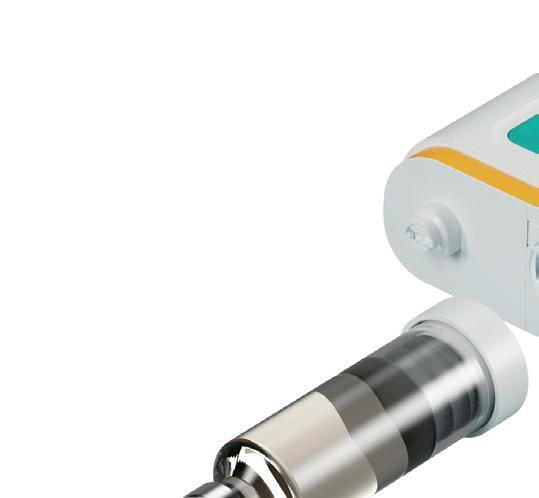
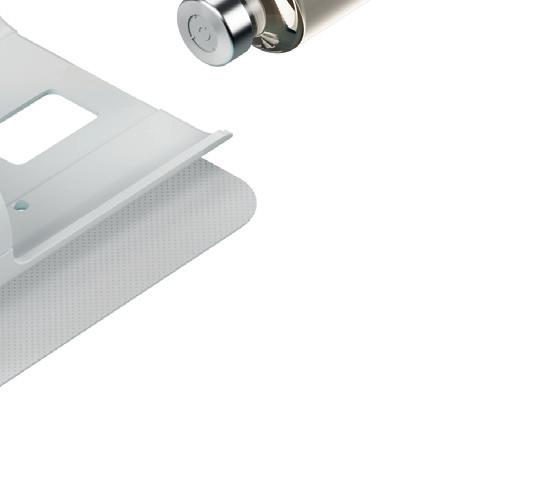
potential users could effectively assemble the device and apply it onto the body. It was also important to ensure that this sustainable concept was well accepted.
The first formative study with 10 participants concluded in January 2023, at Gerresheimer’s Advanced Technologies division in Olten, Switzerland. The primary objective of this study was to evaluate the device’s user interface (UI) to discover unanticipated use errors, test and optimise the user interface and discover potential foreseeable misuse cases for the device.
Device set-up, administration and disposal of the Gx SensAir® were tested with healthy lay users. Five key potential use errors were observed. Design mitigations were implemented directly into the development of a second prototype to optimise device railings, cartridge insertion, injection feedback LEDs, liner removal and the release mechanism. The feedback from this study was critical, as it enabled Gerresheimer to further optimise the device design to make it even safer, easier and more effective for users.
“As the sustainable two-part design concept for the Gx SensAir® requires some user assembly, it was imperative to confirm that all potential users could effectively assemble the device and apply it onto the body.”
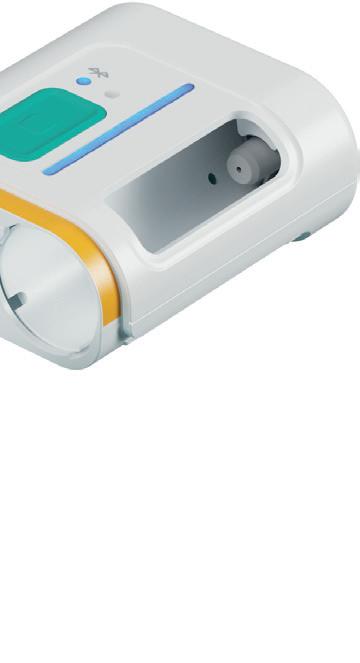

Figure 2: The modular, sustainable design of the Gx SensAir® on-body drug delivery device for biologics.
With the design mitigations from the first study implemented, another formative study was conducted in February 2024 in London, UK, with 30 participants. The scope was extended to the Gx SensAir® system and UI, including storage, device set-up, administration and disposal. The sessions were structured with simulated use testing, root cause analysis (RCA), knowledge-based assessment (KBA), a second RCA, subjective feedback gathering, conclusion and debriefing. In total, four different user groups were tested:
• Eight adult patients with multiple sclerosis (MS)
• Seven HCPs with experience in treating patients with MS
• Seven adult oncology patients with HER2 positive breast cancer
• Eight HCPs with experience in treating oncology patients.
The patient cohorts were split into injection-experienced and injection-naïve. The patients tested the device on an injection belt, while the HCP cohort carried out the administration on a mannequin. The results confirmed that design modifications implemented following the previous study effectively mitigated the identified use errors and difficulties (Figure 3).
During the subjective feedback session, participants were asked to rate their satisfaction and ease of use of the device on
a five-point Likert scale. 67% of participants rated usage as “Easy”, and an additional 23% rated the device as “Very Easy” to use (Figure 4), with the remaining 10% as “Neutral”. Some participants who rated the ease of use as Easy or Neutral attributed their responses to the fact that it was their first time using the device. The results also showed that participants appreciated the device, with 53% stating that they were “Satisfied” and the remaining 47% stating that they were “Very Satisfied”.
Participants were asked to give their feedback on their preference for receiving therapy at home or in the hospital.
28 out of 30 participants (93%) said they would prefer to take their therapy at home. The reasons that participants gave for home injections being preferable included:
• Waiting times in hospitals
• Travel to the hospital
• Convenience
• Need for childcare
• Reducing pressure on the UK NHS.
HCPs stated that at-home injections would give patients more independence and freedom. Some stated that it would reduce pressure on hospitals, which could reduce waiting times and help solve capacity issues. Some HCPs also pointed to the risk of acquiring infections in hospitals and the potential impact of this on patients with chronic conditions (Figure 5).
Participants were also asked to give their feedback on sustainability and their preference for a reusable or single-use device. 28 out of 30 participants (93%) overwhelmingly stated a preference for a reusable device. Most of participants stated
this was due to the environmental impact of single-use devices and that they would want to reduce waste and plastic. No participant stated a preference for single-use devices.
As outlined in this article, user feedback is critical in order to ensure that a medical device for at-home use not only meets fundamental safety and performance requirements but also supports quality of life for patients with chronic conditions. Carrying out online surveys and contextual inquiries in the early product development phase can help confirm requirements identified from market monitoring and evaluation. Further feedback gathered through iterative formative evaluations,
in the form of usability studies, can reconfirm the original conclusions and ensure that the device meets user expectations and needs.
“The studies also suggest that sustainability awareness is a big topic for the industry, as both patients and HCPs stated a preference for a reusable device over a disposable one, even when this involves additional user steps.”
Figure 5: Study participant preference for at-home care versus treatment in a hospital or clinic.
These needs can vary according to the indication of a disease, as well as the mental, cognitive and dexterity abilities of the patient, so it is crucial that more than one user group is consulted. As discussed here, the studies conducted by Gerresheimer relating to the Gx SensAir® on-body device have shown that most patients and HCPs prefer that patients are able to administer their medication at home. The studies also suggest that sustainability awareness is a big topic for the industry, as both patients and HCPs stated a preference for a reusable device over a disposable one, even when this involves additional user steps.
Gerresheimer’s aim is to innovate and deliver for a better life every day. The evolution of the Gx SensAir® on-body device for self-administration illustrates the value of user input to fulfil this mission. It also highlights that negative feedback is as important as positive, as it helps ensure that devices meet the needs and expectations of all users in order to improve patients’ quality of life.
Gerresheimer is an innovative systems and solutions provider and global partner for the pharma, biotech and cosmetic industries. The company offers a comprehensive portfolio of pharmaceutical containment solutions, drug delivery systems and medical devices, as well as solutions for the health industry, with its product range including digital solutions for therapy support, medication pumps, syringes, pens, autoinjectors and inhalers, as well as vials,
ampoules, tablet containers and infusion, dropper and syrup bottles. With 35 production sites in 16 countries in Europe, the US and Asia, Gerresheimer has a global presence and produces locally for regional markets. With around 12,000 employees, the company generated revenues of around €2 billion (£1.7 billion) in 2023.
1. Dychter SS, Gold DA, Haller MF, “Subcutaneous drug delivery: a route to increased safety, patient satisfaction, and reduced costs”. J Infus Nurs, 2012,
Vol 35(3), pp 154–160.
2. Bittner B, Richter W, Schimdt J, “Subcutaneous Administration of Biotherapeutics: An Overview of Current Challenges and Opportunities”. BioDrugs, 2018, Vol 35(5), pp 425–440.
3. Tetteh EK, Morris S, “Evaluating the administration costs of biologic drugs: development of a cost algorithm”. Health Econ Rev, 2014, Vol 4(1), article 26.
4. Tjalma W, Huizing MT, Papadimitriou K, “The smooth and bumpy road of trastuzumab administration: from intravenous (IV) in a hospital to subcutaneous (SC) at home”. Facts Views Vis Obgyn, 2017, Vol 9(1), pp 51–55.
5. “IEC 62366-1:2015: Medical devices – Part 1: Application of usability engineering to medical devices”. IEC, 2015.
6. “Guidance for Industry: Applying Human Factors and Usability Engineering to Medical Devices”. FDA, 2016.
7. “ANSI/AAMI HE75:2009 (R2018) Human factors engineeringDesign of medical devices”. ANSI/AAMI, 2018.
8. McKeon D, Yoon S, “Bringing Digital Health and Drug Delivery Together to Support Subcutaneous Injection in Oncology”. ONdrugDelivery, Issue 162 (Jun 2024), pp 10–14.
Simon Bürdel is an Industrial Design and Human Factors Expert at Gerresheimer’s Advanced Technologies division. With over 10 years of experience in the field of design and usability, his expertise includes user experience, human factors, and user- and human-centric design. Mr Bürdel holds a BA in Product and Industrial Design from ZHdK Zurich University of the Arts (Switzerland) and is a certified Professional for Usability and User Experience. He is passionate about creating intuitive and user-friendly products and has won several design awards.
Reza Abedian is a Senior Medical Affairs Manager at Gerresheimer. He specialises in medical affairs and clinical research, supporting value-based product development, focusing on patient centricity. He holds a PhD from Hannover Medical School (Germany) and has supported the product development and market authorisation of various medical devices in several regions including the US, EU and other global markets, while having worked in multiple sectors of the medical device and pharma industries. A guest professor at the University of Applied Sciences Northwestern Switzerland, Dr Abedian teaches the introduction to the quality management systems, postmarket surveillance and combination products module of the joint MSc in Biomedical Engineering at Basel University (Switzerland).



On-body injector that empowers self-administration of biologics
Patient-centric
Lightweight with simple usage & automated injection
Sustainable
Reusable, recyclable electronics unit reduces waste
Connected
Bluetooth for data transfer & adherence monitoring
Here, Anna Allegro, Product Manager Drug Delivery Systems, and Andrea Cuccato, PhD, Hardware Development Engineer, both at Stevanato Group, discuss how the company’s Vertiva® on-body delivery system exemplifies a platform technology approach to device design, with its 3 and 10 mL formats providing the flexibility necessary to accommodate a wide variety of therapies.
On-body delivery systems (OBDSs) present an increasingly powerful opportunity for achieving better patient experiences and outcomes by supporting the ongoing shift from intravenous (IV) to subcutaneous (SC) drug delivery. With expanded treatment options that are able to accommodate larger volumes, as well as more concentrated and viscous formulations, OBDSs can provide the means to reduce injection frequency compared with other lower-volume delivery devices, while also introducing the convenience of wearable technology. These are all factors that, taken together, allow OBDSs to help address the key challenge of medication adherence, which compromises treatment effectiveness for an estimated 30–40% of those with long-term conditions – and an even higher proportion of patients affected by certain other diseases.1,2
Such benefits have intensified the interest in OBDS development in recent years, but this has not necessarily translated into a flood of product launches. Indeed, since July 2016, only five OBDSs with a dose volume of 3 mL or greater have reached the market. At a quick glance, these devices could be mistaken for variants of off-the-shelf products, much like pen injectors can be based on the same underlying technology. However, this type of approach is rarely viable for OBDSs, each of which will be targeted at a specific therapy area and must be uniquely tailored to control the delivery of a specific drug formulation according to a defined injection profile.
“Rather than thinking of OBDS development in terms of platform products, pharmaceutical companies can realise benefits by adopting a platform technology approach, defined by far higher levels of versatility.”
While the architecture of an off-the-shelf product might be able to accommodate minor adjustments or component changes to suit the requirements of a specific application, such devices are generally designed for a specific purpose, leaving comparatively little scope for adaptation. Supporting the requirements of an OBDS, meanwhile, requires a necessarily higher level of customisation that can never truly be supported by a pre-determined approach.
Therefore, rather than thinking of OBDS development in terms of platform products, pharmaceutical companies can instead gain an advantage by adopting a platform technology approach, defined by far higher levels of versatility. Platform technologies are built on a foundation that supports the creation of customisable products tailored

Anna Allegro
Product Manager Drug Delivery Systems
E: anna.allegro@stevanatogroup.com

Dr Andrea Cuccato
Hardware Development Engineer E: andrea.cuccato@stevanatogroup.com
Stevanato Group Via Molinella 17 35017 Piombino Dese Padova Italy
www.stevanatogroup.com
to a specific therapeutic requirement. Everything revolves around a consistent core technology that can be reconfigured in terms of its specific functionality according to different delivery profiles and fill volumes. Beyond these reconfigurations, there is also potential to customise the user interface of the device to further optimise the patient experience.
Stevanato Group has developed the Vertiva® OBDS using a highly versatile platform technology model. For pharmaceutical companies, it provides the strengths of a foundational system with the flexibility to be adjusted and adapted according to patient needs across a diverse range of applications (Figure 1). Two versions of the Vertiva® platform have been developed so far – 3 and 10 mL (Figure 2) – both of which share:
• A core technology comprising a single-use injection unit (the “pod”)
• A reusable smart controller that manages the activation process
• A proprietary magnetically coupled drive mechanism that connects the pod and controller, enabling contactless power transfer between the two.
In both configurations, the mechanical pod is designed to house prefilled and preloaded glass cartridges, which simplifies set-up for the patient by removing the need to manually fill or load the device. During administration, needle insertion and retraction is automated to ensure the safe and accurate SC delivery of the specified dose. At the same time, body-sensing technology prevents premature activation. From a user’s perspective, these intuitive design attributes limit manual intervention and help facilitate treatment initiation.
The reusable controller, meanwhile, can be programmed with relevant delivery profiles, supporting multiple therapy cycles (Figure 3). This dynamic removes the need for the pod to incorporate electronic components, increasing its resilience while also limiting its overall environmental impact. Optionally, data on patients’ device usage can be recorded by the controller and then transferred via Bluetooth.
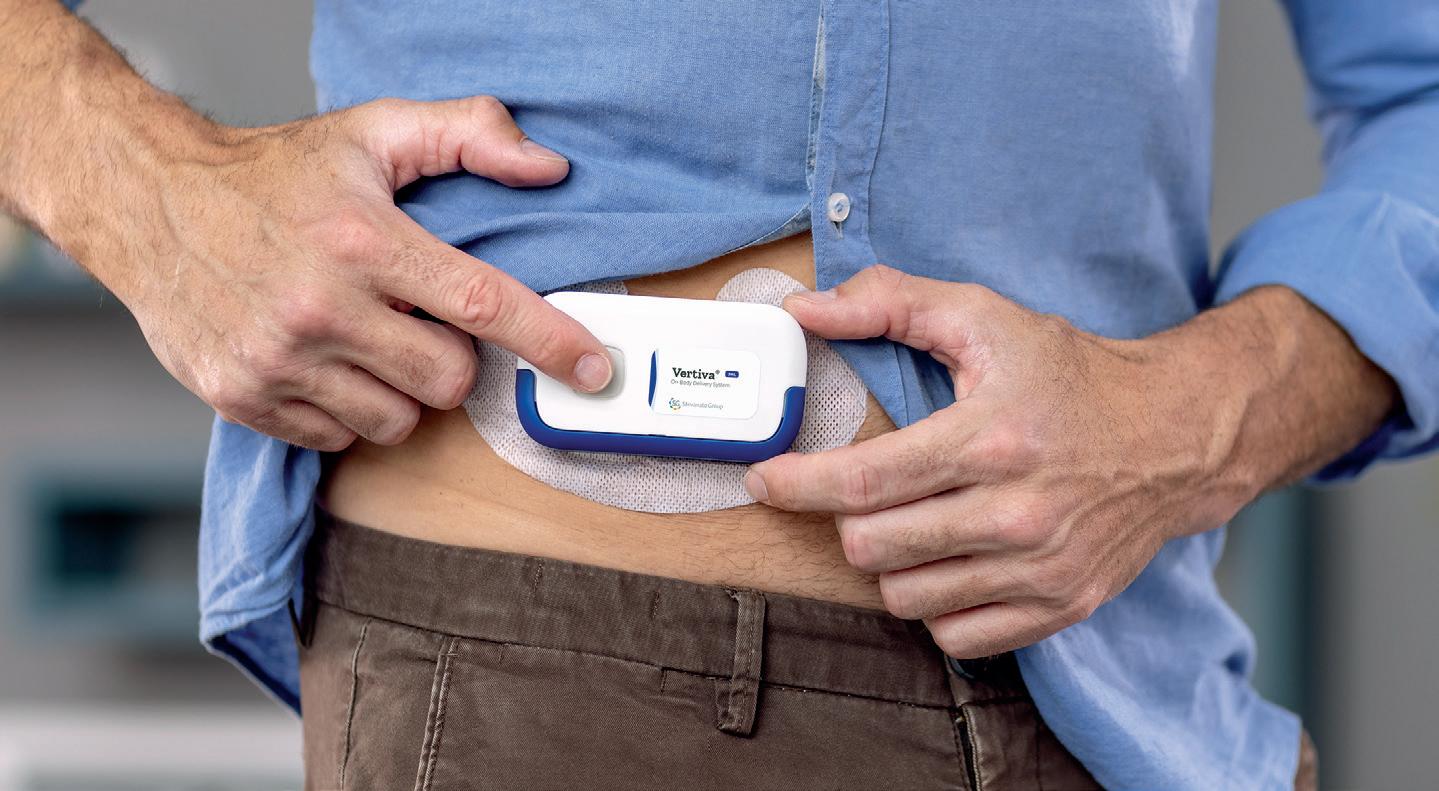
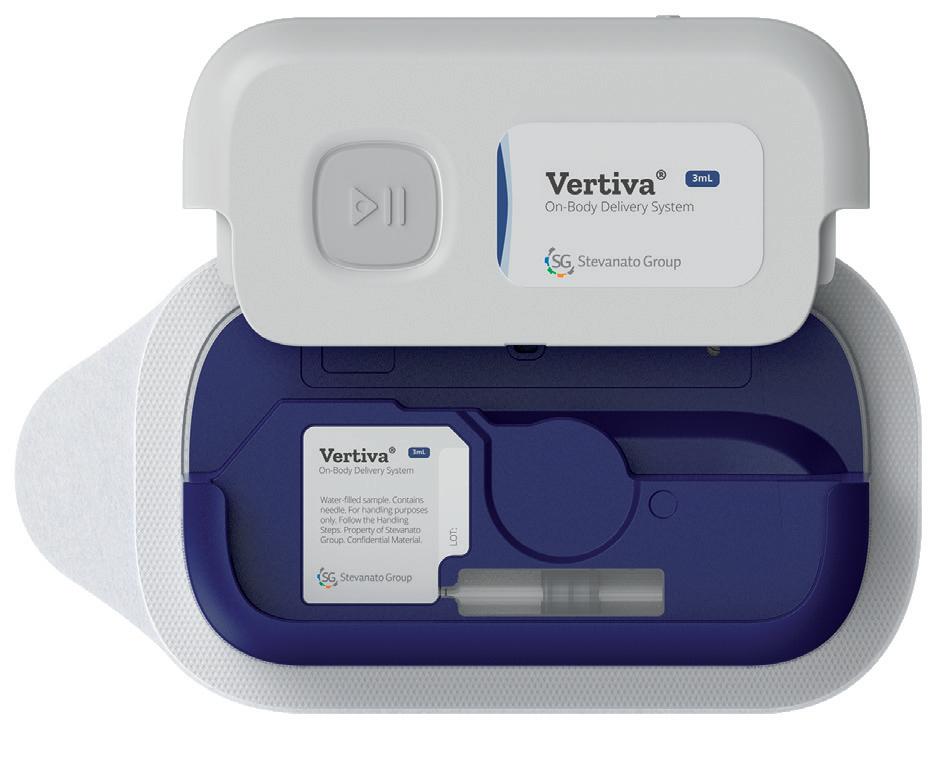
The single-use pod with prefilled and preloaded cartridge
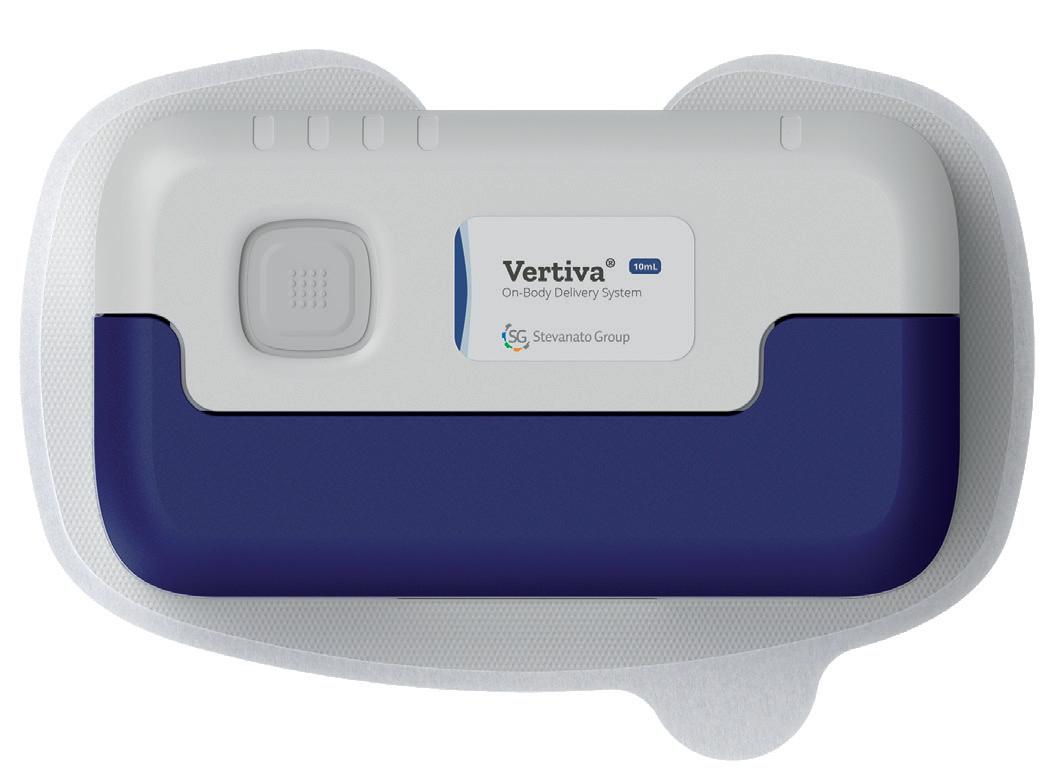
Figure 2: Vertiva®, Stevanato Group’s next-generation OBDS for large-volume drug delivery, available in 3 and 10 mL formats.
Based on this underlying structure, which is common to both configurations of Vertiva®, Stevanato Group has optimised the current 3 and 10 mL platform versions for two different application types. In the case of Vertiva® 3 mL, this platform version has been developed as an OBDS infusion pump ideal for the delivery of complex small-molecule therapies, where drug product volumes are comparatively low. In particular, the device can be configured to discreetly deliver micro-precision non-monotonic basal delivery, with the additional option
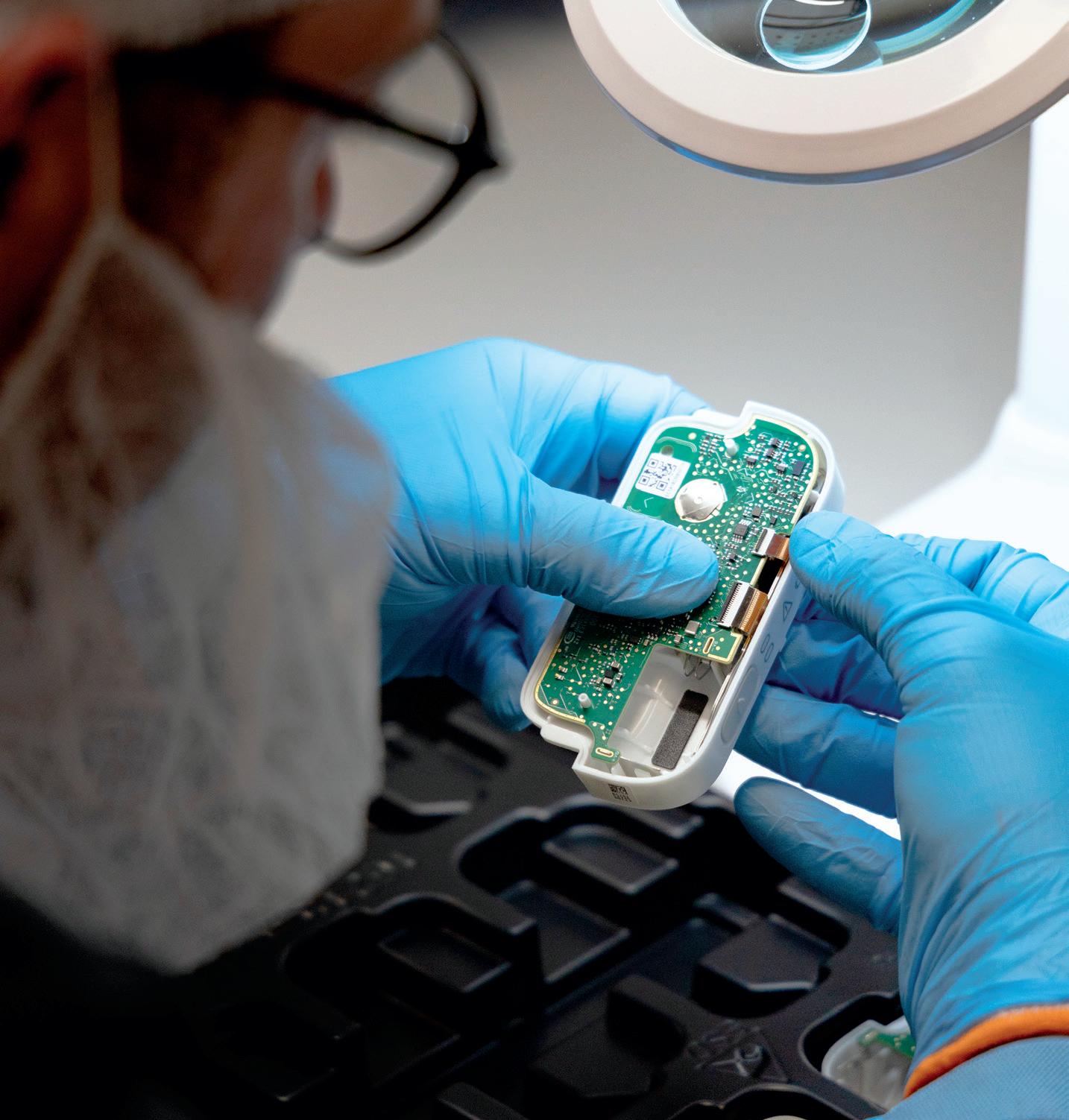
of on-demand boluses restricted to a limited number over a given period. In its 10 mL form, the Vertiva® OBDS has been developed as an OBDS injector optimised to support the delivery of fullcontent bolus injections of highly viscous large-volume biologics.
These figures underline some of the key differences between Vertiva® in its 3 and 10 mL configurations, even though the devices are based on the same core platform. Achieving this variance demands careful consideration of multiple device characteristics and components for Vertiva® to be optimised in the form of either a small-molecule infusion pump or an OBDS injection device for biologic delivery.
Optimisation of the Vertiva® platform is achievable thanks to its inherent flexibility, which allows the device to support various therapy profiles within physical dimensions that meet the acceptable thresholds for an OBDS. There are, however, important technical considerations when accommodating the continuing trend of
drugs with increasingly higher viscosities. For example, where large boluses of very viscous drugs are to be delivered in a short timeframe, and therefore at a high flowrate, more electromechanical power is required. While a potential solution would be to upscale the device components, this would conflict with the imperative to restrict device dimensions. Power must therefore be transferred with maximum efficiency from the electromechanical drug delivery sub-system without compromising the overall range of flow rates possible, as this would restrict the therapy profiles that can be supported.
The core Vertiva® platform technology has been developed by Stevanato Group to allow the electromechanical subsystem to be optimised in light of these requirements. Thanks to the precise design of the motion transmission gearing stages, the efficiency of the electrical motor is maximised at peak power demand, where design constraints are most limited because the gearing torques and rotational speeds are highest. This has been achieved without narrowing the overall range of drug viscosities and delivery flow rates that can be supported within a single OBDS version.
This process is exemplified by the Vertiva® 10 mL platform OBDS version. Here, the efficiency of the drug delivery subsystem has been optimised to allow for the delivery of a 10 mL single bolus of a drug solution with a viscosity of 25 cP within five minutes. The same device, however, remains capable of supporting the delivery of a broad range of drug viscosities, from aqueous-like solutions in the lower range up to highly viscous products of 100 cP and above.
However, customisation of the Vertiva® platform is not exclusively focused on expanding the discrete bolus injection profile – the platform has also been designed to accommodate the contrasting requirements of the basal micro-dosing profiles typical of infusion pumps. Here, as well as the requirement to maximise power efficiency, there is a parallel requirement to control delivery of small drug volumes with a very high dose accuracy. These delivery approaches often have conflicting drivers for the design of the mechanical gearing subsystem, introducing a duality that can present a technical challenge. In the development of a 3 mL infusion pump version of the Vertiva® platform technology, however, Stevanato Group has been able to accommodate these needs, with targeting of basal infusions possible over an up-to-24hour period and with a single basal pulse resolution as small as a few microlitres.
The ability to overcome these challenges and bring such versatility into the platform stems from the highly accurate modelling of the electromechanical subsystem by Stevanato Group’s engineering team. Following initial development, each individual sub-system involved in the drug delivery process is subject to subsequent refinement through iterations of characterisation and optimisation, which encompass both the parameters of the model and the model itself.
All considerations relating to power and efficiency for the bolus injection are centred on the energy source, which is typically a battery for an OBDS. High demands are placed on the capabilities of this internal electrical energy storage, driven by the combination of high formulation volumes and viscosities, short delivery times and the need to serve a range of therapies with a single controller. In device development, this can open discussions around whether to equip the device with either a replenishable energy source, achieved through either battery recharging or replacement, or a
non-replenishable one. Because either option could represent the optimal solution depending on a customer’s needs, Stevanato Group has ensured that the Vertiva® platform technology has been developed with both in mind.
Such decisions involve weighing up a variety of factors. Employing an updateable energy source, for example, can improve the reusability of the controller element and, therefore, its sustainability – the use of a rechargeable battery brings further benefits in this area. However, it is also clear that in applications where an OBDS has a low energy demand – as would be the case for treatments involving a limited number of therapy cycles, low-viscosity drugs or low delivery flow rates – the use of an embedded non-rechargeable battery can bring advantages in terms of reducing device dimensions and design complexity.
With the Vertiva® 10 mL version, Stevanato Group has been able to demonstrate the capability to address extended therapy models through the addition of battery rechargeability. Indeed, the controller can support dozens of injections spread over up to two years of continuous treatment. For patient convenience, quick charging was investigated as a key feature of the platform technology, with the aim of making the device ready for injection within 15 minutes from a low-battery condition. Wired charging via a USB-C connector simplifies this task for patients, ensuring an intuitive and reliable user experience.
From product design to manufacture, assembly and lifecycle management, there are clearly many elements to consider in the development of an OBDS. And as an integrated solution provider whose end-to-end offering extends from primary packaging to device design, development and manufacture, Stevanato Group has the breadth and depth of expertise to support pharmaceutical partners at all stages of product development as part of a risk-managed production process. The company’s scalable services in precision component supply and device sub-assembly are underpinned by a strong supply chain and a structure that allows for direct integration with a pharma partner and/or a CMO. However, Stevanato Group’s production proposition for both the 3 and 10 mL Vertiva® device
“Stevanato Group’s production proposition for both the 3 and 10 mL Vertiva® device configurations is significantly strengthened by its collaboration with Thermo Fisher Scientific.”
configurations is significantly strengthened by its collaboration with Thermo Fisher Scientific (Waltham, MA, US).
Together, Stevanato Group and Thermo Fisher can provide a streamlined, integrated and fully scalable framework for orchestrating the manufacture of a complete combination product system, from the first stages of formulation development and compounding through to aseptic filling of pre-sterilised EZ-fill® cartridges, final device assembly, serialisation and packaging. This has been supported with investment in a lowvolume final assembly line at Thermo Fisher’s site in Ferentino (Italy) for final assembly of both 3 and 10 mL devices, with minimal changes required to the manufacturing equipment components when switching between the different device configurations.
For pharmaceutical companies pursuing on-body drug delivery opportunities, Vertiva® represents a versatile end-to-end OBDS solution, whether employed for a particular application or as a platform that can sustain a pipeline of OBDS innovation. From the same core technology platform, Vertiva® has the flexibility to support a range of drug molecules, viscosities, volumes, delivery times and profiles. And,
with established compatibility between drug containment solutions and fill-finish techniques implemented as part of an integrated approach, the production and assembly process can be made smoother, accelerating time to market.
Looking to the future, the growth of OBDS applications looks set on an upwards trajectory. However, it is only by adopting a truly versatile platform approach that pharmaceutical companies can expect to unlock these opportunities in a way that delivers performance, impact and value.
Founded in 1949, Stevanato Group is a global provider of drug containment, drug delivery and diagnostic solutions to the pharmaceutical, biotechnology and life sciences industries. Stevanato Group delivers an integrated, end-to-end portfolio of products, processes and services that addresses customer needs across the entire drug lifecycle at each of the development, clinical and commercial stages. Stevanato Group’s core capabilities in scientific research and development, its commitment to technical innovation and its engineering excellence are central to its ability to offer value-added solutions to clients.
1. Garfield S, Judah G, “Learning from successes: designing medication adherence intervention research so that we can learn what works and why”. BMJ Qual Saf, 2022, Vol 31(2), pp 83–85.
2. Hichborn J et al, “Improving patient adherence through data-driven insights”. McKinsey & Company, Dec 2018.
Anna Allegro is a Product Manager at Stevanato Group, specialising in OBDSs. In this role, she leads product strategy and marketing initiatives across the entire product lifecycle. Ms Allegro holds dual degrees in Management and International Business from Bocconi University (Milan, Italy) and HEC Montreal (Montreal, Canada).
Andrea Cuccato, PhD, is a Hardware Development Engineer at Stevanato Group, where he has been contributing to the design and development of the company’s OBDSs. With a rich background spanning over a decade in the medical device industry, including a previous seven-year experience in Flex’s Milan (Italy) design centre, Dr Cuccato specialises in the creation of hardware electronics for portable low-power medical devices. Dr Cuccato holds an MS degree in Electronic Engineering and a PhD in Information Technology (specialising in Electronics), both from Politecnico di Milano (Milan, Italy).
CPHI Milan celebrates 35 years of pharma excellence – join the next generation of leaders, innovators & trailblazers.
Register now
8-10 October 2024
Fira Milano, Italy

At the heart of Pharma

Av a il a bl e in 3mL or 10mL for ma t , Ve rti v a ® is a n e xtge n e r a tion OB D S f eat u r ing a highly fl e xibl e d e liv er y tec hnolog y a nd p at i e n t - ce n tr i c d es ign T h e p r e- fill ed , p r e- lo aded p o d s i m plifi es u ser p re p arat i o n a nd , wh e n c oupl e d wi t h t h e m ulti -us e controll e r, e n a bl es t h e a d m ini strat ion o f a w i de r a n ge o f de li ve r y p rofil e s , f r o m b o lu s t o b asa l t h era p e u t i c re gi me n s T og et h er wi t h t h e ma nuf act u r ing of Vert iv a ® , S te v a n at o Gro up off ers a c o m p re h e n s iv e s ui te of op t ion a l p r odu cts a n d ser vi ces, in c luding d r ug co n ta in me n t s olu t ion s, a n a ly t i ca l ser vi ces, a nd e quip me n t f or fin a l assem bly a nd p ac k a ging T hi s uniqu e o ff er ing d e liv ers a n un p r e c ede nt ed s e t of int eg r a t e d solution s , e n a bling ph armace u t i ca l p art n ers t o ac hi e v e f a st e r ti me to ma rk e t an d r ed uc ed tot a l cost of o w n e rshi p

Here, Cécile Gross, Global Category Manager, Parenteral, and Mark Tunkel, Global Category Director, Services, both at Nemera, discuss how the company’s on-body injector platform – Symbioze® – has been developed by drawing on a combination of lessons learned from the history of injection devices and Nemera’s extensive experience developing drug delivery devices for the parenteral route.
When considering the delivery of injectables since the first human insulin injection more than 100 years ago, it is clear that the journey from then until now has been paved with many discoveries and improvements – especially when it comes to lessening the burden of disease on patients. From a drug perspective, many developments have led to an increase in the number of pathologies treated via this route, including rare diseases, and an expansion in the therapeutic areas addressed by to the rise of biologics. From a delivery device perspective as well, evolutions have been steady, much to the benefit of patients.
Returning to the insulin example, bulky reusable glass syringes were replaced by thin disposable plastic syringes with the primary benefit being a reduction in the needle thickness, which translated into less pain for patients during their multiple daily injections.1 Even if, from a cost perspective, a prefilled syringe or the combination of syringe and vial were – and still are –attractive, administering an accurate dose, carrying the device and, above all, dealing with the psychological aspects of coping with disease remained problematic.
The arrival of pen injectors in the 1980s enabled patients to overcome these factors. Dose accuracy was improved, followed by
clinical outcomes and, ultimately, patients’ adherence and acceptance. With regard to reducing the pain, pen injectors only require a low injection force to administer the dose thanks to their very thin single-use needles. Needle phobia is also more easily avoided with this type of needle compared with standard syringe needles.
Another positive aspect is the flexibility offered to patients – there is a variety of choices between reusable and disposable devices, between colours and shapes for younger patients, and between connected devices or standalone ones. When connectivity is desired, the technical solution selected to enable it becomes part of the patient’s continuous glucose management routine, often increasing compliance overall. Finally, the pen shape is discrete and easy to carry, helping with the aforementioned psychological aspects of the disease.
The next jump occurred in the 1990s with insulin pumps for continuous delivery, which have become small, compact, handy and effective. Connectivity offers the possibility to “close the loop” for blood glucose monitoring. Needless to say, managing such a pump requires training, involvement and financial capability on the part of the patient, but it definitely offers lifestyle flexibility without compromising reliability in dose delivery.
Recently, patch pumps seem to have begun replacing infusion sets. These devices are attached to the patient’s skin

Cécile Gross
Global Category Manager, Parenteral E: cecile.gross@nemera.net

Mark Tunkel
Global Category Director, Services E: mark.tunkel@nemera.net
Nemera 63 Avenue Tony Garnier 69007 Lyon France
www.nemera.net
via an adhesive, which is less invasive than tubing or a catheter. Beyond the commonly expected connectivity features, these pumps are usually equipped with advanced algorithms that enable patients to monitor their condition more closely.
In the same way that solutions provided to patients with Type 1 diabetes later spread to those with Type 2, the evolution in the treatment of diabetes and its comorbidities has led the way for other drugs and therapies. The current developments in injectables are fully benefitting from this evolution. The latest example is on-body delivery systems, which aim to provide bolus delivery of biologics in the fields of immunology, oncology and haematology.
In order to offer a comprehensive device range for injectables, Nemera has developed Symbioze® (Figure 1) – an on-body injector platform addressing both the challenges of large-volume delivery and sustainability with its reusable-disposable design. Building on the history of injectable pumps discussed here, along with the company’s extensive experience with pen injectors, patientfriendly features are an integral part of the Symbioze® platform.
Starting with the patch itself, the supplier has been carefully selected for its track record and ability to customise its shape to the device. The shape has been developed with a focus on applying insights gained from the in-house human factors studies conducted by Insight by Nemera
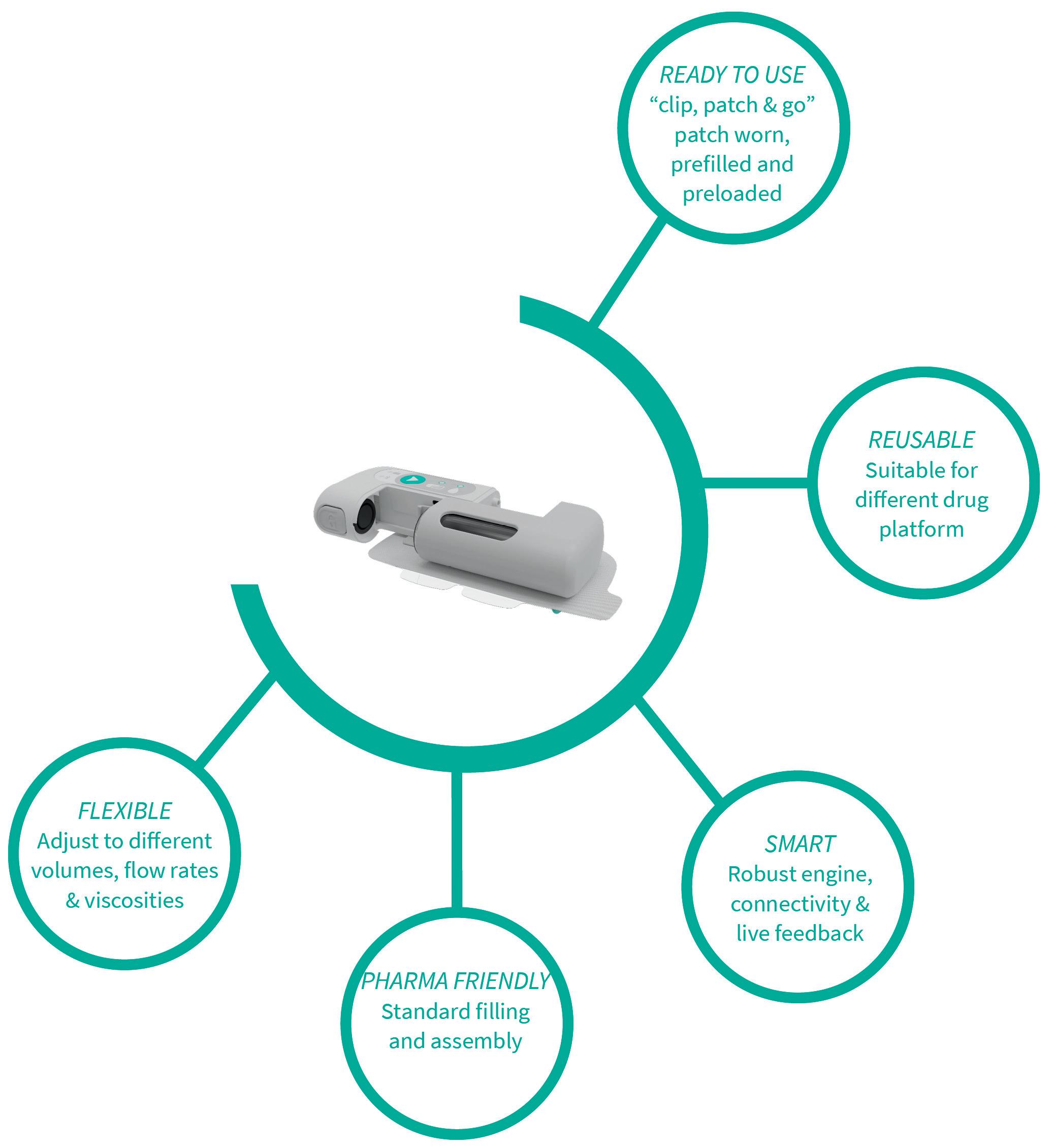
(Figure 2). Work is currently in progress to optimise the usability of Symbioze® by limiting the number of user steps and providing comprehensive instructions for use (IFU), which is expected to increase patient adherence (Figure 3).
As is standard for patch pumps, Symbioze® has automatic insertion and retraction of the needle, which makes the safety cap a must to avoid needlestick injuries. However, the drug is delivered via a soft cannula, which is reminiscent of the tubing used in
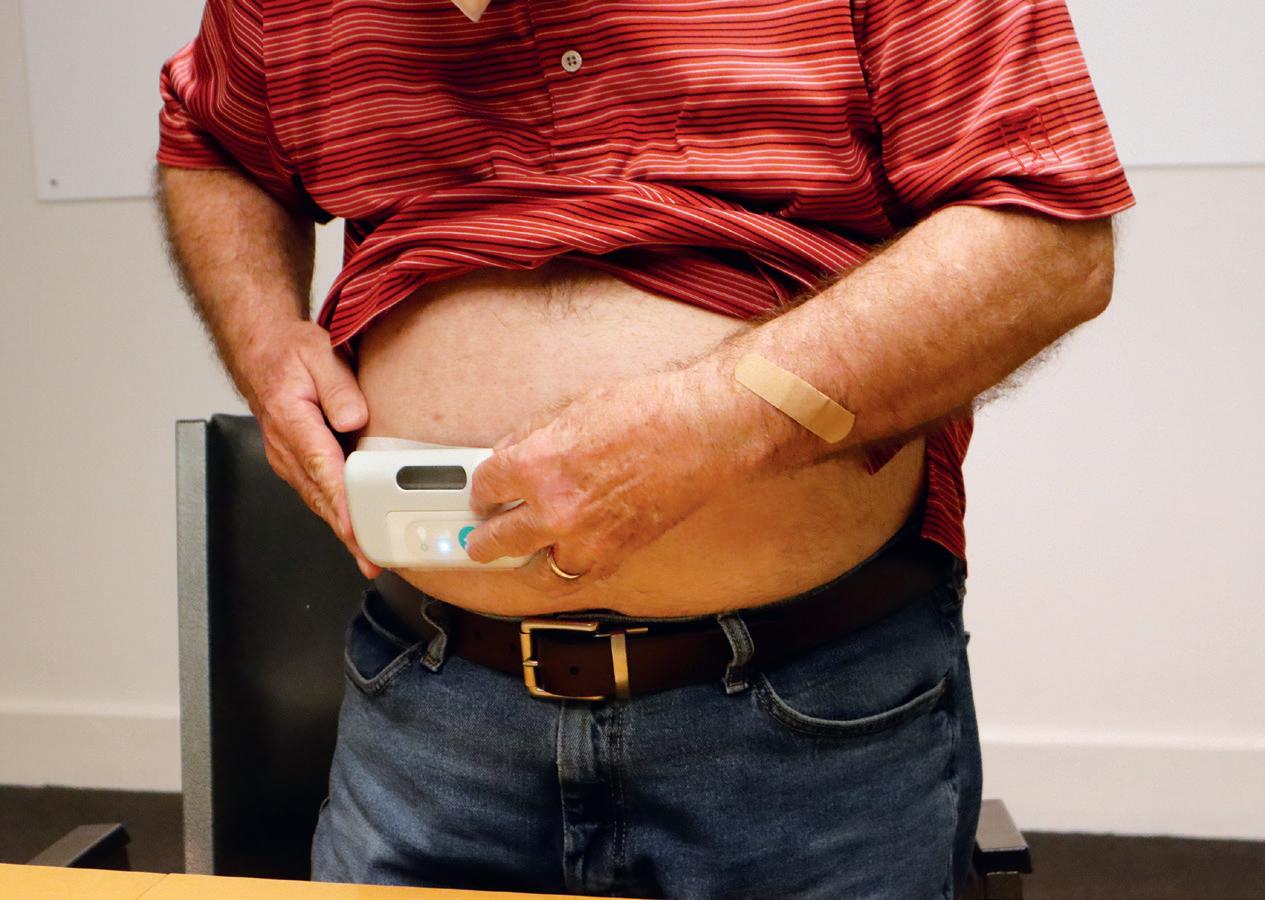
“The drug is delivered via a soft cannula, which is reminiscent of the tubing used in older devices and increases patient comfort.”
older devices and increases patient comfort. There is also an important feature that increases patient safety, whereby the drug
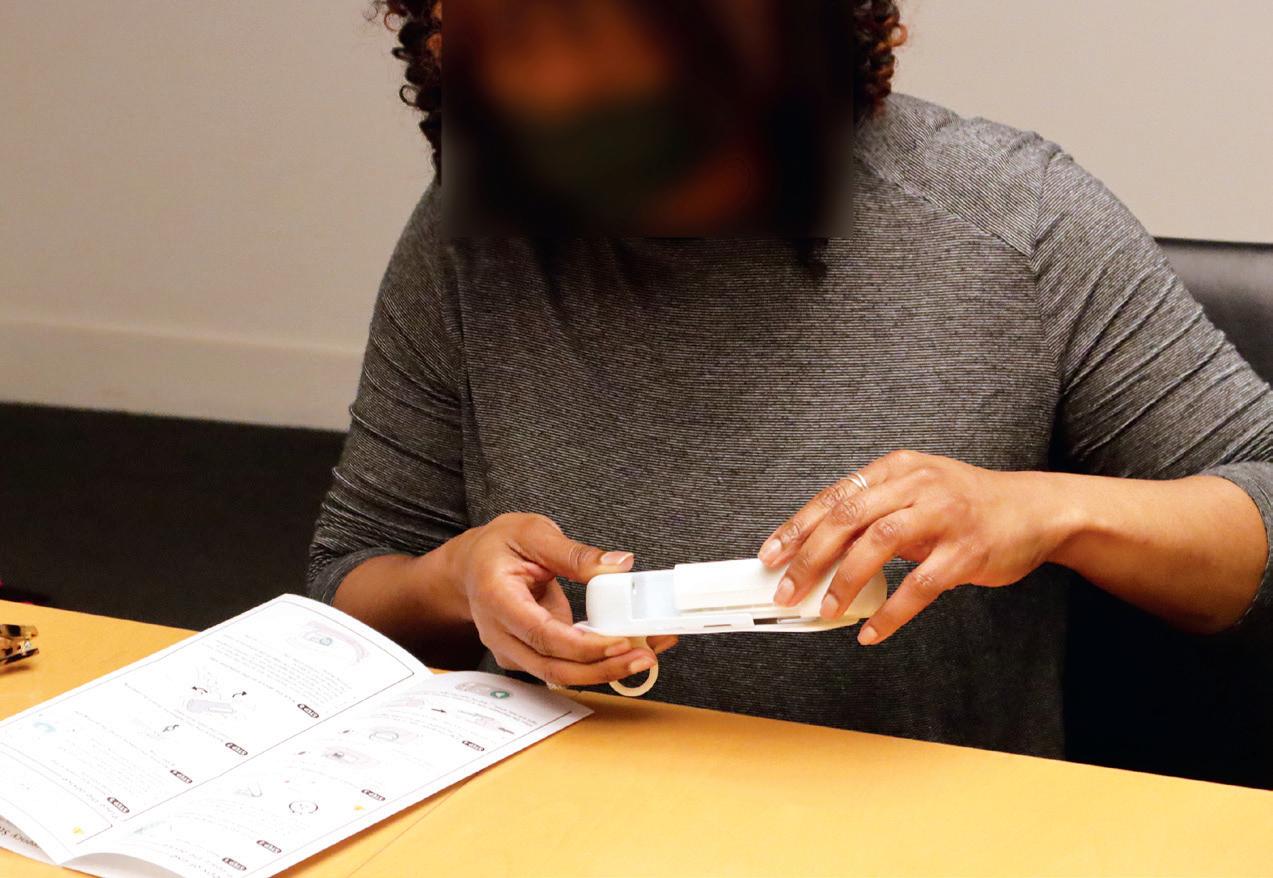
is not delivered if the device is not worn properly – this is expected to influence the clinical outcomes to follow a positive curve. This may also avoid high-value drug loss for pharma companies.
Being able to offer a seamless and fluid injection experience encouraged the design team to limit the number of buttons on the interface as well as to manage connectivity and software management remotely from an app or the cloud for the purpose of enhancing the patient’s engagement. To foster patient adherence, the device must not be too complicated to handle, and the guiding instructions must speak by themselves.
One of Nemera’s offerings is connected device UI/UX design. The company has a comprehensive understanding of user needs that informs the development process to determine how to balance development of the device, sensor systems, software and digital platforms to best support the user. Nemera applies this to the development of the device, the mobile application and software development, ensuring that requirements are driven by an understanding of user needs – balancing those with the capabilities of the technology. This design and engineering capability is used to deliver smart solutions that make a real difference to patients’ lives, including in combination with Symbioze® (Figure 4).
Although sterility and contamination are not an issue in other injection devices, they become a consideration for Symbioze® because of its reusability. How can the sterility barrier be ensured when assembling two separate parts? The design team had to overcome this challenge to avoid the manipulation of the primary drug container – a large-volume glass cartridge –by patients. The choice not to have the naked cartridge separated from its housing has been driven by Nemera’s wealth of experience in safety systems for prefilled syringes. Many of its pharma partners are offering high-value drugs in this format, so it is critical for self-injecting patients not to have to worry about correctly positioning the drug container.
“Nemera’s solution was to add a membrane at the crimping place to control the fluid path opening.”

Preserving the drug and its container has been a priority during the early phases of the platform development. Nemera’s solution was to add a membrane at the crimping place to control the fluid path opening. This solution has been validated through a series of tests (Figure 5), some of which were conducted with the help of the Hôpitaux Civils de Lyon (France), Lyon’s biggest public hospital network.
“By building on the platform’s solid foundation, Nemera can ensure that the Symbioze® platform is tailored to the specific needs of the target patient population, drug characteristics, delivery time and regulatory requirements.”
Overall, Symbioze® is a pure combination of the lessons learned from the history of injectable delivery devices and Nemera’s experience developing combination products. It is also an ideal representative of Nemera’s motto: “We put patients first”.
FROM PLATFORM TO MARKETED COMBINATION PRODUCT –THE VALUE OF PARTNERING WITH AN INTEGRATED SERVICE PROVIDER
Partnering with Nemera can simplify the process of integrating Symbioze® with a drug product, accelerating the development of combination products and expediting time to market while managing the complexities associated with developing on-body injectors. By building on the platform’s solid foundation, Nemera can ensure that the Symbioze® platform is tailored to the specific

needs of the target patient population, drug characteristics, delivery time and regulatory requirements. The Insight by Nemera development and consulting organisation provides comprehensive services and capabilities covering critical areas essential to the success of combination products:
• Functionality testing, performance testing, analytical services and design verification
• Human factors management and design validation
• IFU and packaging development
• Regulatory strategy and submission
• Drug/device assembly and packaging support.
Collaborating with an integrated partner offers several advantages, including a patient-centric approach that considers the customisation of the device and its supporting elements, such as IFU, packaging, digital experiences and training solutions to increase adherence and engagement.
Nemera recognises that navigating the complex ecosystem of combination products to achieve market success can be challenging. As such, its services are designed to align with the expectations of various stakeholders, including healthcare professionals, networks, payers and regulators. To address the challenges of drug delivery device development, Nemera applies its end-to-end expertise throughout
Cécile Gross is Marketing Global Category Manager at Nemera, focusing on parenteral devices. She oversees the product portfolio strategy, development and lifecycle for safety system, pen injector and on-body injector platforms. Ms Gross has more than two decades of experience in the medical device industry, marketing business-to-business technological products and implementing product lifecycle management for various kinds of devices. A graduate in International Business, she completed her initial training with a master’s degree in Marketing and Management in the Healthcare Industry at the IMIS Institute (Lyon, France).
Mark Tunkel is Global Category Director, Services, at Nemera. He was previously a partner at Insight Product Development, which was acquired by Nemera in 2019 and became the Insight Innovation Center. With more than 20 years of global business development experience and a deep understanding of the marketplace challenges and trends impacting the pharma industry, Mr Tunkel has advised many of the world’s leading companies on their product development and innovation strategies, with an emphasis on driving realisation and the most favourable business outcomes.
the process, ensuring consistent execution and minimising the risk of essential information being lost at different stages or when working with multiple partners. With its experience in managing complex user needs and regulatory requirements, Nemera can accelerate a project’s time to filings and market entry.
Ultimately, the value of Nemera’s integrated services lies in the flexibility they offer, allowing customers to focus on their core business of drug discovery and development. As a partner and extension of customer teams, Nemera delivers bestin-class solutions, ensuring no compromises are made during collaborations.
Symbioze® is a trademark of Nemera La Verpillière SAS.
Nemera is a drug delivery device solutions provider that designs and manufactures devices that maximise treatment efficacy. It is a holistic partner and works with its customers to ensure success in the sprint to market with its combination products. From early device strategy to state-of-theart manufacturing, Nemera is committed to the highest quality standards.
1. Kesavadev J et al, “Evolution of Insulin Delivery Devices: From Syringes, Pens, and Pumps to DIY Artificial Pancreas”. Diabetes Ther, 2020, Vol 6(11), pp 1251–1269.

* using Forest Stewardship Council® certified recycled paper, vegetablebased inks, biodegradable laminates and carbon balanced materials offset via the World Land Trust™ following ISO140001 processes.
** by DHL using GoGreen Plus carbon insetting of at least 30% through the use of Sustainable Aviation Fuel (SAF), a biofuel substitute for traditional jet fuel, produced from renewable sources. Mailed to individual readers outside the UK by DHL using GoGreen, which offsets 100% of CO2 emissions.

October 28 - 29, 2024 • Westin Boston
October 28 - 29, 2024 • Westin Boston Seaport, Boston, MA
Featured Speakers
Featured Speakers
Featured Speakers

Laura
Laura
Laura

Robert




•
•




Attendees
• 750+ Attendees from Pharma, Biotech, Drug Delivery, Academia, Investors and More
• 750+ Attendees from Pharma, Biotech, Drug Delivery, Academia, Investors and More
• 750+ Attendees from Pharma, Biotech, Drug Delivery, Academia, Investors and More
• Pharma Companies Address Drug Delivery Needs and Partnering Philosophies
• Pharma Companies Address Drug Delivery Needs and Partnering Philosophies
• Pharma Companies Address Drug Delivery Needs and Partnering Philosophies
• Partnering Opportunities including One-on-One Scheduled Meetings to Help Foster New Collaborations Aly
• Pharma Companies Address Drug Delivery Needs and Partnering Philosophies
• Pharma Companies Address Drug Delivery Needs and Partnering Philosophies
• 10 Tracks Covering a Wide
• 10 Tracks Covering a Wide Range of Drug Delivery Technologies
• 10 Tracks Covering a Wide Range of Drug Delivery Technologies
• 10 Tracks Covering a Wide Range of Drug Delivery Technologies
• 10 Tracks Covering a Wide Range of Drug Delivery Technologies
•
• Partnering Opportunities including One-on-One
• Partnering Opportunities including One-on-One

Scheduled Meetings to Help Foster New Collaborations
• Partnering Opportunities including One-on-One Scheduled Meetings to Help Foster New Collaborations
Scheduled Meetings to Help Foster New Collaborations


Smart and sustainable on-body injector platform to improve patients’ injection experience
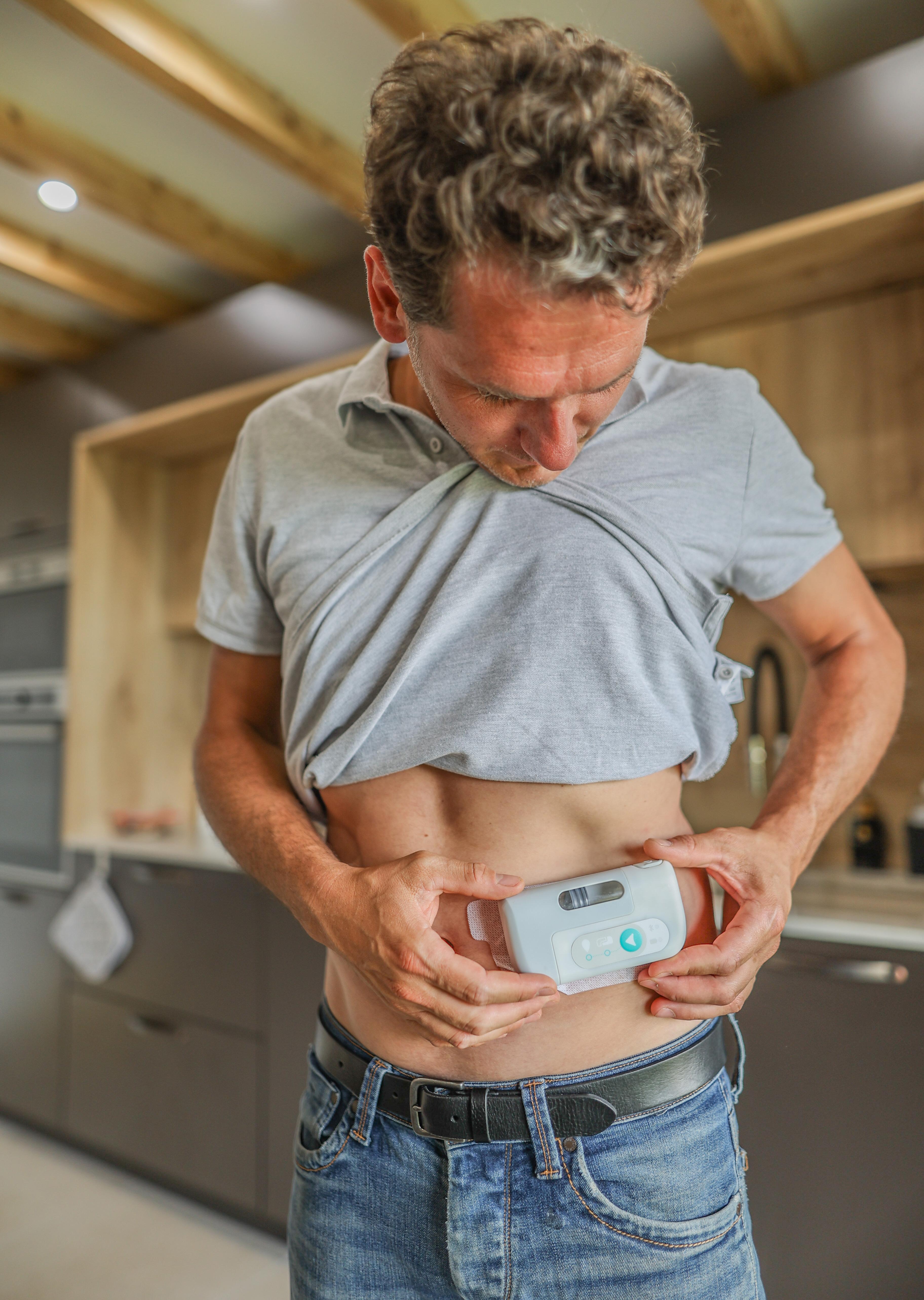

To know more about our global Parenteral offering
In this piece, Greg Moakes, Executive Vice-President New Business Development, and Tzach Sadi, Research Engineer, both at LTS Lohmann Therapie-Systeme, describe the process and benefits of automating the production process for its on-body injector device, Sorrel™.
From the athlete striving for marginal performance gains to the business seeking energy consumption savings, the notion of continual improvement is a prerequisite for sustaining progress Within manufacturing environments, this philosophy has long been crystallised in the “Kaizen” approach, which emerged in the 1980s as an articulation of a series of tactical methods used by businesses in Japan (most notably Toyota) to enhance their efficiency, value and effectiveness. Continual improvement can provide the means to address particular issues and difficulties, such as downtime and delays. Alternatively, it can provide a platform to unlock previously hidden enhancements in areas such as quality and speed.
The same is true of drug delivery device manufacturing. In this world, the stakes for continual improvement are extremely high, not only in terms of ensuring optimal quality but also regarding “future proofing” the supply chain in the face of the growing demand, which, today, is driven in large part by increasing patient preference for on-body solutions.
The philosophy of constant improvement is embedded in LTS’s thinking across product design, development and manufacture. This was the ultimate driving force behind the company’s ambition to enhance the production process for the on-body injector (OBI) configuration of the Sorrel™ platform. LTS believes that the introduction of greater levels of automation
“The philosophy of constant improvement is embedded in LTS’s thinking across product design, development and manufacture.”
into a manually driven process can facilitate increases in capacity, process quality and resilience while reducing downtime and waste.
The Sorrel™ device occupies a valuable space in the on-body delivery system landscape. The beating heart of the platform is the software-controlled electromechanical pumping system, which can be programmed with the desired infusion profile. This is true of both the recently commercialised point-of-care loaded OBI, as well as the vial and container compatible, prefilled and preloaded 5–20+ mL device, currently in development with multiple pharmaceutical partners (Figure 1).
The platform’s underlying technology allows the device to deliver multiple benefits for both patients and pharmaceutical partners alike. For patients, and particularly those requiring frequent dosing of injectable therapies to manage long-term conditions,

Greg Moakes
Executive Vice-President
New Business Development
T: +1 214 425 5733
E: greg.moakes@ltslohmann.com

Tzach Sadi
Research Engineer
T: +972 547 515718
E: tzach.sadi@ltslohmann.com
LTS Lohmann Therapie-Systeme AG
LTS Device Technologies
29 Yad Harutzim St PO Box 609
Netanya 4250529
Israel
www.ltslohmann.com
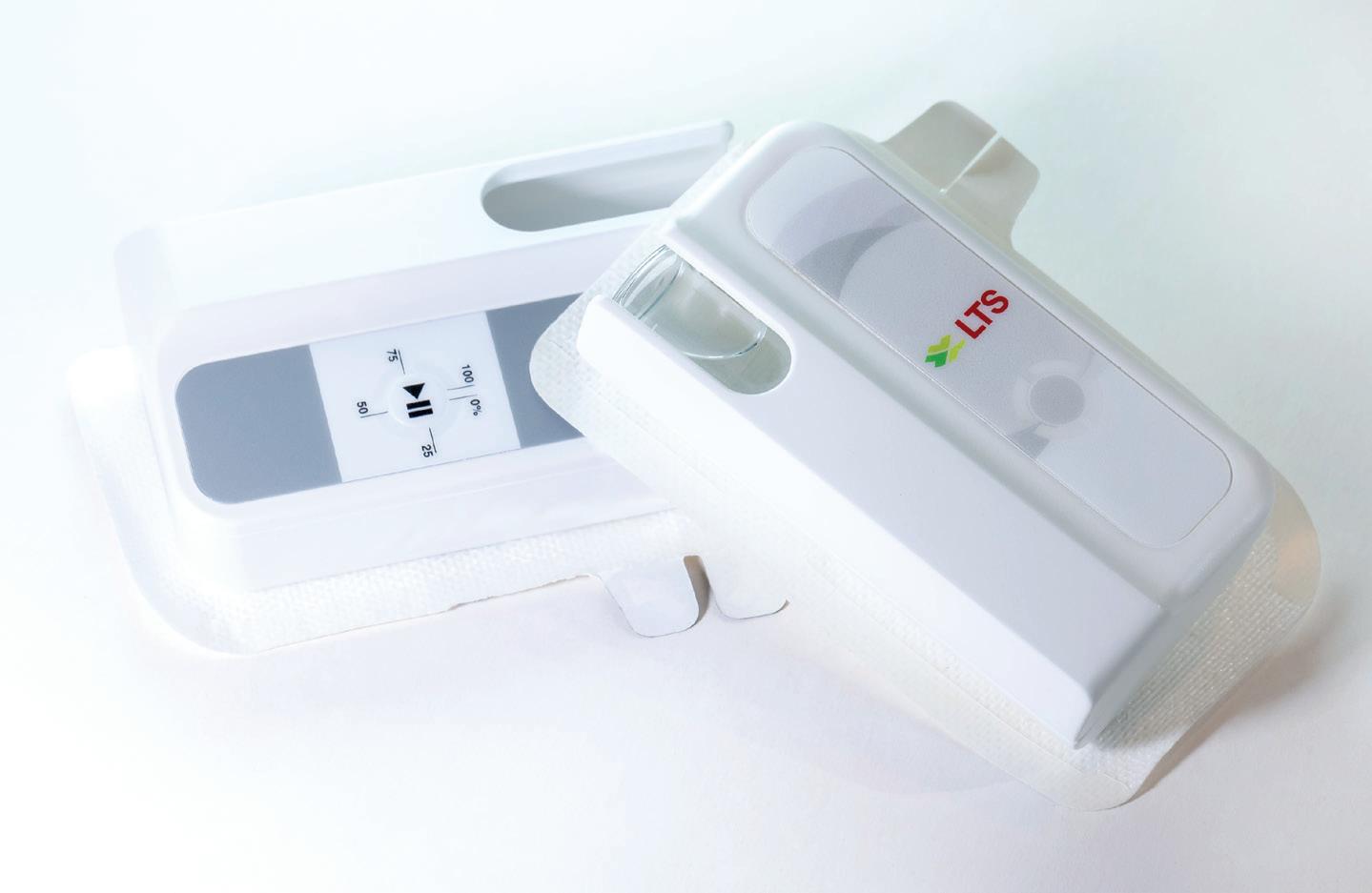
Sorrel can provide automated drug delivery of high-volume and viscous therapies via the convenience of a wearable device. Coming preloaded and prefilled, the device is intuitive to use, with no requirements for the patient to perform additional interim steps while administering an injection. Sorrel™ also encourages patient confidence in the process through the incorporation of audio and visual indicators to signify injection success.
For pharmaceutical partners, the benefits of the Sorrel platform are multitudinous. The fact that the device can incorporate standard vials as well as cartridges simplifies and accelerates the development process, while also maximising compatibility with established filling processes. Additionally, the potential to configure Sorrel for proprietary cartridges via minor adjustments to its outer casing offers additional flexibility. Whether using vials or cartridges, Sorrel simplifies loading by including a disinfection chamber with an integrated UV-C LED, which prepares the primary container’s septum before engagement with the device’s fluid path.
These well-established benefits are built on the strengths of Sorrel’s optimised product design, and further opportunities for optimisation have been identified in its manufacture. In theory, introducing greater levels of automation into the device’s manually driven production processes would secure increases in capacity, process quality and resilience
while reducing downtime and waste. These valuable outcomes support the forward momentum within the LTS Device Technologies business, as exemplified by the previously referenced development projects and the 2024 commercialisation of the Sorrel OBI device.
Despite deciding on a move to semiautomated production, LTS’s intention was to ensure that the design, assembly methodology and process controls for the Sorrel device remained consistent throughout the transition. In view of this, the challenge centred on maintaining the current assembly methodology while designing and implementing automationbased process improvements that would result in the anticipated production gains. More specifically, this meant targeting a
“LTS’s flexible changemanagement strategies ensured project continuity in the face of any potential operational or logistical challenges.”
production capacity of at least one part per 40 seconds and, in terms of quality, introducing better traceability for rejected non-conforming subassemblies/parts, as well as bringing in automated decision making for inspection procedures. At the same time, LTS’s flexible changemanagement strategies ensured project continuity in the face of any potential operational or logistical challenges.
At a strategic level, the move from manualbased operation to semi-automated operation was pursued for several reasons, including the ability to achieve higher throughput because of extended periods of continuous operation. In addition, automation allows for complex operations to be accelerated and tasks to be performed at a level that reliably delivers a high degree of accuracy and consistency. Operatives continue to be integral to the process but, supported by automation, weaknesses associated with human error are reduced and output is enhanced (Figure 2).
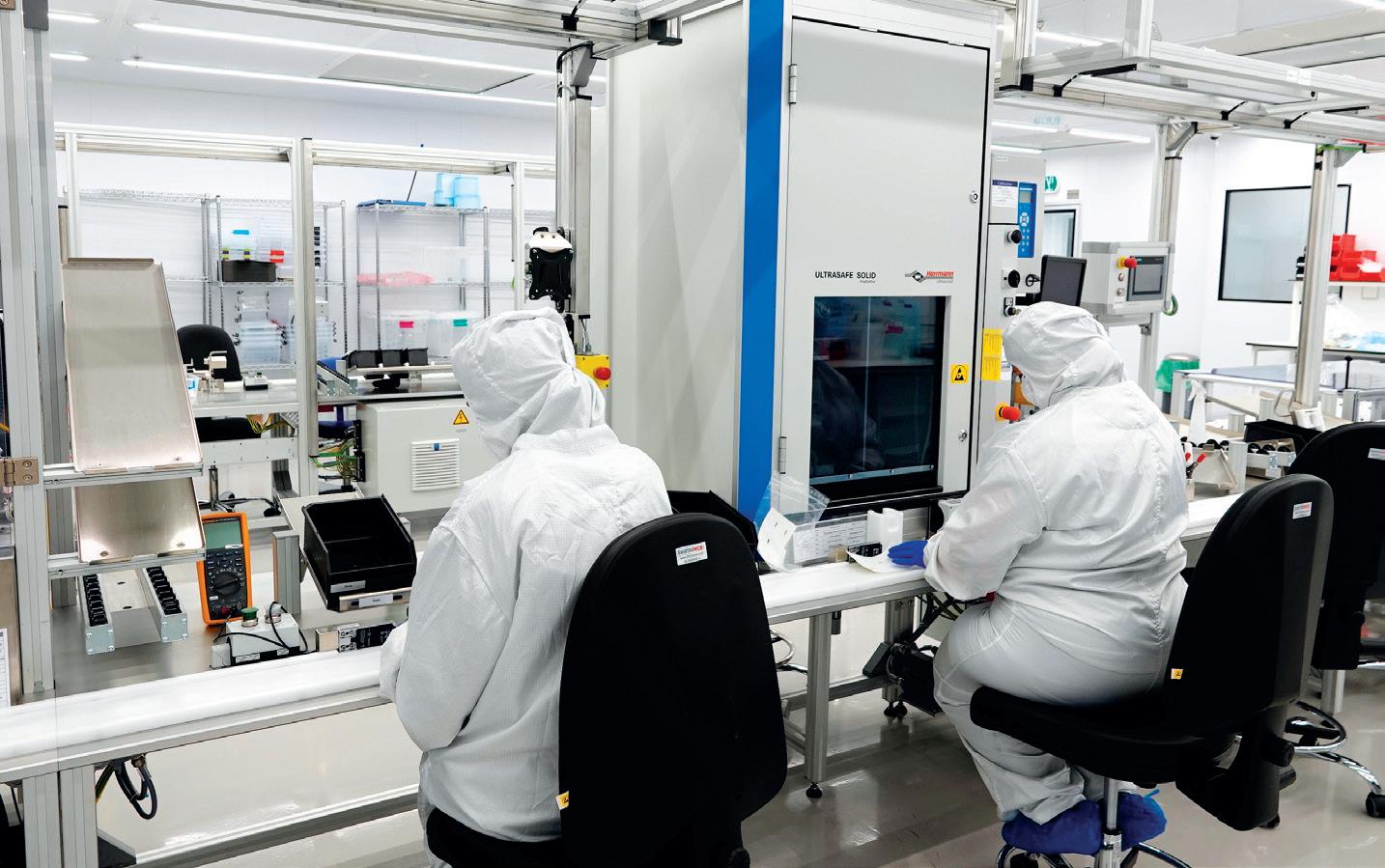
Having identified the opportunity to realise process benefits – and therefore business benefits – by moving to a semiautomated production line, the next phase involved defining these targets in more detail. This encompassed setting objectives for production capacity, as well as listing expected improvements to existing processes and process controls.
Once established, these objectives were translated into a series of technical requirements that formed the process specification for LTS’s sub-contracting partner, teamtechnik (Freiberg, Germany), which was then tasked with implementing the semi-automated production line. The next phase of the project encompassed system design, build and installation, which incorporated factory acceptance testing and then, later, site acceptance testing at LTS to validate the installation and configuration of the machinery according to the previously defined specification.
Following the successful completion of these assessments, LTS was able to conduct pilot tests to assess the performance and reliability of the semi-automated systems in a run-up phase. This period was essential for troubleshooting any postinstallation issues that had arisen, while also allowing any further opportunities for process improvement to be identified prior to full-scale implementation. Finally, the transition to the semi-automated production line was confirmed via process validation, with completion of all associated documentation (Figure 3).
As expected with any process driven by continuous improvement, the implementation of the system was regarded as only the beginning of a new phase, ensuring that it continues to benefit from ongoing optimisation. A key challenge in this phase is the identification and definition of required maintenance procedures, with a view to limiting unnecessary downtime and controlling any planned interventions. In such a complex system, containing a multitude of moving parts, maintenance is inherently complex. There are interdependencies between components to consider, making it essential to take a holistic view of the entire production line to avoid making any changes that trigger an unwanted domino effect. Furthermore, the task of creating accurate, detailed documentation


covering all aspects of such a system becomes far more extensive and onerous. In addition, it is critical to consider the availability of replacement parts, adherence to safety procedures during maintenance and cleaning operations, and integration with computerised maintenance management systems to streamline scheduling, tracking and reporting.
And, while integrating the new system with IT processes is crucial to operational success, this also depends heavily on successful integration with the workforce tasked with controlling and managing the system on a daily basis, as well as supporting its development over time. At the design stage, this means thinking
about the direct interface between the two, with the ergonomic needs of the workforce incorporated into the resulting equipment installation (Figure 4).
Building the team’s capabilities was also a crucial part of the transition from manual to semi-automated production. Employees were given comprehensive training on the system itself, providing them with a thorough grounding on the technology. This was supplemented by continuous learning opportunities to ensure that they were kept up to date on any technology and process developments. In parallel, engineering specialists were provided with the knowledge to troubleshoot issues and support operational continuity.
In the final stages of implementation, a comprehensive process-validation programme had to be carried out and documented. Completing this step is not only a regulatory requirement but also ensures that all aspects of the system comply with expected standards, and that the processes combine to produce products that meet the defined specifications reliably.
In medical device manufacturing, guidance on process validation for quality management systems is provided by the Global Harmonization Task Force. This documentation has supported manufacturers in carrying out process validations for more than two decades, and provided LTS with an authoritative reference for all key activities that are encompassed within this critical stage. As per the guidance, the overall intention is to verify that, taken as a whole, the production process “has been subject to such scrutiny that the result of the process can be practically guaranteed” and that when operated within specified limits it “will consistently produce product complying with predetermined requirements”. Process validation covers three main phases (Figure 5):
• Installation qualification , which demonstrates that the equipment has been correctly installed and calibrated according to the manufacturer’s specifications.
• Operational qualification , which demonstrates that the process produces acceptable results and allows parameter limits to be set.
• Performance qualification , which demonstrates long-term process stability under the strain of a large manufacturing load.
These priorities were all incorporated into a master validation plan along with processes for computerised software validation and validation of testing methods. If any of these validation processes generated data outside of the target range,

corresponding updates were made to the process and functional specification to correct the situation. Further validation testing would then be conducted until this feedback loop was closed. Finally, the system was subject to process performance qualification to demonstrate its capability in consistently outputting products that meet the quality specifications.
The extent of the entire processvalidation stage, which took only ten months to complete, highlights the delicate nature of adopting change in pharmaceutical manufacturing environments. In this instance, LTS’s ambition was not to change the existing assembly methodology or in-process controls, yet still the project represented a significant undertaking.
Through strong collaboration and a process-driven approach, the achievement of transitioning from a manual to a semiautomated production line has delivered important benefits in line with LTS’s initial target objectives, including enhanced quality of output, improved consistency in production and the ability to produce
“Through strong collaboration and a process-driven approach, the achievement of transitioning from a manual to a semiautomated production line has delivered important benefits in line with LTS’s initial target objectives.”
a device every minute. LTS has also been able to identify potential future changes that could double or possibly triple its productivity, and these will be implemented over the coming months and years as the company continues on a path of continual improvement.
As it stands today, however, LTS is now equipped with a fundamentally optimised production-line blueprint that is ready for global deployment. This builds neatly on
the synergy that has already arisen from the LTS Lohmann acquisition of Sorrel™ in terms of positioning the device as a truly international device platform. Indeed, a project is already underway to establish worldwide manufacturing capability for Sorrel via multiple geographical production locations.
Change is often regarded as an unsettling force but, by trusting in continual improvement and pursuing a carefully implemented change-management process, LTS has been able to realise manufacturing enhancements that will not only benefit its existing and prospective international partners but also individual patients across the world who rely on wearable devices to alleviate the pressure of managing chronic conditions.
LTS Lohmann is a technology partner for the pharmaceutical industry that develops and manufactures innovative drug delivery systems, including transdermal patches (TTS), oral thin films (OTF) and wearable
drug delivery devices. LTS’s commercial offering encompasses more than 20 marketed products and a diverse pipeline of more than 40 development projects targeting multiple disease indications. LTS’s innovation pipeline contains both partnerfunded and proprietary LTS-funded projects. LTS maintains its market position through the continuous refinement of its core TTS and OTF technologies and by advancing emerging drug delivery
technologies, including micro-array patches for the transdermal delivery of large-molecule biological actives. With its Sorrel wearable drug delivery platform, LTS offers patient-friendly solutions for complex drug delivery. Founded in 1984, LTS operates from four sites: Andernach (Germany), West Caldwell (NJ, US), St. Paul (MN, US) and Netanya (Israel). LTS has also a representative office in Shanghai (China).
Greg Moakes is Executive Vice-President of Business Development for LTS Lohmann Device Technologies. Mr Moakes holds a PhD. In Chemistry from the Georgia Institute of Technology (GA, US) and an MBA from Southern Methodist University (TX, US). His career had been focused on drug delivery, first specialising in solid implant dosage formulations and more recently high-volume subcutaneous delivery via on-body delivery systems.
Tzach Sadi is a Research and Development Engineer at LTS Lohmann Device Technologies. Mr Sadi holds a BSc in Biomedical Engineering and previously served as a verification and validation engineer. His career has been focused on the medical device industry, specifically in developing drug delivery solutions.







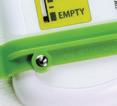

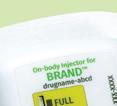

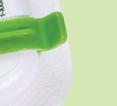





In this article, Leonard Chu, PhD, Deputy Director at Altek, presents the Alby injection platform and highlights its versatility as a delivery platform for large-volume subcutaneous injections.
Over the past few years, interest in largevolume delivery by self-administration has increased, with a growing number of large-volume subcutaneous (SC) injectables having been commercialised – whether the drug was originally formulated as a largevolume SC injectable or was converted from intravenous injection to SC injection.
FOR LARGEVOLUME ON-BODY DELIVERY
Wearable injectors play a key role in the self-administration of large-volume drugs (defined here as 3 mL or greater), which leads to the question of what to look for in a wearable injector that would increase value to the stakeholders. For patients, device safety, usability and price are important. For pharmaceutical companies, speed to market, risk management, drug compatibility, safety, clinical outcomes
“By considering the needs of various stakeholders, a smart wearable injection platform may provide a solution to large-volume on-body delivery.”
and the availability of fill-finish lines are some of the top considerations. And for device companies, quality, cost, regulatory compliance and manufacturability are some of the key considerations, to name a few. By considering the needs of various stakeholders, a smart wearable injection platform may provide a solution to largevolume on-body delivery.
THE ALBY INJECTION PLATFORM – DOES “ONE SIZE FIT ALL”?
Altek’s Alby was designed as an injection platform intended to cover a wide range of large-volume on-body delivery needs (Figure 1). However, does the concept of “one size fits all” apply to Alby? Fundamentally, Alby shares the same concept and many identical parts across the different models in the platform. As a result, Alby can easily adapt to a different set of delivery requirements by only making the essential changes, with minimal impact to the overall architecture. Let us take “delivery volume” as an example. A standard 10R vial-based injector that covers a delivery volume range of 5–10 mL can easily be reconfigured into a 20R injector covering 11–20 mL by simply changing the size of the device housing while keeping the majority of components unchanged. In other words, pharmaceutical partners can harness the versatility of Alby to achieve

Dr Leonard Chu
Deputy Director
T: +886 3578 4567 Ext. 6309 E: leonardchu@altek.com.tw
Altek Biotechnology Corporation No. 12, Lixing Rd. East Dist. Hsinchu City 300094 Taiwan (ROC) www.altekmed.com
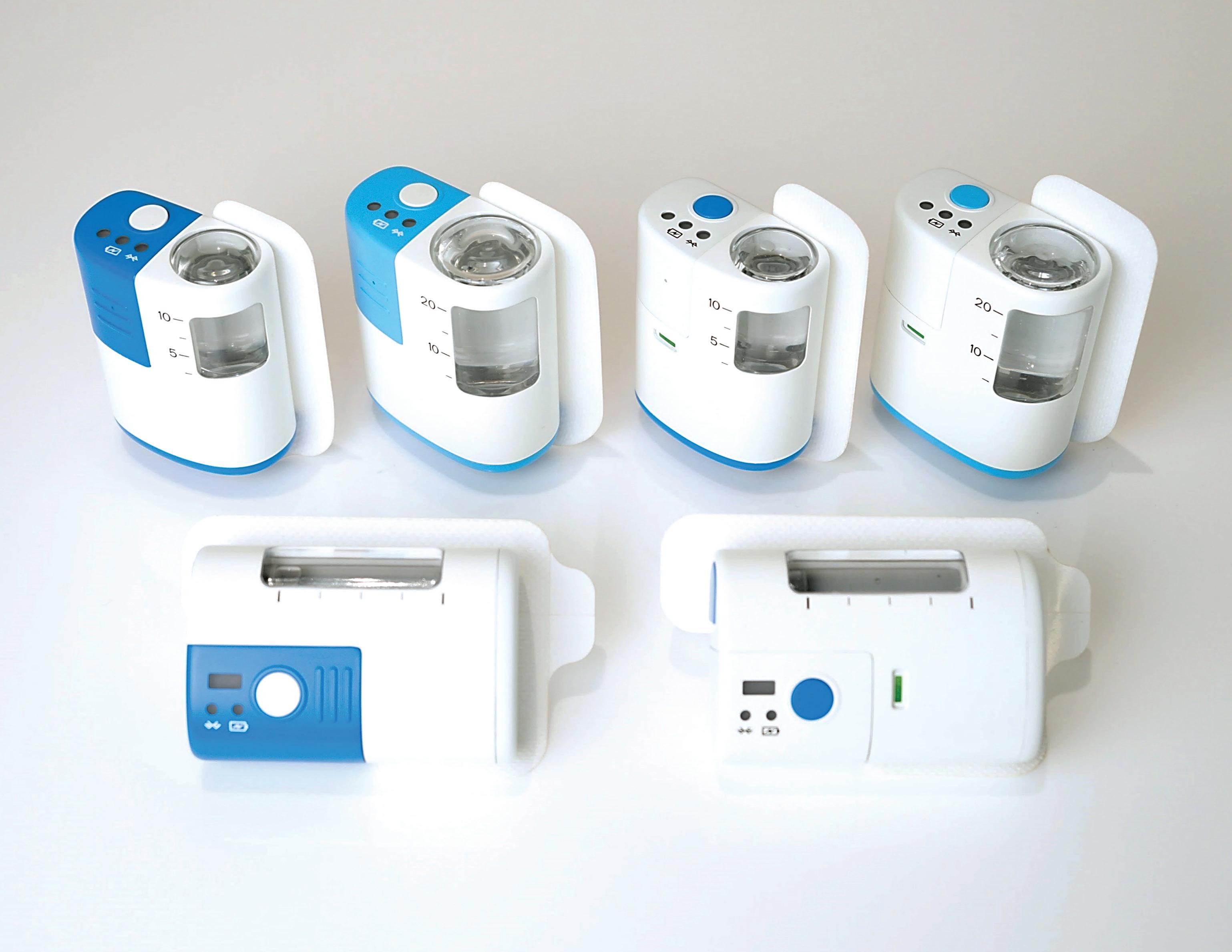
a more efficient development timeline and a lower development cost across different drug candidates in the pipeline.
Any delivery requirements beyond the pre-assumed specification range can be discussed on a case-by-case basis, including customisation options. Despite the commonality offered by the platform concept, Alby injectors have plenty of room for branding and differentiation.
Cartridges are commonly seen in selfinjection devices such as autoinjectors or pen injectors. On the other hand, while glass vials are the most commonly used containers for packaging pharmaceuticals, they are rarely integrated into self-injection devices. For the self-administration of large-volume drugs, Alby is designed to accommodate both container types.
Prior to injection, users need to load the container into the injector. There are several benefits to this “plug and play” concept. First, users can access and clean the stopper or septum of the container for disinfecting the container stopper-piercing needle
“The design of Alby avoids the need to perform drug transfer from the primary container to a secondary reservoir inside or outside the device, especially when dealing with vials.”
interface. Second, no refrigeration is required for the transport and storage of the devices, thus lowering the cost of the logistics value chain. The design of Alby also avoids the need to perform drug transfer from the primary container to a secondary reservoir inside or outside the device, which is especially valuable when dealing with vials. Eliminating drug transfer further reduces the risk of user handling errors and the cost associated with drug transfer systems. Furthermore, Alby does not have a secondary reservoir that would require additional drug compatibility studies.
Electronics technology enables numerous functions and capabilities that are critical to injection device safety and performance. Taking advantage of the electronics
technology, Alby is a versatile delivery system that can perform SC injection in a controlled manner, provide detailed information about dosing status and enable key safety features that prevent device misuse. One example of this versatility is the electromechanical drive system, which can generate a specific dosing profile based on a combination of pre-programmed delivery rates and dosing intervals. The data generated from the use of the injectors can also be stored and shared anonymously with users and healthcare professionals (HCPs) for enhanced safety and disease management.
The user interface of Alby is designed for simplicity, as shown in Figure 2. Upon placing the injector on the body, there is only one visible button to start the delivery. There are three LED lights that provide the visual signals, each with a distinct purpose of informing users

about the delivery status, the battery status or the Bluetooth connectivity status. In addition to the visual feedback, all Alby injectors have an internal speaker that provides an auditory output.
Electronics have already become affordable to the general public thanks
Vial and Cartridge Injectors
to the advancement of technology. Electronics-enabled features, such as the drive system, safety reminders and other dummy-proof functions, could replace or reduce some of the single-use plastic components that would otherwise fulfil those functions. The reusability of
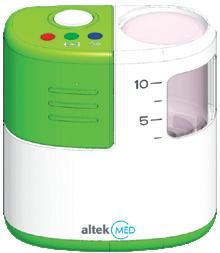
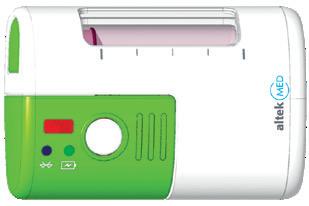
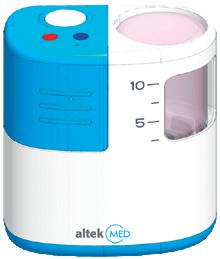
“The reusability of electronic parts could therefore have the potential to drive the “cost per injection” significantly lower.”
electronic parts could therefore have the potential to drive the “cost per injection” significantly lower.
Although the versatility of Alby offers a wide selection of injector models, which model best meets the dosing needs? To assist the decision makers, a radar chart is provided for each injector model that is designed to address a specific range of dose frequency. Table 1 compares the attributes (manufacturability, time
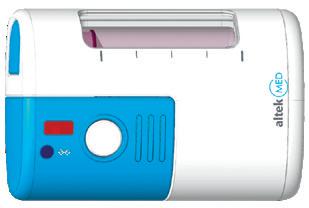

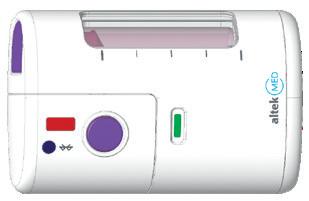



to market, cost savings per injection, sustainability and ease of use) between three Alby injector models: Alby-M-R, Alby-M and Alby-S. This analysis only serves as a guideline for choosing a suitable injector model, rather than an instruction for selection.
• Alby-M-R: A multi-use rechargeable device that consists of a reusable unit and a disposable unit designed for highdosing frequency (i.e. ≥1 dose/week), providing the best value for the lowest cost per injection and the least amount of medical waste
• Alby-M: A multi-use device that consists of a reusable unit and a disposable unit designed for a moderate-dosing frequency (i.e. once every two weeks to three months), allowing a balanced benefit from great usability to a lower cost per injection
• Alby-S: A single-use, fully disposable device designed for long-acting drugs with low-dosing frequency (i.e. once every three months or longer), giving excellent usability and the fastest time to market.
When it comes to evaluating the feasibility of an injection device, dose accuracy is identified as a key performance function according to ISO 11608-1:2022, EMA guidelines and US FDA Guidance for Industry.1–3 The purpose of performing in-use tests under different atmospheric conditions is to ensure that the dose accuracy is kept within the target of ±5% for large-volume delivery, as users may experience some variation of temperature while wearing the devices.
Alby’s vial-based wearable injectors were selected as the test model and were subjected to cool, standard and warm
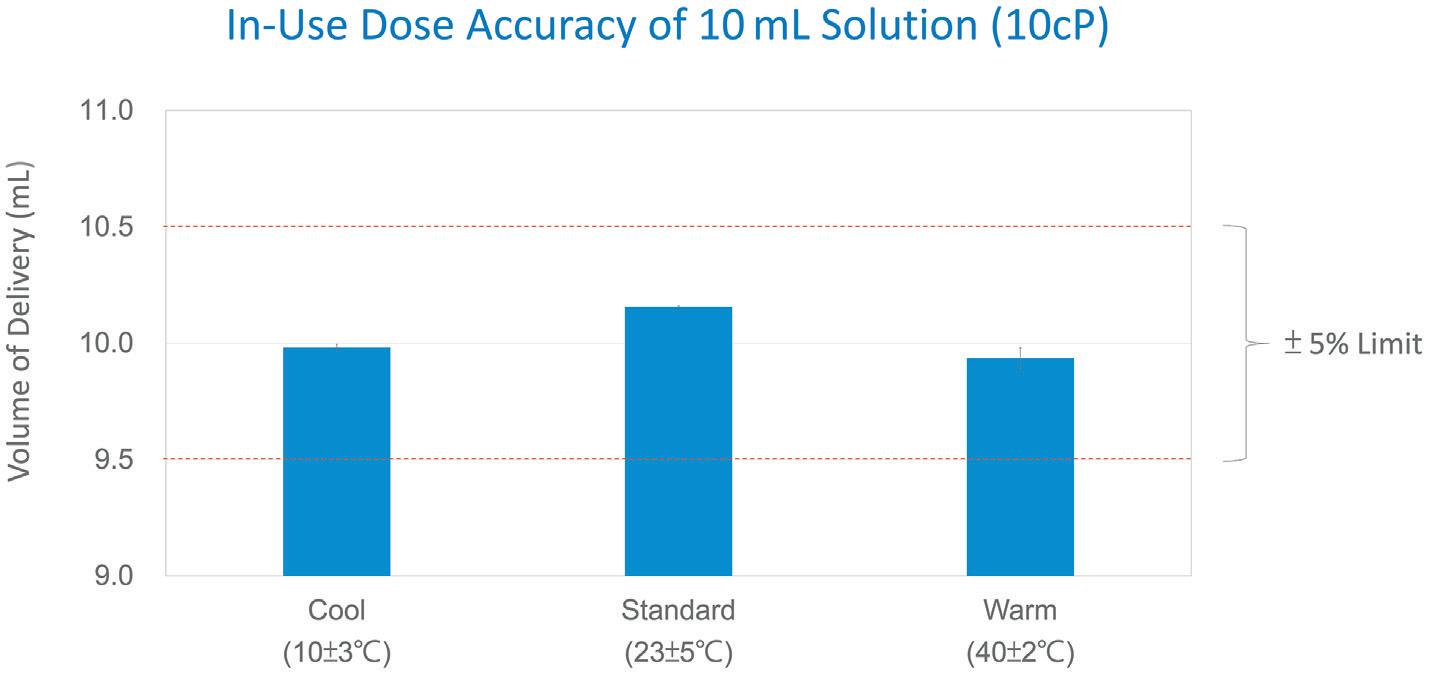
atmospheric conditions (N=5). The dose accuracy tests were based on the delivery of 10 mL of a 10 cp sucrose solution into the air from a 10R standard vial.4 The delivery rate was set to approximately 2 mL/min. The injectors, along with the vials, were preconditioned in the test chamber under cool (10˚C ± 3˚C) or warm (40˚C ± 2˚C) conditions, with the humidity set at approximately 50%. For the standard atmosphere condition (23˚C ± 5˚C), the tests were conducted in an office environment with air-conditioning. Delivered sucrose samples were collected and weighed. As shown in Figure 3, the dose accuracy of 10 mL delivery at various temperatures was kept well within 5%.
The injection time was also reasonably precise within ±30 seconds for a 10 mL delivery of a viscous solution. Here the term “reasonably precise” in the context of injection time is a subjective judgement when comparing the time variation of Alby injections with the assumed time variation of manual injections by HCPs (actual data are not available).
In addition to in-use testing in cool, standard and warm atmospheres, dose accuracy tests were performed using different solutions of different viscosities.
Other functional tests included needle insertion and retraction, alarm systems with visual and audio feedback, and various device safety features. These laboratory tests generated supporting evidence for the feasibility of the Alby injection platform, and more tests are being conducted to increase confidence in the device design, usability and manufacturability.
Wireless connectivity is gaining relevance in the field of drug delivery. The covid-19 pandemic has accelerated the growing acceptance of self-administration. However, self-administration without connectivity is like using a computer without an Internet connection – while the primary tasks
“Alby injectors are smart devices featuring connectivity such as Bluetooth or near-field communication.”

of delivering a drug can be performed, valuable information regarding device performance and patient compliance cannot be effectively stored and shared for disease management.
To enable telemedicine coupled with self-administration, Alby injectors are smart devices featuring connectivity such as Bluetooth or near-field communication. As shown in Figure 4, Alby’s vial-based injectors have successfully demonstrated wireless functionality by transferring the history log of the dosing process to an Android demonstration app via Bluetooth. The device’s function and performance metrics were captured and transferred to the app, including the sequence of operation, exact timing and the corresponding device operation, such as device activation, start of delivery, progress of delivery, end of delivery or an error report. Other device operations not shown in Figure 4 can be written in the history log according to the design requirements.
To protect patient privacy, the data can be recorded in an anonymous manner where only authorised HCPs can match the data to the patient. Besides logging the dosing data for an enhanced selfadministration and disease management experience, the app could also send reminders to patients before it is time to receive the injection. With the aid of connectivity, Alby can offer a more informative and interactive experience to users and HCPs.
Alby is a versatile injection platform that can deliver large volumes of drugs, connect wirelessly via Bluetooth and accommodate different types of primary containers without the need for drug transfer. In other words, Alby could serve as a starting point for one drug candidate and extend to others with minimal

customisation, which reduces both time and cost of development and commercialisation. The platform’s accurate dosing at different temperatures provides further support for the feasibility of Alby.
Alby, as both a large-volume delivery enabler and a pharmaceutical product differentiator, is now ready to be combined with real drug candidates to validate its performance in preclinical studies, and subsequently clinical trials and commercial use.
Altek Biotechnology Corporation designs, develops and manufactures medical devices with a global footprint across Taiwan, Singapore, Malaysia and China. Altek provides solutions and services with a proven record of product development and manufacturing, covering product
Leonard Chu, PhD, Deputy Director at Altek Biotechnology, holds a doctoral degree from the Georgia Institute of Technology (GA, US), focusing on developing dissolving microneedles. Dr Chu has a diversified industry experience, serving in both technical and project management roles. Dr Chu has led customer projects from the design phase to validation phase, involving fully automated assembly. Currently Dr Chu leads a product development team to develop a portfolio of smart injection devices, including autoinjectors, pen injectors, precision dosing on-body injectors and largevolume wearable injectors. Dr Chu is also responsible for marketing and combination product portfolio management.
design, verification, validation, programme management, regulatory support, certified quality systems, GMP facilities and automated manufacturing. Altek specialises in electromechanical design with a combination of mechanical, electronics, optics and software expertise. Altek’s key products include endoscopes and smart injection devices, such as autoinjectors, pen injectors and wearable injectors that are enabled with wireless connectivity.
1. “ISO 11608-1:2022. Needle-based injection systems for medical use –Requirements and test methods –Part 1: Needle-based injection systems, fourth edition”. International Standards, 2022.
2. “Guideline on the quality requirements for drug-device combinations (draft), 2019”. European Medicines Agency (EMA).
3. “Guidance for Industry (draft guidance): Essential Drug Delivery Outputs for Devices Intended to Deliver Drugs and Biological Products”. US FDA, 2024.
4. Swindells JF et al, “Viscosities of Sucrose Solutions at Various Temperatures: Tables of Recalculated Values”. Supplement to National Bureau of Standards Circular 440, 1958, pp 2–7.
